| 287. The Building at Dornach: Lecture V
12 Oct 1914, Dornach Translated by Dorothy S. Osmond Rudolf Steiner |
|---|
| 287. The Building at Dornach: Lecture V
12 Oct 1914, Dornach Translated by Dorothy S. Osmond Rudolf Steiner |
|---|
We spoke yesterday of the way in which the impulses of Will, Feeling and Thinking in man are brought to expression in our Building. It will be apparent to you from many things that have been said here recently that the art in our Building must contain a new element that has not hitherto existed in the evolution of art but is essential for the further progress of humanity. Admittedly it will be difficult from a purely external point of view to understand the real aim of this Building. A person may say to himself: I really can make nothing of it—and according to the standard of what he has hitherto regarded as artistic he will naturally have criticism to make. But remember, any new impulse in human evolution has always been criticised when it is judged according to the standards of the past. It will help us to understand the point here if we try to find a formula to express what is entailed by this renewal of the principle of art through the anthroposophical conception of the world. When we review the development of art, we can think of the architectural forms produced by mankind, either in the original Egyptian, Greek or Gothic architecture, or what represents the renewal in a later age of what was there in an earlier one—I mean the Renaissance. We can also think of sculpture, painting, and so forth. If we compare the effect made upon us by the essential character of these arts with what is aimed at in our Building, we can say; Everything that has been brought into being hitherto is like something in repose which, for us, has been wakened to life. Picture a human being in some fixed position. Somebody comes along and speaks to him - and he begins to walk, to move! This might well apply to the evolution of art up to our own day. We can regard it as something in repose, to which we would fain speak the magic word which rouses it into inner life and activity, into movement. This is what we want to achieve, because it is demanded by the impulses of transition which are at work in our time and call upon us to find a new impulse for the future evolution of humanity. To take an example, let us think of a beautiful Greek building. Its essential character consists in the symmetrical structures which mutually bear and support each other, just as the limbs of a human being standing immobile bear and support each other—but everything is at rest. Compare this with what we have aimed at in our Building. In time, of course, everything will develop, for we have been able to make only very primitive beginnings with the means and help available to us, In the Building we have movement from West to East; we have motifs which grow, as it were, from the simple forms to be seen in the West in the capitals and architraves into greater complication, and then become more inward and simpler again towards the small cupola. What was formerly a merely inorganic principle of symmetry has been brought into movement. What formerly was at rest is now in movement. This will have to come to expression in the painting—as far as it is possible in our age to achieve what must be the goal. In painting there are two poles. The one pole is that of drawing, the other that of colour, Fundamentally speaking, there are these two poles in all painting. Now a person may be a wonderful draftsman—that is to say, he may have the gift of reproducing in the lines he draws the inner form-quality of his subject, so that a picture of this form-quality is evoked by the drawing. Now we must be clear that anyone who concentrates on the actual drawing in a painted picture must inevitably be very one-sided in his relation to the Real—or, as is often said, to Nature. Nature does not work with lines only, but has far richer means for giving expression to what is inherent in a living being. Hence the painter or the draftsman, when he is inwardly moved by his subject, must express more in his lines than Nature is able to bring to expression in lines. But we shall never be able to avoid feeling that drawing in itself is nothing more than a substitute for what Nature can achieve. Whatever we may be capable of expressing through drawing, we can never produce anything that surpasses Nature; we cannot even equal Nature. Whatever we aim at in this respect must always remain a bungling attempt, for the simple reason that with the far richer means at her disposal, Nature is able to bring to expression the inmost essence of her creations. On this account, drawing can never be anything more than an auxiliary. And I believe that one who is a true draftsman will always feel that in drawing he is only producing something like a scaffolding to be removed later on, and that the less any evidence of it remains, the better. I think that anyone with artistic sensibility, looking at a painting in which the actual drawing is especially conspicuous, would have an impression similar to that made by a building from which the scaffolding has not been removed but still stands in position. Indeed the point can be reached where the actual drawing is felt to be just a clumsy adjunct to the work of art itself. It is rather different as regards the other pole of painting, the colour pole. Here we must bear in mind that colour is a fixation of something that, fundamentally speaking, is not present in Nature at all, or at most can be captured only momentarily. One cannot really count what is attached to some object, and which one then paints, as belonging to the element of colour in itself; for if a painter is concerned with making a meticulous reproduction of say, the colours of the clothes of people he is painting, he is certainly a bad artist. But fundamentally speaking, anyone who might try, in the colour of the face, for example, to bring the inner, vital processes of the human organism into evidence, would not be a good artist either. One who paints a pale face—assuming, to take the extreme case, that the pallor is intended to indicate that the person in question is ill—would certainly not have produced anything really artistic, not to speak of how inartistic it would be to depict a wine-bibber by painting him with a red nose! If it is desired to capture in colour something that is, so to say, stationary, and expresses itself in the world of reality, one is still not working with truly artistic impulses. But if one paints, let us say, a cloud, and in the cloud brings the whole magic of Nature to expression—perhaps the early morning sun and its effect upon the tints of the cloud—then one captures something that is transient in Nature and does not originate from the configuration of the actual cloud itself. What is captured here is something that is transient, but for all that rooted in the conditions prevailing in the whole environment, in the whole Cosmos, in so far as the Cosmos is involved in the phenomenon. In painting a cloud that at a particular hour of the day is brilliantly coloured, we really paint the whole universe as it is at that time. If in painting a human being we attempt to reproduce his inner, organic state, then, as I have said, we are not working with the true artistic impulses. But if we succeed in giving expression to what this human being has experienced—if, for example, we can suggest in the painting something that is the cause of the particular reddening of the countenance - then we are truly in the realm of the artistic; and still more is this the case when we can perceive from the picture itself what the experience has been, when the red of the cheeks tells us what the person must have undergone—again something that is not confined to the individual, but is in the whole environment, in the whole Cosmos. What I am saying here is connected in a certain way with something I spoke about in the lectures on “Occult Reading and Occult Hearing”. I said there that even in the waking life of day the soul is in reality always outside the body, and that the body is only a mirror by means of which man makes himself conscious of what is out there in the Cosmos. He alone is a true artist who lives, as it were, with the Cosmos and who regards what he has to portray simply as the stimulus to depict his life in the Cosmos. If we paint a cloud and therewith the whole Cosmos, we are outside the cloud in our life of feeling and ideation, and the cloud is there merely to enable us to project what lives in the whole Cosmos into a single entity. But if we want to live in this way in the Cosmos when it is a matter of using colour, we must awaken colour to life. Colours confront us as qualities of the beings in outer Nature. When our observation is confined to the physical plane we recognise the colours that are attached to the objects of Nature. If we are to see colours, a foundation is always necessary, with the possible exception of atmospheric phenomena such as a rainbow or other phenomena of the kind. Hence the rainbow has not without reason been regarded as something that unites the heavens, the spiritual, with the earth, because in the rainbow we see the heavens in colours; we actually see colours as such. I have already said that it is possible to plunge into the flowing world of colours, to live with the colours themselves, liberating them, as it were, from the objects. If we succeed in doing this, colour becomes the revealer of deep mysteries; a whole world resides in the flowing, surging sea of colour. But the world of colour must first be liberated from the conditions imposed upon it on the physical plane; the creative power of colour must be sought and found. If painting is to be an organic part of our Building, it must be born out of this impulse; the attempt must be made to portray in colour something that is not to be found on the physical plane, where everything coloured—with the exception of the rainbow and similar phenomena—is attached to objects. It must be possible to live in the colour blue, for instance, with one's whole soul, as if the rest of the world simply were not there; the soul must feel itself flowing out into the blue which fills the whole world. But if we really penetrate into the surging world of colour, the result will be that we shall not simply brush on tints, for we then discover the creative power of colour; we shall also find inner differentiation in colour. We shall find that blue has something about it that draws and attracts the soul, something in which our soul would like to lose itself, longing and yearning for it without end. We shall also find that forms arise out of the colour blue itself, forms which bring the secrets and the very soul of the universe to expression. From the creative power of colour a world will come into being, a world that has form, inner differentiation. Form will be born out of the colour itself. We shall feel that we are not only living in the colour, but that the colour itself gives birth to the form—in other words, the form is created by the colour. In this way we shall find our way, through colour, into the creative forces of the world. Only so can we succeed in painting in such a way that what we paint is not merely a covering of surfaces, but leads out into the whole Cosmos, participating in the life of the whole Cosmos. Reference was made yesterday to what the paintings in the two cupolas must represent; the impulses of Lemurian, Atlantean and our own life, as well as the impulses at work in the cultures of ancient India, ancient Persia, Egypt and Chaldea, Greece and Rome. In this way, the subjects will be inwardly understood and this inner understanding of colour, which, as it passes over into the actual painting, simultaneously becomes an understanding of form, will reveal to us what is actively at work in the evolution of humanity. A review of painting in the past will show that the tendency of this art has been to work with colour attached to objects on the physical plane. But colour must be freed from objects if the paintings in our cupolas are to achieve their aim. What is essential, therefore, is that the impulse of painting shall be deepened and quickened inwardly. It will he difficult to make our contemporaries understand what is being aimed at here. We shall have to resign ourselves to this for as long as people persist in judging a work of art as “right” or “good”, or I don't know what else, when it reminds them of some real object, so long will our paintings not be understood. As long as it is possible to say that a tree is well painted because it is naturalistic, giving the impression that one is standing in front of an actual tree—as long as this is the criterion for judging painting and art in general, just so long will people be unable to understand what our painting is intended to be. They will inevitably regard it as nonsense, and be incapable of seeing anything in it.—Why have works of art existed? Surely in order to be looked at! Who has ever supposed anything else? But what we want to create in our Building will certainly not be there merely to be looked at! Indeed, we may be happy if those people who believe, as a result of their previous experience and study, that works of art exist merely for the sake of being looked at, consider our art extremely bad. For one thing is certain: what these people do not want, is the very thing we want to achieve! Typical incidents often occur in this connection. One of our friends met me one day on the way from the glass-engraving studio to our house, and told me that he had been talking to an old gentleman who said that if the one who had conceived the idea of the domes of our Building had ever seen the Church of St. Peter in Rome, he would have designed them differently. Now the one who conceived the idea of our domes has seen St. Peter's not only once but many times, has admired and appreciated its greatness, but for all that he designed the domes as they are. It is quite natural that such things should happen. Even St. Peter's in Rome is there to be looked at—but what we are doing in our Building must not only be looked at, it must also be experienced. And what would have been the right answer to give to that old gentleman? The right answer would have been to say to him: Do you know the fairy-tale of the king's son who looked at things only through his window? And do you know what happened when one day he had to “eat of the serpent”? Then he began to understand what the sparrows on the roof-tops and the chickens in the courtyard say to one another.—That old gentleman had obviously not eaten of the serpent! What does it mean, to “eat of the serpent”? It means, not merely to have theoretical ideas about Spiritual Science, but to have been gripped by it in the very fibres of one's heart and soul, so that one feels oneself to be an actual image of this Spiritual Science. If we can feel this with our whole being then we have eaten of the serpent, and we shall know as an actual experience what is intended by our Building. We shall not merely look at it but experience what it aims to achieve; we shall realise that man, dimly and unconsciously in his life of will, passes from incarnation to incarnation, born in one incarnation in this people, in another incarnation in that. Just as this will-impulse in man can be experienced in the progression of the Building from West to East? in the successive motifs of the columns, capitals, and architraves, so can the element of feeling be experienced in what unfolds in the direction from below upwards—but it must be an actual experience. And the element of thought, when thinking is not merely abstract, cold, prosaic, but is quickened to life by the heart of the Cosmos itself—this should be experienced in the closure denoted by the domes, and also in their details. If, for example, the juxtaposition of one colour to another is one that is never found in Nature, if a being with facial features resembling those of man is portrayed in a colour which it could never have in Nature, one must feel in actual experience that what comes to expression there does so through its own inherent impulse. This will be achieved for the first time—even if only in the most elementary beginnings—if the attempts made are in any degree successful. In the paintings, particularly, things will not be as they are in Nature, but far rather as they are in the spiritual world. Two things must be achieved about which very few people nowadays are capable of thinking at all. But the fact that there are still a great many people who do not know, and moreover do not want to know, anything about the great vistas which lie ahead in evolution, certainly does not contribute to the welfare of humanity. To feel as it were in concentrated form those things of which our Building stands as the sign and token, we must quicken our inner life, quicken the soul to life through rich and varied experiences gathered from the manifold sources available in the world. Let us think of times very different from the present and of the mental horizon of men in those times. Think of the mental horizon of the Greeks and of all that was unknown to them but is well known to men of the present age. The Greeks did not know of America or Australia; they knew nothing of the Western hemisphere; they knew nothing of a very great many things we now know about Europe, Asia and Africa. Geographically, their horizon was narrow.—See what your feelings are when you study the map which a Greek was able to draw; think at tile same time of the rich inner world of the Greek, of his creative power. Compare what might be called the “geographical” chart of the heavens which the Greek was able to draw with present maps of the heavens. In ancient Greece, the map of the physical configuration of the earth was very meagre, the chart of the heavens very comprehensive. What was present in Greece was still, in essentials, a spiritual experience of the physical plane, geographically—within narrow limits; spiritually—a vista of wide expanses of the heavens. True, it was no longer as it had been, for example, in Egypt, when men looked out into the Cosmos and in astrological pictures still experienced something of the spiritual Being; whose physical expressions are the stars. Nevertheless, a precipitation of all this was still present in ancient Greece. When we read in Homer's “Iliad” that information is given by Thetis that Zeus can do nothing at the time because he is in Ethiopia and will not return home for twelve days—that still has an astrological meaning—but it is expressed in such a way that the reader does not notice that the description refers to the passage of the heavenly bodies through the Zodiac, When 'the Greek said “Zeus is with the Ethiopians”, he meant: Zeus is in a particular sign of the Zodiac—and the number twelve is also mentioned. All this Indicates a change from an earlier time, but on the other hand there is still an echo of what was revealed to men originally from the wide expanse of his spiritual horizon. Now let us turn away from Greece and consider the modern age. Geographically , the globe has nearly all been explored and only a few regions today are blank patches in the maps. We see the new age arising. America is included by the Oriental peoples in their earth—the America that simply did not exist for the Greeks. The geographical horizon widens and widens but the spiritual horizon, the map of the heavens, shrivels up completely. What does modern man know of the denizens presented to us in Greek mythology? He knows nothing at all! Europeans really live under the delusion that they still know something about the heritage left by ancient Greece.—What precedes the times of ancient Greece has no more than a spectral character for historians, however much they may investigate it by means of physical records.—But man is at least still a living reality in Greece. When the man of today imbibes what is imparted in the schools, he is assimilating history, and his soul lives in the history he has come to know in such an external way. We drag around with us a great deal of history—a very great deal of history. It is not so in the case of the Asiatic, nor is it yet so in the case of the American. Although he has his history, it is not a vital part of his life. The American is much less conscious of history than the European. There will be few Americans who attach any great importance to being able to trace back their genealogical tree through centuries, Probably there are very few indeed—but in Europe there are numbers. That is what I mean by “dragging around” with us the history upon which so much depends today in the whole configuration of life, of the social life too. A time is conceivable in a far distant future—for the occultist more than conceivable—when everything that we carry around with us as history since the Greek age will lie at rest (we will not speak of where it will be resting)—a time is conceivable when the tide of the peoples will have rolled across Asia over the Europe and America, and when men will know as little on the physical plane of all that we now recount and experience as European history as we today know of what happened in Europe four to six thousand years ago. We can look towards a time when this tide of the peoples will have rolled across Asia, a time when a quite different kind of life will develop and when everything that now stirs the very fibres of our hearts will lie as it were in a geological stratum of history. It will then lie as much in the past as what happened in Europe some four thousand years ago lies in the remote past for us. The time will come when Goethe, let us say, will be “discovered” in the same way as modern man has discovered the ancient world and its happenings from the earliest Egyptian hieroglyphs. For in the outer world there will be physical men who will need to discover Goethe in this way! We are gazing here at vast perspectives in the evolution of humanity. The Greeks knew nothing of America! In time to come no Greeks will be in existence, and the descendants of the present-day Americans will know of them only as a people belonging to a far, far distant past—or maybe they will know nothing of them at all! The process of which I have just spoken more as a physical process, also takes place in the spiritual, in the following sense.—In the course of his evolution into the future, man must acquire the faculties which enable him to discover the spiritual again, to know a future spiritual world which for most people today is as unknown as the present continent of America was unknown to the Greeks. We are at the beginning of this voyage of discovery to the spiritual America. In this connection—from the angle of scientific thinking—we stand, spiritually, at the same point where men were standing physically when the first ship sailed from the Old World to America. Spiritually, we are on the voyage of discovery to the other, spiritual half of our human existence. By saying this I only wanted to give some indication of the importance of Spiritual Science in the evolution of humanity. For now everyone can fill in for himself the gaps that still remain to complete the picture: Suppose for a moment that America had not been discovered, that Europeans were still living in ignorance of the existence of America. Is such a thing conceivable? It is quite inconceivable. But a time will come when it will be just as inconceivable that men were once incapable of discovering the spiritual world through Spiritual Science. This will be utterly inconceivable. And the thought can be carried even further. What effect has the expansion of the geographical horizon had upon humanity? if we look for the most spiritual culture that has developed on the earth up till now, we must look for it before America was discovered. For with the discovery of America, materialism begins. In a mysterious way, every geographical expansion is bound up with the expansion of materialism. Humanity must again acquire a spiritual knowledge of the world. This will be achieved through discovery of the spiritual America—when the path symbolised in our Building is found by the world outside. We have spoken of the element of progression in the Building from column to column, from architrave to architrave. That is the progression on the physical plane. But we can also follow the motifs from below upwards, we can look upwards. 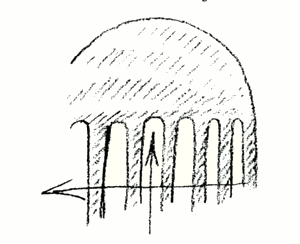 What comes to light in the course of history—in so far as we can observe it externally—is expressed for us in the progression. But an inner deepening will become more and more necessary, a deepening of the soul which is at the same time—as in the case of Goethe's Faust who descends to the Mothers—an actual ascent into the spiritual world—naturally into the spiritual world of the good Spirits. But when man raises himself into the spiritual world, a kind of conclusion will eventually be reached. I say “conclusion”. Let us grasp what this word really implies. The idea of evolution prevailing today is that it is like a barrel that begins to roll and goes on rolling and rolling forever—it is also imagined that there was never any beginning to this process, that it has always been going on. People who talk about evolution today almost invariably imagine that there has always been evolution, that everything has always been evolving, that it has always been so! But in reality this is not the case. It is nothing but a bad habit of the mind, a slovenly kind of thinking, to conceive of evolution as having no limits either in the past or in the future. The geographical, physical evolution of the earth also means evolution for every race, every people, Yes, but that certainly has an ending, a conclusion, at some time or other! When everything has been discovered, there is an ending. We shall not be able to say then: Now we will equip our ship once again and make further discoveries. it is not true that evolution can continue endlessly; evolution has a conclusion. And just as physical evolution must have an end, so too will spiritual evolution have to have an end; an actual dome will arch one day over what humanity has experienced in the course of history. And true as it is that when the whole globe has been explored, no further ships will be equipped in order to discover still more distant lands on the earth, it is equally true that what is to be spiritually discovered by man will also one day actually have been discovered. The idea that men will go on investigating endlessly is the most erroneous there could possibly be. It is essential that thinking shall be in accordance with reality if sound ideas are to be developed. But so few people think in accordance with reality in our present age, although they are convinced that they do. One can, for example, come across people who say: When there is nothing more left to investigate, the world will be a very dull place. These people forget that according to the modern idea of evolution, investigation will never come to an end. Yet one day it will, just as geographical exploration of the earth will eventually come to an end. Those people who are tormented by the thought that investigation will one day come to an end and that there will be nothing more to do in this respect and who ask: “What will man do then?”—must be given the answer: That will be plain enough when the time comes, and in any case it will be something quite different from investigation. I have now given you a number of ideas, the purpose of which may puzzle you. But if you take them together you will be able to recognise this purpose yourselves. We see that the course of all historical life is reflected in the form of our Building. Men live on through the ages, just as in the Building one goes forward from column to column. They rise to a higher level just as one raises one's eyes to the columns, capitals and architraves. And they hope for a consummation—a conclusion—just as one will find it on looking up into the interior of the cupola. But there is to be a conclusion in history too—it is to be portrayed in the painting of the domes. This painting must not merely be a covering of the surface, but call forth the thought: When you come to the surface of the dome you will discover something.—One must forget that any physical structure is there. The physical element of the paintings must be pierced through; one must see through the surfaces into the expanse of the spiritual worlds. It may possibly be that we shall not succeed in this in the case of our Building, but as the principle is developed, one day, perhaps—as the result of Spiritual Science—men in some future time will behold a mighty dome whose configuration leads their gaze out into the infinitudes of spiritual life. If we live at some particular place on the earth and want to travel to another—at certain times we may want to do this but are prevented—then it is brought home to us that men can confront each other as enemies, that they can fight with one another about things of the earth, and even more than fight. But they cannot fight about the sun and the stars! Even though the Chinese have called their ruler the Son of the Sun, the Son of Heaven, and although for various reasons they have started wars on the earth, they have never started a war about ownership of the sun; it has never occurred to them to engage in strife with other nations about ownership of the sun. All kinds of things can be the cause of strife in the souls of the peoples spread over the earth; but that which directs men's gaze upwards into the spiritual worlds can never be an inducement to strife. It cannot lead to strife. It must be realised that a great deal has yet to happen in the course of earth-evolution before humanity will have advanced far enough to have such a vision of the spiritual world that Spiritual Science will be as the sun and the stars are in physical life. Much will be necessary before this point is reached—above all the point where, through Spiritual Science, men will begin to think not only with the instrument that is almost entirely used for thinking today, namely, the head. In a certain sense it is true to say that nothing is more remote from us than our heads! For in all, essentials, the head, as far as its main foundation is concerned, was already completed at the time of the ancient Sun-evolution. The rest is an inheritance, partly from the Saturn-evolution, and has developed to further stages; during the Moon-evolution another important impulse was given. But. what is thought out in the head is in reality as remote from men as is their knowledge of the Saturn-, Sun- and Moon- evolutions, Although there are often profound truths in many sayings current in everyday life, there is one very common phrase which should not be believed. One often hears it said “I have a mind (German, “head”) of my own.” That is an error. No one has a mind (or “head”) of his own; his head belongs to the Cosmos! If someone were to say: “I have a heart of my own”, he would be talking sense. But he talks nonsense when he speaks of having a head or a “mind” of his own. Men will have to begin to develop thoughts which are experiences in the way I described yesterday in speaking of the inner experience of rising from the recumbent into the standing position. We experience this too, merely with the head. In reality a stupendous process takes place in us when we raise ourselves out of the recumbent position in which we lie parallel with the surface of the earth, and place ourselves into the direction of the earth's radius—but we experience it in an utterly abstract way. This change of direction from the cross-beam of the cross to the vertical beam—when this becomes a real experience it is a stupendous. process, a cosmic process it is the Cosmic Cross. 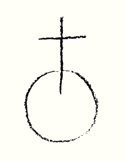 This happens every day. But we do not by any means think every day about the fact that through the act of standing up end lying down, this Cross is inscribed into very life. It is a far cry for man from this abstract process of standing up and lying down, from this assumption of the form of the Cross, to the conception that can be expressed by saying: If man were not so constituted on the earth that he lies down and again stands up, the Mystery of Golgotha would not have been necessary. If someone utters the sound B—as for example in the word Building—and adopts the sign B for this sound, then the sign signifies the sound B. If someone asks for a sign to express the fact that the Mystery of Golgotha was necessary for earth-evolution, then it is to be found in the Cross, which embodies the acts of lying down and standing up. Because man is so constituted on the earth that he lies down and stands up, the Mystery of Golgotha had to take place. This will be known when men begin to think with the second brain—not with the “head-brain” but with a second brain to which I referred in the lectures on “Occult Reading and Hearing” when I said: The lobes of the brain must be regarded as arms held in a fixed position. If your arms and hands grew to your sides, you would think in such a way that there would be no possibility of doubting that this Cross is the appropriate sign for the Mystery of Golgotha. It is only the head-brain that is baffled by this kind of thinking. But it is also the head-brain that creates the soil for the many misunderstandings prevailing in the world. The reason why so many misunderstandings arise is because the head-brain alone is active and creative today. But the second brain must also become creative, creative to such a degree that something indicated figuratively a little while ago, is fulfilled. I said that the Greeks did not know of America. But when we go back to other ancient traditions, we find that there were times when the existence of America was indeed known. But then this knowledge was lost. There were also times when that which Spiritual Science is striving again to acquire was present. Spiritual Science knows that a great deal that formerly came to men from subconscious, dreamlike experiences, must come again consciously. Men also had something like a common speech, which only later differentiated. There is profound truth in the biblical legend of the Tower of Babel. But as long as men can only think with their heads they will not be able to be creative in the way they were creative in ancient times, for example, in speech. Spiritual Science, however, has within it the capacity to bring the elements of speech into movement. And when it is said that in our Building the element of art has been brought into movement, it must also be said that life itself must be stirred into movement. A vista can arise before us of a time when Spiritual Science will be truly creative, when through the thoughts and ideas unfolded in Spiritual Science, speech itself will become creative. Spiritual Science will one day be spread over the whole earth and will give rise to a common speech, corresponding to no speech or language existing at the present time. I am not referring to anything like Esperanto, for that is an artificial, inorganic invention. The speech of the future will come into being when man learns to live in sound itself, just as he can learn to live in colour. When he learns to live in sound, then the sound itself gives birth to the configuration, so that it becomes possible once again to create speech or language out of actual spiritual experience. We stand only at the very beginning of many things in Spiritual Science but as yet not even at the beginning of what has here been indicated. We must, however, keep it in our minds in order to realise the importance of Spiritual Science and to be aware that Spiritual Science bears within it a new knowledge, a new art, and even a new speech—a speech that will not be compiled artificially, but will be born. Just as men will never fight about the sun or the stars, they will also never fight about that new speech, by the side of which the other languages still in existence when this new speech has come into being can quite easily continue. As you will certainly have felt, we have placed a far-reaching ideal before our souls, a very far-reaching ideal. Most materialistic thinkers of the present time would certainly say: This is all airy nonsense, for the fool who can talk like this about the creative power of speech and about Spiritual Science must assuredly have lost all solid ground from under his feet. It is easy to imagine that if some person of eminence in our time had been listening from a corner to what has been said, he would have burst into derisive laughter at this flight into the clouds without solid ground underfoot. We, however, could have a certain understanding of his attitude, because by placing such lofty ideals before us, we have indeed lost the dense, solid earth underneath us. As long as the earth continues its evolution as a physical planet, this ideal will not be realised. The physical earth will have come to an end before this ideal is fulfilled. But the souls of men will live over into other planetary incarnations, and these souls will experience the fulfilment of this ideal if they become conscious of it in our time. Yes! Ahriman might stand there and be the arbiter between ourselves and the person we have imagined sitting in the corner, listening and chuckling to himself because he supposes us to have lost all ground from under our feet. Ahriman might well rub his hands and say: “They call that ‘ideals of the future’! They have lost the ground from under their feet; the gentleman up there on the hill says so himself. He mocks himself and knows not how! He is speaking the truth and is not aware that he is doing so”— But we know that even though we do not stand on the solid soil of the earth, we nevertheless stand in Reality with what we make into the living word of the soul, And why? Because we avow the Mystery of Golgotha in earnest and not with the shallowness that is so general today. We know that Christ lives, and that we can know the truth when we let Him be the great Teacher and Leader in our striving for spiritual wisdom. But He uttered words to this effect: You cannot truly believe in Me in your inmost being until you cease to acknowledge only those words and ideals which will perish together with the earth—(for the whole outer configuration of the earth will perish, the earth in its present form will pass away)—until you hearken to My true words. Of these true words He has said: “Heaven and Earth will pass away, but My words will not pass away”. Therefore in the life of soul we can have firm foundations, even though our ideals cause opponents to say that we no longer stand an the solid ground of the earth. If we are to make true avowal of the mystery of Golgotha we must have ideals which are more enduring than the earth and the configuration of the heavenly bodies circling around the earth in the Cosmos. We must hearken to the revelation of the Mystery of Golgotha which will be there even when the earth no longer exists, nor the heavens which now look down upon the earth. The meaning of the word that proceed from the Mystery of Golgotha is infinitely deep. And those who will not lift their souls from the ground into the cupola—which should be transparent in order that they may look into the spiritual world—those persons are not living in Reality. For if this dome, this cupola, is to be the expression in architecture of the Mystery of Golgotha, it must itself remind us of the words: “Heaven and Earth will pass away, but My words will not pass away.” |
| 288. Architecture, Sculpture and Painting of the First Goetheanum: The Symbolism of the Building at Dornach I
04 Apr 1920, Dornach Rudolf Steiner |
|---|
| 288. Architecture, Sculpture and Painting of the First Goetheanum: The Symbolism of the Building at Dornach I
04 Apr 1920, Dornach Rudolf Steiner |
|---|
I would like to talk again today about the nature and significance of our building, for the reason that a number of external personalities are among us at the course for medical professionals. First of all, I would like to note that this building, as a representative of our anthroposophically oriented spiritual science, is intended to be in the world that which really gives an outward image of the significance and inner essence of this movement. If one wants to recognize this movement in its true significance, one must surely become familiar with the fact that this movement wants to enter the most diverse areas of life as something completely new, that its appreciation must arise from the realization that such a new thing is necessary in the face of the fact that old impulses in our present time clearly show how they are moving straight into decadence. If our movement had not emerged from that which the signs of the times themselves demand, from that which is not now in any human program, but from that which can be read in the spiritual development of humanity that lies behind our physical human movement, even if our movement were like so many other movements that also found societies, set up programs, and set up so-called ideals, then at a certain point this movement would have needed a larger building, larger premises for its membership, and they would have turned to some outside builder to have a house built. The architect would have built something in the traditional style, and the Society would have carried on its work in such a building. This is not how it should be with us. Rather, since we came to the point of being able to start a building project – which might even be completed one day – it had to be shown, precisely on the basis of this fact, how this spiritual movement, on the one hand, reaches the highest heights of spiritual life and, on the other hand, is a thoroughly practical movement that can directly engage with all aspects of practical life. That means that it had to be shown that our anthroposophically oriented spiritual movement is capable of producing new building forms, a new architectural style, out of itself. It had to be shown that our movement, down to the last detail, is not just a theoretical world-view movement, but something that can have a formative effect on everything that is placed externally in the physical world. Thus this building was not constructed as an outwardly unimportant house, but was built out of spiritual science, out of its very own feelings, ideas and thoughts, and in every detail it is an expression of what this spiritual science wants to be. It does not want to be some mystical driveling, it does not want to be some abstract theory, but it wants to be something that can deeply intervene in the most everyday life, and must therefore also intervene most in that which is to be its own representative. The whole of this structure should express how it places itself in the present as a living protest against what the centuries, the millennia, have brought to humanity and what is currently leading humanity to decline. Given that we could not build the structure in Munich due to the narrow-mindedness of the local artistic community, but had to erect it here on the Dornach hill, it must be seen as a stroke of good fortune that, by approaching the hill, this double-domed structure can now really be appreciated. For it is truly not for external reasons that this building has become a double-domed structure. This Goetheanum has become a double-domed structure – a building composed of a larger and a smaller dome – to show that something is to be revealed to contemporary culture and that something is to be received. That which emerges from the depths of spiritual life is represented by the small dome, and the fact of receiving is represented by the large dome. And I think that fate has done well that the one who approaches this hill in Dornach can already have the feeling, through the way in which this double dome rises above the hill, that something new is being added to human development, but something that can also have an effect on human development at the same time. The first pictures we will show you this evening should demonstrate to what extent this is the case. The first picture we will show is of the building as seen from the north. 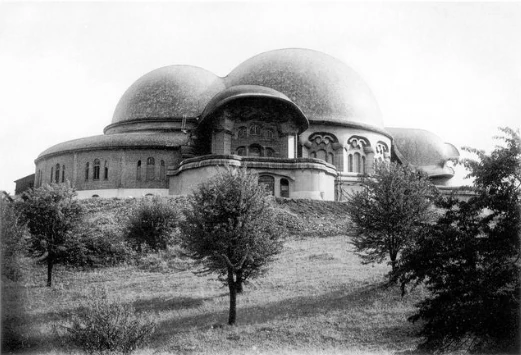 Another aspect. Approached from a slightly different angle, the building looks like this. 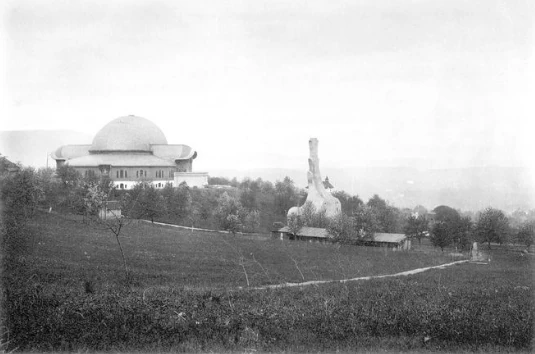 The third picture is supposed to show the northeast aspect. 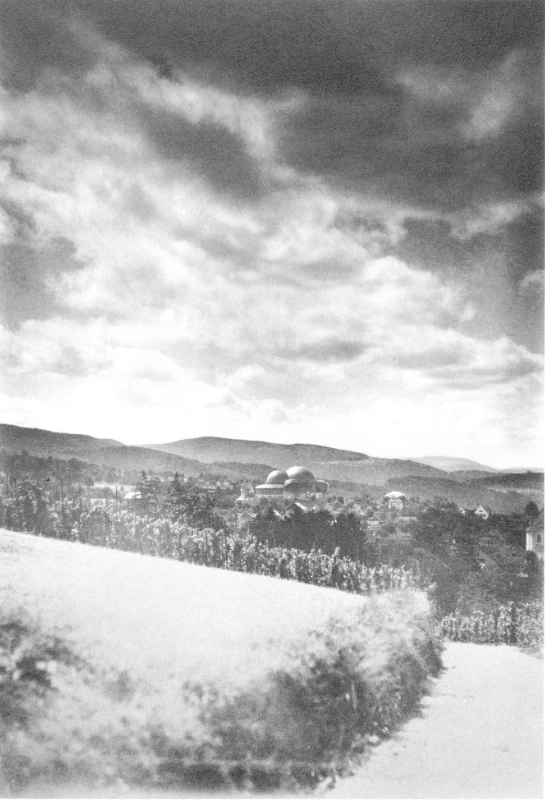 The fourth picture is intended to represent the southwest aspect. 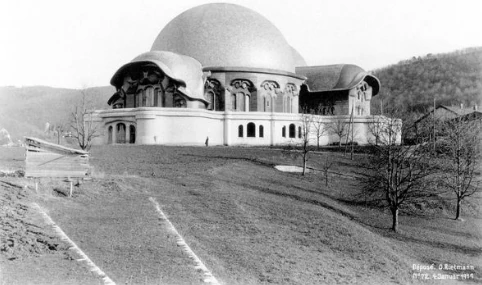 The next picture is supposed to show the northwest aspect. 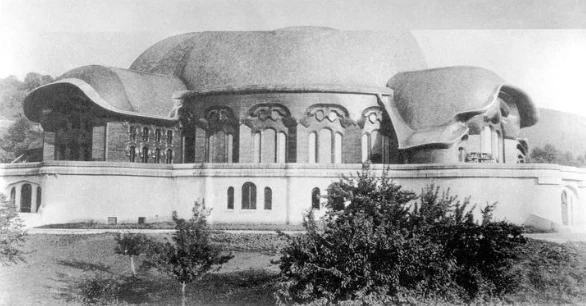 This is yet another aspect. 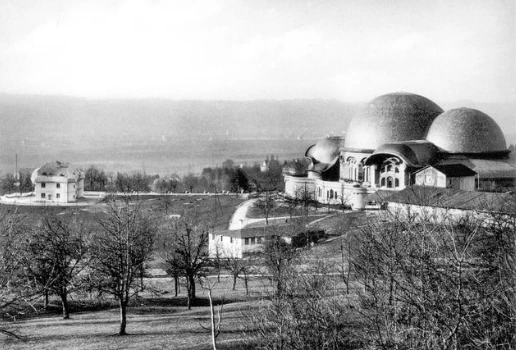 And now let us visualize how the building appears to someone entering from the west. The building is oriented from west to east. You enter at the bottom, and the cloakrooms are downstairs. You come up to the walkway through a stairwell and enter the building through the gates, which are in the west. The whole building is designed in such a way that it presents an organic architectural concept in contrast to the dynamic-mechanical architectural concept to which one is otherwise accustomed. Therefore, the forms everywhere are such that they blend in with the organism of the whole building, just as I would say that any limb – even the smallest in humans, the earlobe – blends in with the whole organism. Thus, a limb blends into the whole organism in such a way that it must be in its place, as it is, as large and as shaped as it is. In the same way, every detail should be in its place in this building; every detail should take its form from the overall form of the building. Furthermore, without falling back on mystical symbolism, there is not a single symbol in the whole building; everything in the building should be poured into artistic forms and show in artistic forms what task each individual piece has. 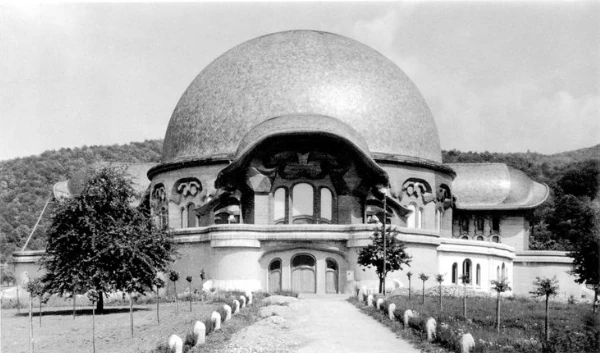 The West Gate. The West Gate has the task of welcoming those who enter. This welcoming, this receiving, this welcoming, so to speak, should be expressed in forms that are not geometric, but which should be expressively organic forms. As I said, you enter the building from below, via a staircase leading to the gallery, from where you then enter through the west gate. 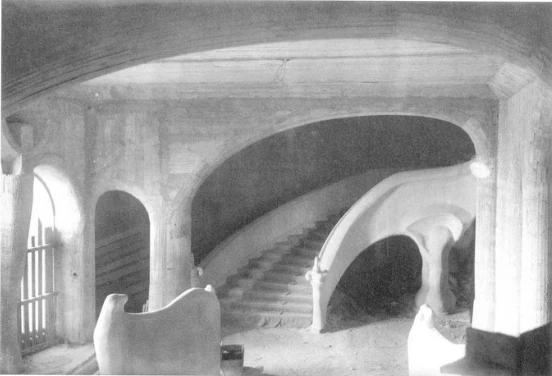 Now the staircase. You are looking here towards the northern side of the staircase. It can be clearly seen from these things how everything here is designed so that it has to be in its place, where it is found. For example, you see how this column capital is perfectly adapted in form to this side, its inclination towards the place where the whole structure must be supported; narrowing on the other side, where the entrance is, where there is nothing more to support. 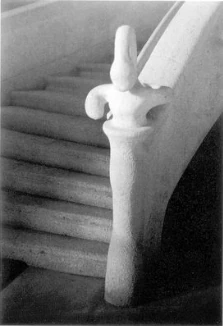 During on-site explanations, I have often pointed out this structure at the beginning of the staircase: there are three semicircular shapes with their planes perpendicular to each other. It is the shape that emerged in my mind when I tried to imagine how a person walking up these stairs would feel. He would have to feel at the point where the first step of the staircase begins: When I step into it, the external influences of life are calmed. Inner emotional movement will be found inside, which completely calms the outer feeling. In there I will stand on safe ground. That was what I wanted to express. This presented itself to me because I had to develop this thing here. It is a formation that has an external similarity to the three semi-circular canals in the ear, which, when injured, lead to dizzy spells that thus take away the certainty of the person when they are injured. But that is a discovery that occurred to me only afterwards; the matter itself is formed entirely out of the sensation. 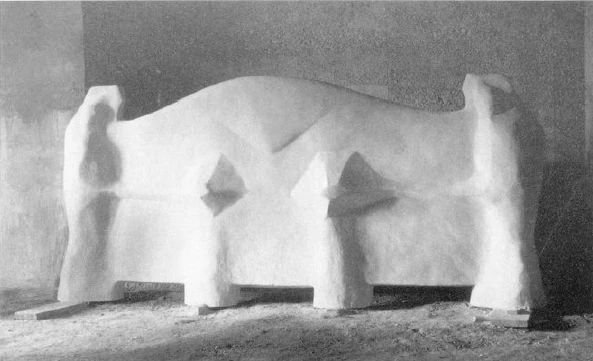 You can also see a radiator cover. These radiator covers are designed in such a way that they represent, on the one hand, growing out of the earth, that is, the forces that grow out of the earth in a supersensible way and permeate the sensible; they are counteracted by other forces coming from above. For those who can perceive this interplay of forces, elemental figures emerge, and these elemental figures are expressed in the forms of these radiator covers, which are otherwise built in their entirety according to Goethe's principle of metamorphosis. Each radiator is the organic metamorphosis of the other. Each was designed to fit exactly into the place in the house where it belongs. But at the same time, the principle of metamorphosis is carried out with the same fidelity as in the plant itself. Every single form, every line, every curve is shaped according to the spatial and functional requirements, and I would say, the original form, which of course is not found here. Every curve is appropriate to the position of the limb of the structure on which the curve is located. A curve that is diverted points to something else in the structure, as opposed to a curve that is bent inward, as you can see here, where the perspective is not even quite right. 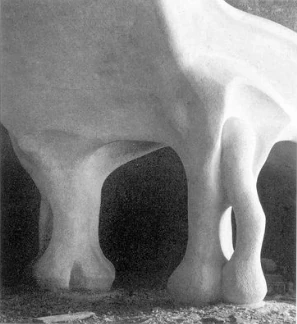 There we saw the same thing again, in more detail. You can see here how an attempt has been made to replace the conventional mathematical-dynamic pillar with something organic, which in its form has the character of support, of support through a force that comes from the elementary forces of the earth and is precisely suited to the distribution of the load that is to be supported at this point in the way in which it shapes its forms. Of course, I am well aware of the many objections that can be raised against such designs from the point of view of traditional architecture. But it is high time that an attempt was made to replace the usual dynamic-mechanical building concepts with an organic building concept that is based not on dynamics and mechanics but on organic principles. 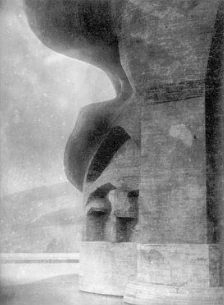 Here we have again seen the side on one side of the main entrance, where you can see how they tried to bring out the character of this being a side piece, how it turns towards the center, how it points to the side. This shaping is particularly important. 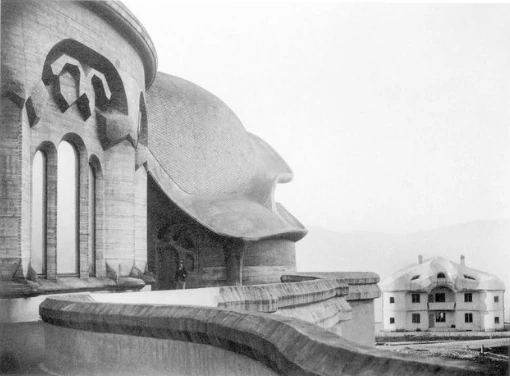 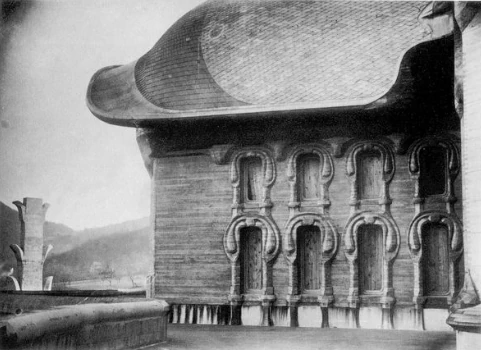 The next picture. Here you can see the side wing, as it goes north, with its windows. And you can see here how it has been tried to overcome the merely decorative. Here, the support is led down everywhere, so that the windows stand up at the bottom, so that not only the windows are worked out of the wall like a decoration, but that the windows stand up everywhere. But you can also see how, in the room containing the motif in question, the same motif that is above the side windows above the main entrance reappears here at these windows. But if you can properly visualize the metamorphosis internally, then such motifs take on such a form that, from a purely external point of view, they no longer resemble other motifs at all, and yet they are actually the same. Just as the sepals and stamens are no different from the petals and leaves of a flower – even though the leaves take on completely different forms depending on the plant's position – so it is here. Thus, Goethe's idea of metamorphosis has been realized in its entirety in the artistic process. 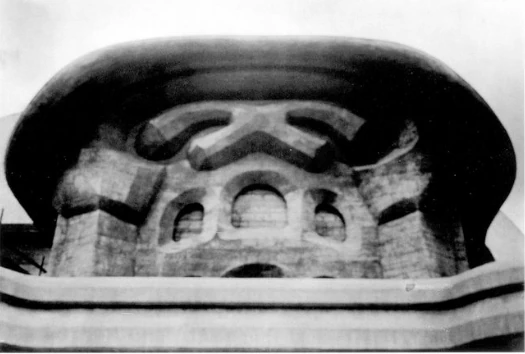 Here we have the upper part of the side entrance. You see, once again, the same motif above, transformed, but also the motifs that you see everywhere, metamorphosed. 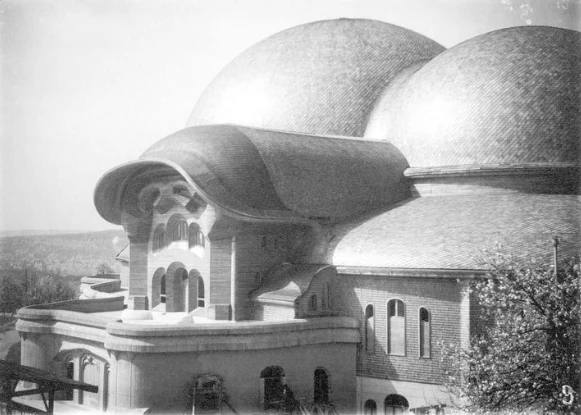 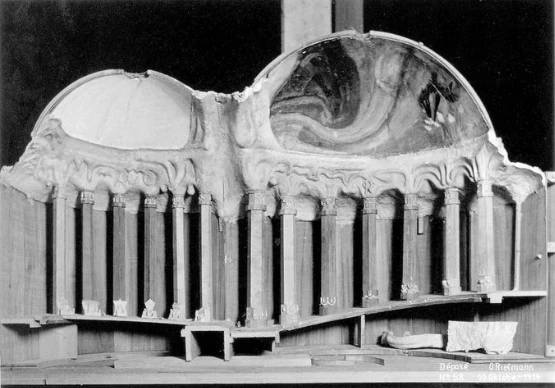 Here you see my original model, cut in half, that is, at the point where the axis of symmetry lies. The forms were first worked into this model. This model was, after all, the basis for the construction. 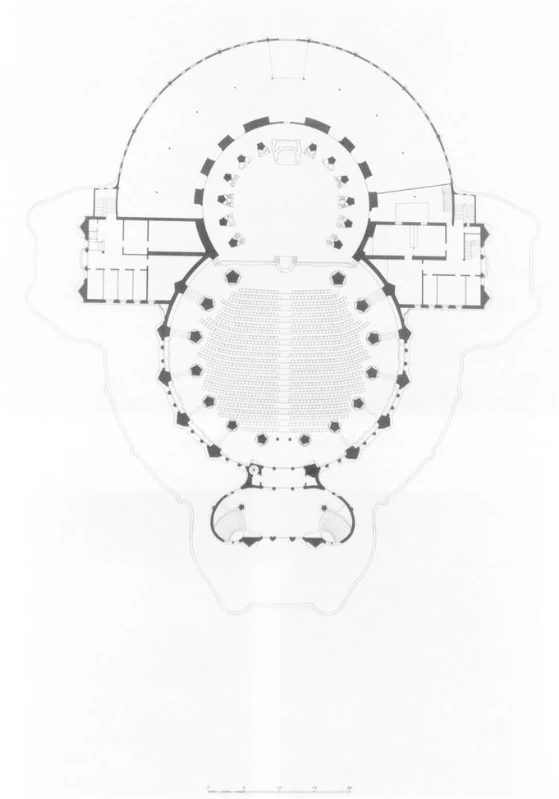 This is the floor plan of the building. This floor plan shows the extent to which the building is designed as a double-domed structure. The small domed room faces east. The main group will stand here, which all of you already know. Here is the west domed room, the auditorium. You can see that when you come in through the entrance, you enter the auditorium. You first come to a vestibule lined with wood, each individual piece of which is handcrafted, and all surfaces and curves are worked so that their surfaces and curves must be exactly where they are. 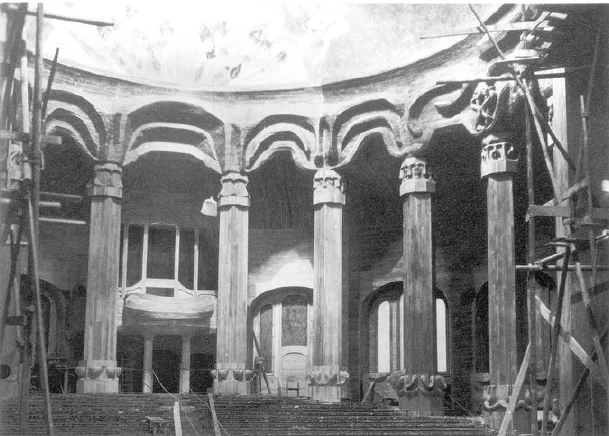 You enter below the organ (Fig. 29). The casing and framing are designed so that you can see that the organ is not just placed in the room, but grows organically out of the entire surroundings of the building. Then you always have a walkway on which you can walk around outside and below during intermissions. The auditorium holds about nine hundred or a thousand people. Then the entire perspective of the building is arranged according to an axis of symmetry; you won't find the same axis of symmetry anywhere else, everything is oriented towards this one axis of symmetry, while otherwise the auditorium is arranged, stepping forward, from seven columns on each side. These columns in the auditorium have bases, have capitals, and above them are architraves. Everything that is worked into these columns is done so in strict accordance with the principle of the evolution of nature itself. If you follow how the capitals, bases and architraves of the individual columns grow out of one another, you will see an image of evolution, of development, in the emergence of one motif from another. It is necessary to immerse oneself in the way in which one form grows out of another in these columns, with artistic devotion, with artistic sensitivity, just as one form of nature's development always grows out of another. It is not good to start from an abstract terminology in a philistine, pedantic way. There are certain reasons why one can name the one column Saturn's column, the other Venus' column, etc. But one must not obscure what is essential in the essence: the belonging together of the seven columns, the emergence of one column from the other. And above all, we must not obscure what lies in the forms themselves, which must be felt by following the line of swing, the curve of the form, by dreaming ourselves into a symbolism that does not exist. This is more inherent in the emergence of the form of one column from the form of the other column than in simply looking at a column. In the process, it turned out, by recreating nature itself, so to speak, that the idea of development, which is very often understood as if in each development the following stage of development is always more complicated than the one before, that this idea of development is not correct. Every development proceeds in such a way that at first there is a simple form; then a more complicated one develops from it, then an even more complicated one. This reaches a certain culmination; then again the forms begin to become simpler and simpler, and outwardly the most perfect form reveals itself as the one that has been simplified again. It is only an apparent simplification, but it is still a simplification, I would say, in the limbs, and there is a certain complication in the formation of the limbs. This is strictly adhered to here. You can see how the design of the columns becomes more complex up to the middle column, and then becomes simpler again towards the east, so that the seventh column is relatively simply designed again. The small domed room is closed off in this way on each side by six columns, the bases of which are designed to hold twelve seats, and here too the principle of development is fully adhered to for the capitals, the bases, the seats and the architraves. When you endeavor to recreate nature, it is the case that you only truly discover your findings in the finished product that you have created. One can – and this is something that only presented itself to me after the design of the matter in the model – one can, if one takes the raised, convex form of the first column, one can place it in the concave form of the seventh column in a truly artistic way, of course with metamorphosis, but with a true one. The second column fits with its raised part into the concave parts of the sixth column, the third into those of the fifth, and the fourth column stands alone as the central column. Of course, the same principle cannot occur in the same way in the six columns. There, the first and the sixth, the second and the fifth, the third and the fourth really correspond to each other as I have just expressed it. It is something that is found throughout nature, that certain polarities occur, and it was interesting that only the idea of development was retained in the formation of the forms, and that the polarities resulted automatically from the pure retention of the developmental idea. 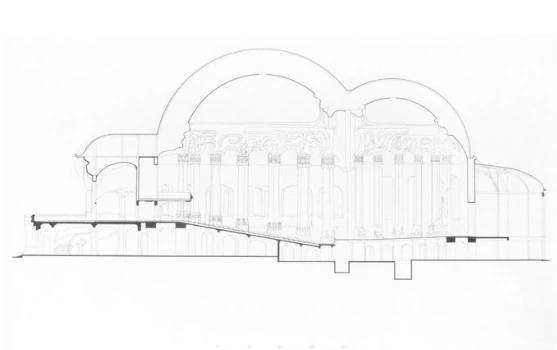 The next picture: Here you have a section through the building in a west-east plane, so that the order of the columns is presented to you exactly as it can be shown in a section. 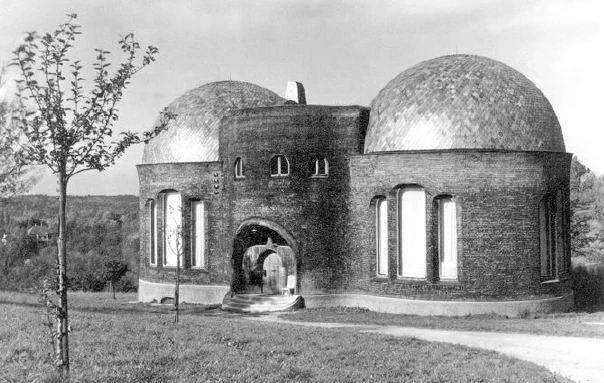 Here you can see the glass studio in the area below where the windows were cut, which I will talk about later. This glass studio is in some ways a kind of metamorphosis of the whole Goetheanum; only the metamorphosis is brought about by the fact that, firstly, the domes have been pulled apart and a central element has been added, and secondly, the domes have become the same size. For all such inner processes of drawing apart and becoming equally large, metamorphic experiences then arise for the whole organism of a thing. These are then faithfully executed in every detail. You can also see that the usual geometries in our building have been overcome by the fact that the symmetrical axis has been interrupted to the right and to the left. The idea that each individual piece should be seen in the context of the symmetry of the whole has been applied to the stairs. You will also see this when you look at the gate for this studio (Fig. 99), with the staircase, the shape of which has been designed in such a way that it really does represent a staircase, precisely because of its shape: you go in, you have a right and a left, while very many stairs that are designed are now really nothing closed, have no right and no left. All these things are to be considered when it comes to a truly artistic creation. The gate itself is designed in such a way that one recognizes its symmetry as a necessity. When you enter this glass studio, you will also see the lock. It is designed to differ from the usual philistine locks that are otherwise in use and which are really the opposite of anything beautiful. 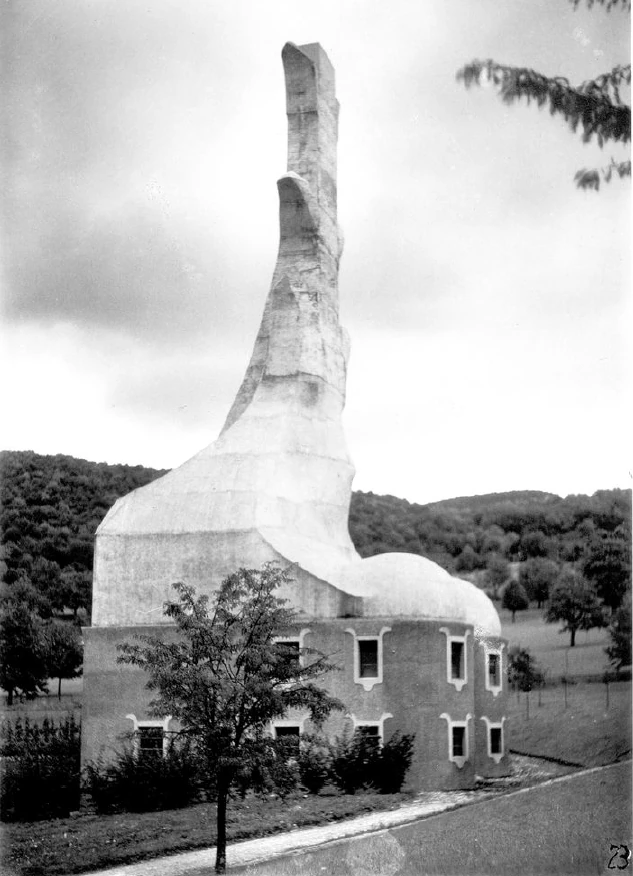 The next picture: Now you see what has been most contested in a certain way, but which will also be understood over time. It is the building in which the heating and lighting are housed, the boiler house. And it is built according to the principle that what is inside has its envelope in the building. Just as a nutshell is shaped so that it is a shell for a nut, here the shell is entirely appropriate for what is inside, right up to the shapes of the chimney, which is only complete when it is smoking, because the smoke is part of these shapes; it then forms the top of the chimney. So everything is conceived according to the same principle by which nature creates when it forms the nutshell around the nut. 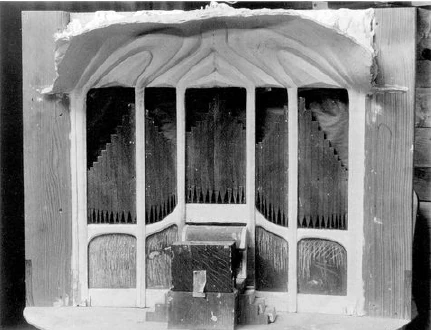 We will now turn our attention to the internal motifs. You have used the organ motif here as a model. The architecture around the organ should be such that the whole structure is organically integrated into it, so that one does not have the feeling that the organ has been placed in some random location, but rather that the organ grows out of the whole organization, as it were. 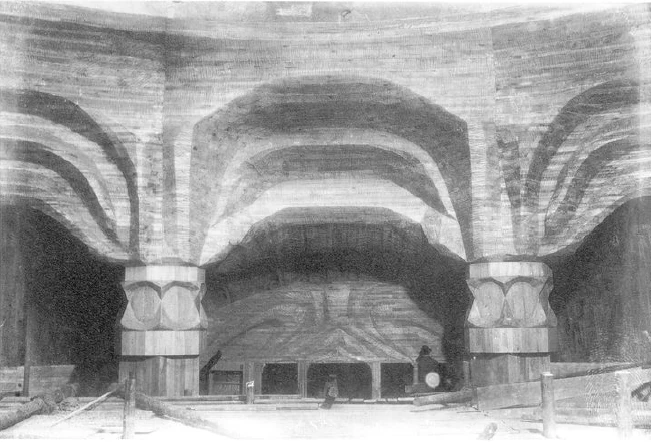 So, by walking through the space below the model and then turning around, we have the two symmetrical columns in the auditorium with the simplest architrave motif at the top. We will now look at each individual column each time. 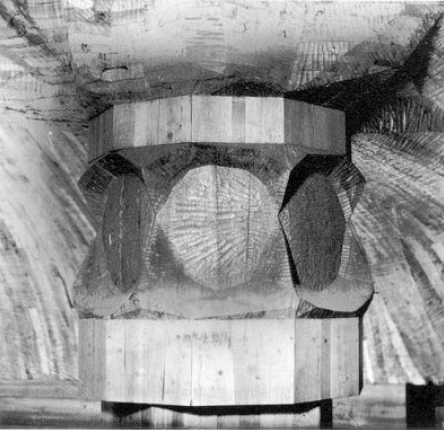 And as we advance, we first see here the simplest column, one of the two, and now, after we have let its forms act on our perception, we will look at it in connection with the second column. 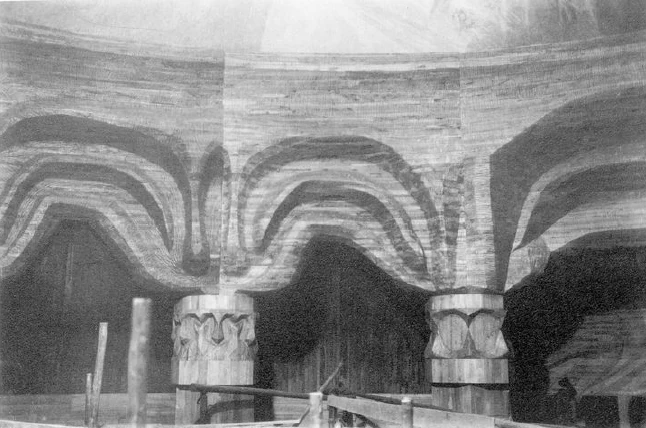 We shall see how what is simple here [at the first column] grows downwards, how the lower part grows towards it, and how what grows downwards, what grows from top to bottom, undergoes a certain complication of forms, from top to bottom undergoes a certain complication of forms, thereby pushing forward other rising motifs. This can only be felt by observing the succession of the two columns. It is precisely this succession that must be observed. You can also see here how the architrave motif becomes more complicated. It is actually the case that by immersing yourself in these forms, you can learn more about the idea of development, the developmental principle, the developmental impulse in nature than through any theoretical discussion. Because nature is such that it creates in images, and it must be emphasized again and again that, even if our philosophers prove that one should work with abstractions, with analyses and with the discursive principle to build a science of nature, then nature simply turns its nose up at this science and does not let itself be grasped in this way; it eludes comprehension and leaves us alone with our abstractions. Because it does not create in natural laws, it creates in images. But now, when we can rise to imaginations in abstract terms, we enter into nature and understand nature's growth. The entire structure should be designed in such a way that it is simultaneously the great hieroglyph through which the world can be grasped. Wherever you look in this structure, you should have a starting point for understanding the world. That is what is, if I may use the term, secretly woven into this structure, that in looking at these forms, that which, so to speak, governs the world at its core, is presented. 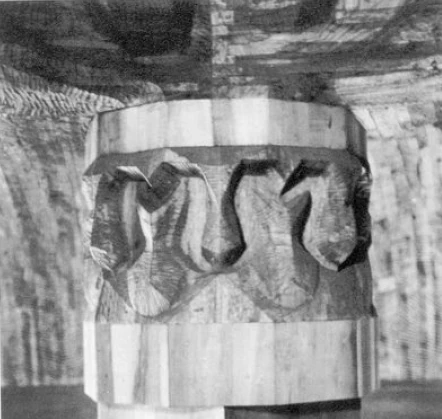 We will now see the second pillar on its own. 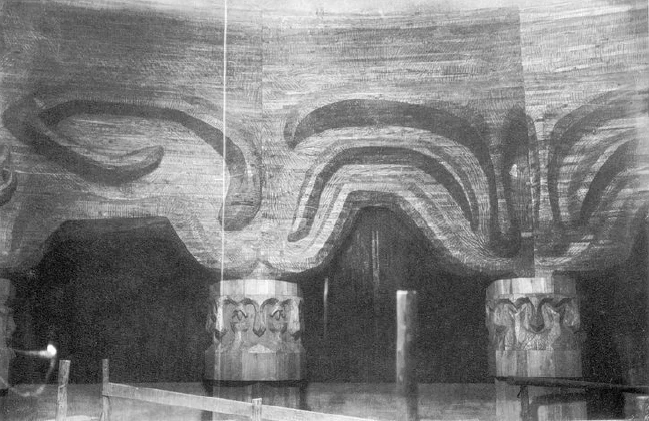 And now again the second with the third column in relation, with the modified architrave motifs. You see how here again the forms become more complicated from top to bottom, and how they are met by forms that become more compact towards the bottom. However, these forms can only be produced, one from the other, if the artistic design is based on the same developmental forces that nature uses to form a plant leaf by leaf, or in a series of developing creatures, one species emerges from the other, one species develops out of the other. By imitating nature, such forms are created. And those who immerse themselves in nature will succeed in recognizing the principle of development in nature. Indeed, something has been set up in this building that should inspire people to say: what surrounds me here as something growing, what surrounds me here as something formed, is something that stands as an explanation of the whole surrounding world. 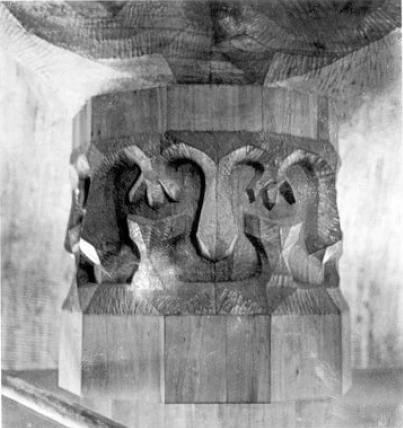 We will now see the third column on its own. 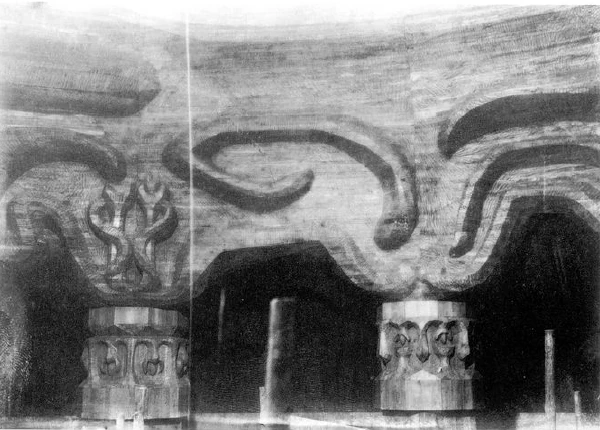 And now we will see the third column in relation to the fourth column again. You can also see that the architrave motifs are becoming more complicated. You just have to imagine how, according to the principle of growth, one emerges from the other, one grows over the other, and you do not need to say: here is a caduceus, but you have a principle of growth that emerges out of it, grows over it, breaks through the overgrowth, and the caduceus does not stand there as an isolated symbol, but as a developmental phenomenon, as a developmental form that emerges from the other. It is the same below with the capital motif. 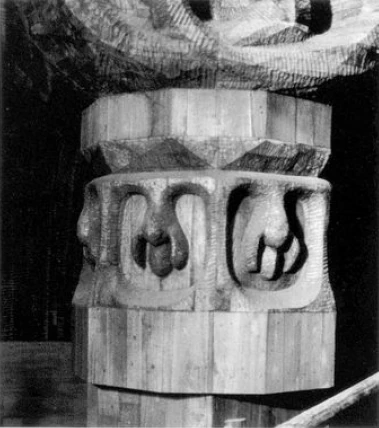 We will now look at the fourth column on its own. 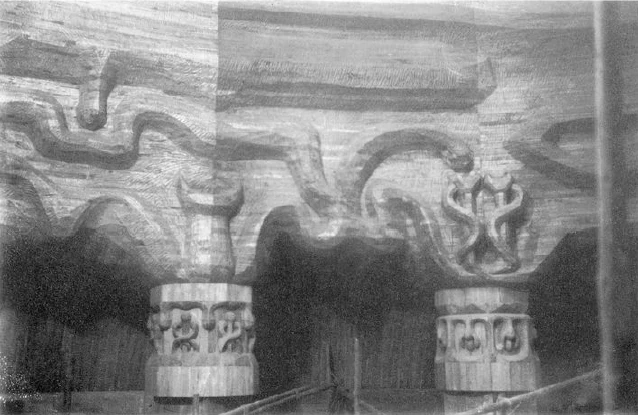 Now again this column with the following one. You can see how purely by one growing over the other, this caduceus, snake-staff-like structure emerges. It is taken entirely from the growth, not placed as an isolated motif. It is perhaps also cleverer in the usual intellectual sense to throw one motif after the other. That is not what is aimed for here. The aim here is for each motif to emerge from the last, and for the harmony of the motifs to give the actual impression of reality. 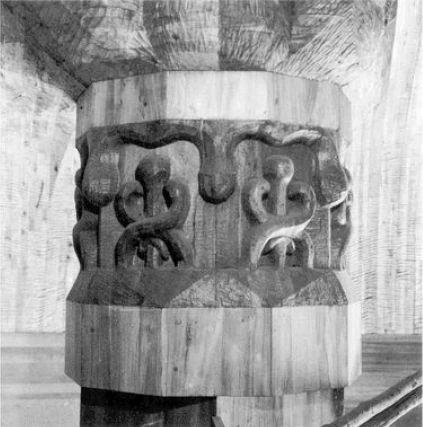 The fifth column on its own. 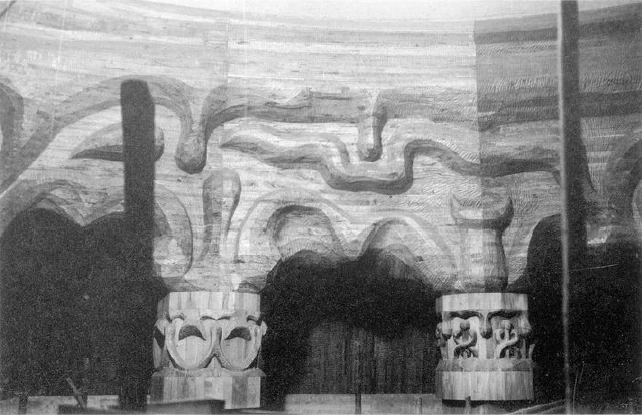 Now again this column with the next. You can see how here, through the continued growth, not a complication occurs, but a simplification. The architrave motifs have long since become simpler; but here you can see how this motif simply continues to grow, grows upwards, and the motif arises in a completely natural way. In growing, there is always a pushing away. The two parts below here grow upwards; this is rejected, and the motif emerges in a natural way. This is eliminated as it grows; on the other hand, this grows downwards and the shape emerges quite organically from what went before. 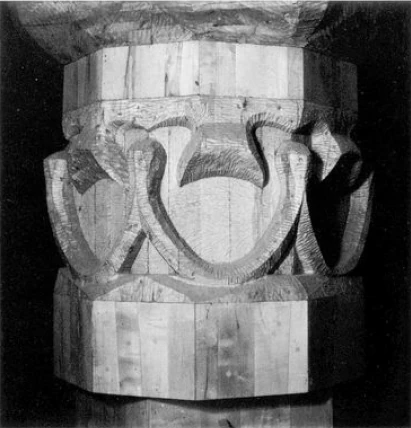 The sixth motif on its own. 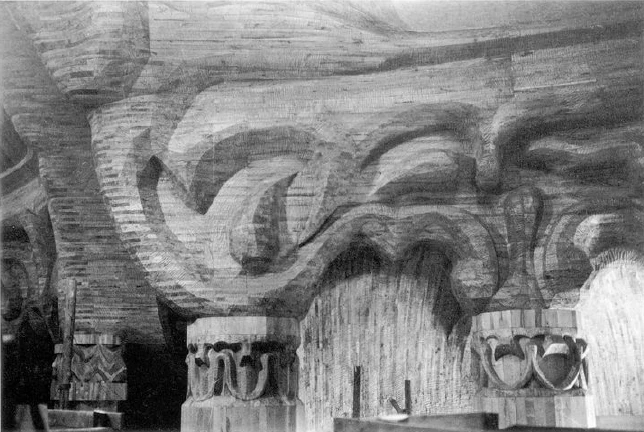 And again this motif together with the next one. You can see how the next motif simply emerges from the previous one by growing further, growing, then overgrowing at the top and finally merging. 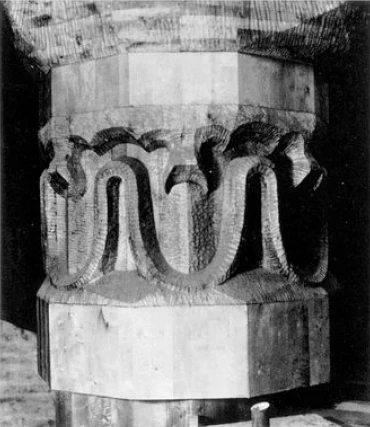 Now the seventh motif on its own. Another simplification, but a complication in the lines. Tomorrow I will show you this artistic element, which lies in the complication and simplification, by means of a simple representation on the board. We have now arrived at the point where the curtain column is, where the large dome space merges into the small one. Here you have the last column, the connection between the large and small dome spaces. 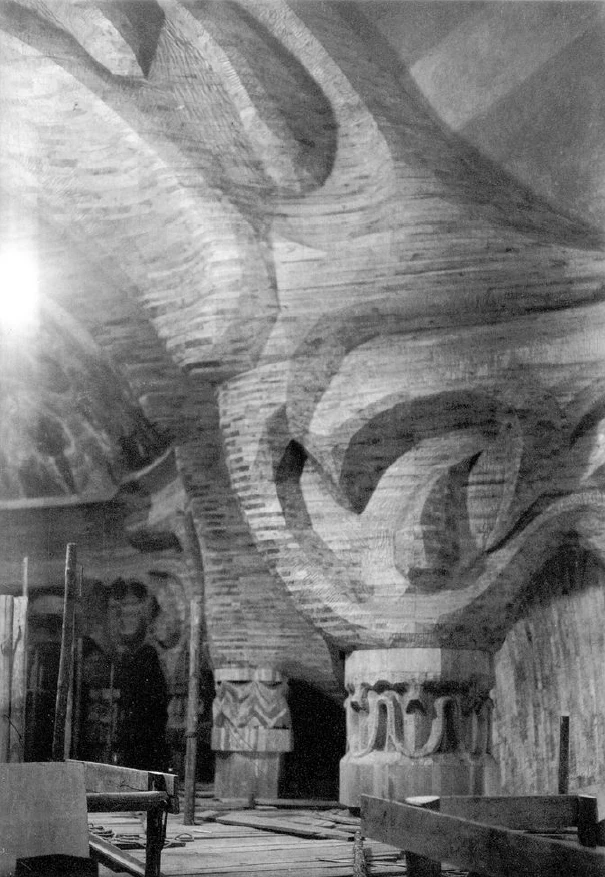 We are now moving further into the small domed room. You can see that it goes into the small domed room. 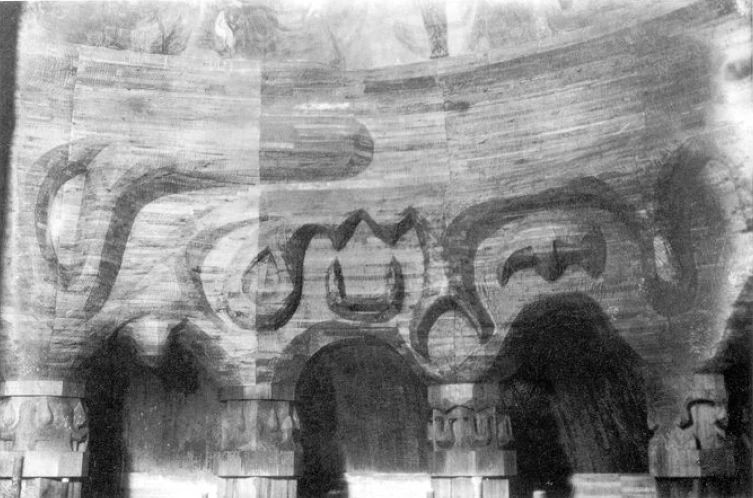 We have here the order of the columns and the architraves of the small domed room. If you remember how the two motifs were on the other columns, you will see that the forms have been changed to reflect the fact that this is a smaller room with only six columns. You just need to consider the following: If you have seven columns that are supposed to create a unified effect, then you have to give each column a different shape. Then imagine circling the same space with six columns instead of seven. In that case, the distances between the columns, which are one and one-seventh, or 8/7, would be different in relation to the previous ones, and so individual shapes would now be changed. And here, in addition, you have the smaller dome space. This further changed the forms. You see, when something like this is created, you get what I would call a sense of space. Those who think abstractly – and such thoughts have even appeared in scientific literature – are of the opinion that, for example, one can also imagine a human being as very small, atomistically small, that size itself, the spatial volume, has no relationship to the being. But this is not true. Anyone who has immersed themselves in the essence of artistic creation knows that a particular form can only be reproduced in a particular spatial volume, that the size of the space is in an inner relationship to what is being depicted. If you have conceived of some figure for a particular large space, and you then make it en miniature, it seems distressing. But this feeling must be there. The artistic elements must be coordinated with their spatial content to this extent, otherwise they are not truly artistically designed. 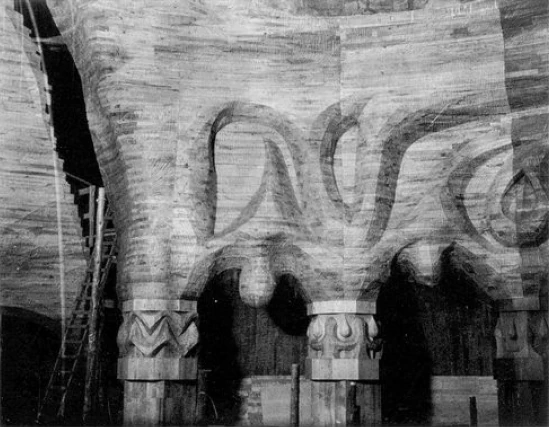 The next picture shows another row of columns from the smaller dome with the corresponding architrave. You can see the slit for the curtain, the first column, the second column and so on. We will study the individual columns in their sequence later. 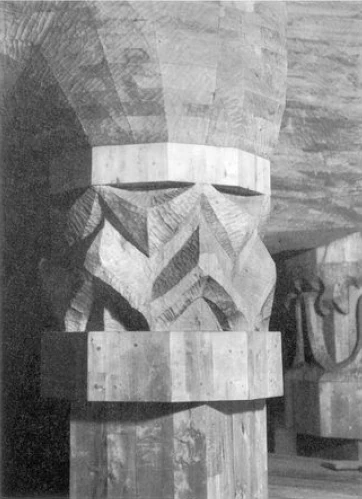 The first column of the small dome. 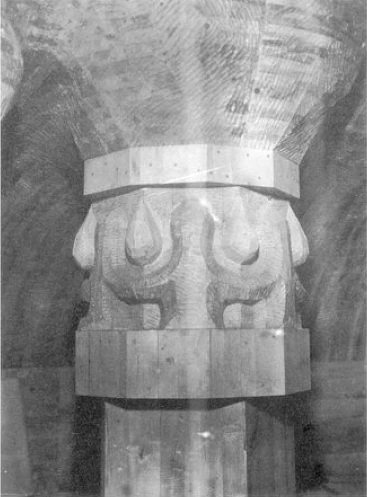 The next one will now be more complicated, according to the growth principle. 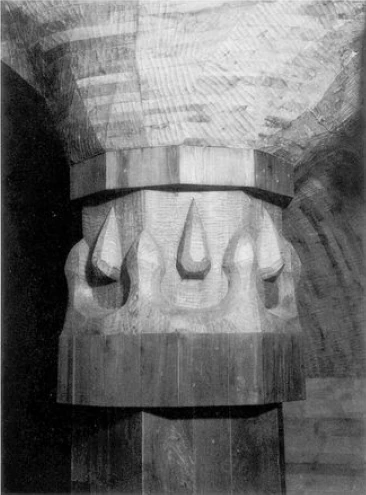 The next one is more complicated again. 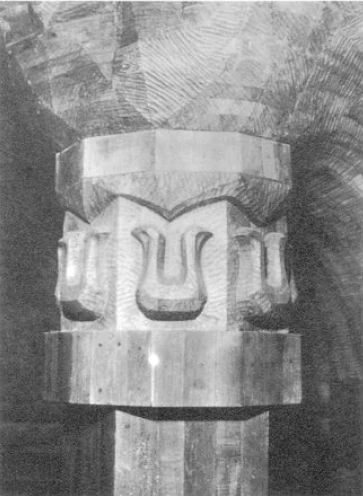 Now it is about simplification, but it is a sham simplification; it is simply an outgrowth. 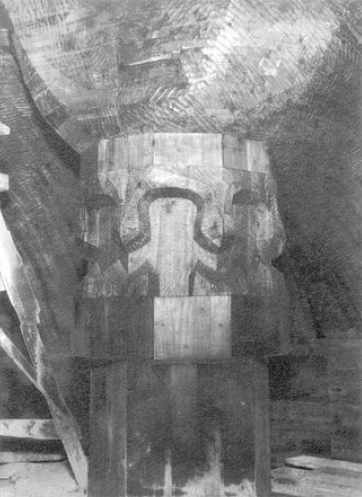 The next column. 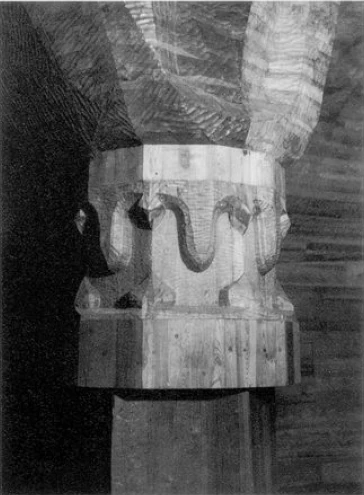 There we come to the two columns that border the east end. 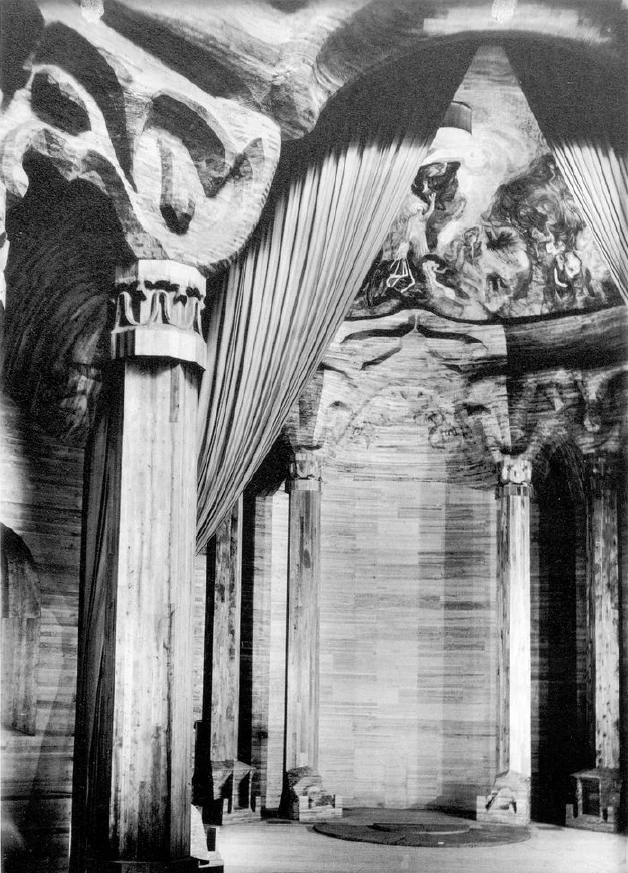 We have the carvings of the east end here. You will see them if you look closely. I would say that the forms here can be felt more than seen. If you look closely, you will find that the carving here in the east end encompasses everything that the other forms of the columns and the architraves contain, but of course modified for the vaulting of the room, metamorphosed. Above it a five-petal flower. Anyone who wants to can imagine a pentagram there, but in the same way that one can imagine one in a five-petal plant leaf in nature. A symbolist would have put any old pentagram there. But then one would be acting according to the principle by which we have often acted. Time and again, we have had to experience that artists came to our branch offices who were unpleasantly touched by the fact that unartistic motifs were found everywhere. A cross that was ugly in design, with seven roses around it, was something that was considered more dignified than something truly alive in artistic forms. It is precisely when one is able to pour the spiritual out completely into artistic forms that what is to be achieved here is achieved: not intrusive symbols, but a shaping in forms in which the spirit lives. When we describe how the Earth developed from Saturn, the Sun and the Moon [gap in the text], we do so in such a way that what lives in the whole also lives in the ideas of our worldview. However, it does not live by expressing itself symbolically through any form, but rather the forms themselves have real inner forces of growth. 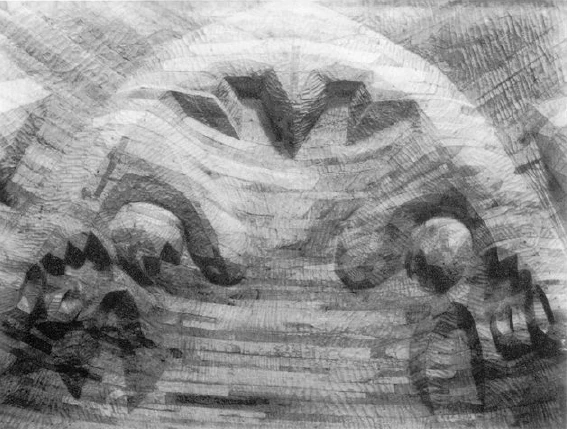 Here you can see this eastern end a little more clearly in its individual forms. 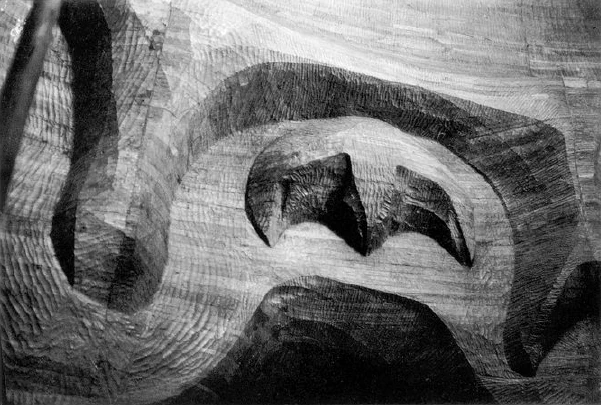 The next picture is a detail of the side of the small domed room. And now, my dear friends, I have begun to use these pictures to explain something about the building to you. I will continue this discussion tomorrow so that those who are hearing it for the first time will get a complete picture of what our building should be from this presentation. I will continue these reflections tomorrow with the help of more slides. |
| 288. Architecture, Sculpture and Painting of the First Goetheanum: The Symbolism of the Building at Dornach II
05 Apr 1920, Dornach Rudolf Steiner |
|---|
| 288. Architecture, Sculpture and Painting of the First Goetheanum: The Symbolism of the Building at Dornach II
05 Apr 1920, Dornach Rudolf Steiner |
|---|
I would like to start by talking about the principle of development, which I already hinted at yesterday. I said: If we follow the metamorphosis of forces within a developmental series, we first come from the simple into the complicated. So I want to draw a simple [it is drawn]; then a next more complicated one would perhaps be this; then we would come to a third, to a fourth, which would be like this (Fig. 105). Now we might have four stages of development of the same thing. Now the next one could be somewhat more complicated than the previous form. We would then perhaps get this [fifth] form. But this would not come out, instead this other form will develop. What I have drawn with the thick line, that would then perhaps be visible on the outside. And if it were a real form in nature, one would then progress from this to this form. And yet it is only in the etheric that development continues in such a way that the more complicated forms, which I have indicated with the dots, emerge, while the physical, the externally visible, that which reveals itself again, perhaps simplifies itself again. The next forms would then perhaps be such that the ethereal forms would be these [sixth]. But it is not this ethereal form that comes to the fore, but rather what remains visible on the outside is this [the thick line], which in turn is a simplification, an essential simplification, so that if you just consider physical development, you go from a stage of 1-2-3-4 in complication, then in simplification. This is also really the principle of development in nature. For example, we can see how, let us say, the eyes of certain lower animal beings – considered physically and externally – are more complicated than the human eye. Certain lower animals have blood vessel-like organs, a “sword-shaped process” and a “fan” in their eyes. These are also disappearing, and the human eye is relatively simpler in its outward form, but the etheric body has a more complicated form. We can only grasp the principle of evolution correctly if we present it in this way. The principle of development is correctly captured in the evolution of the columns, capitals, architraves and bases that you were shown yesterday. If you want to understand our building, you also have to bear in mind that the entire treatment is appropriately designed for the new architectural style in terms of character. It is the case, for example, that even the artistic treatment of the wall is different from the way walls were treated in earlier architectural styles: the wall was always conceived as the boundary of the space that one wanted to close off. Here at the Goetheanum, the wall is conceived in such a way that it actually overcomes itself. This is physically achieved in our windows. Our windows, in so far as they are the main windows of the auditorium, are etched out of single-colored glass panes. It is then the case that the artistic works are actually only created by the sunlight shining through. So the processing of the window panes is a preparation, and the whole impression is created by the interrelationship between what has been worked on the pane and the sunlight shining through. In the windows, in particular, what has otherwise been striven for in the entire building has been physically achieved, whether through the design of the columns, the carving on the walls, or the painting: the wall virtually dissolves. So that when you look at the wall, you don't have the feeling that the space is closed off, but that you have the feeling that you are being led out into the cosmos through the wall. With the windows, you must have this feeling physically, because you lead directly, I would say, to the effect of light on the outside, purely through the physical design of the panes; but with the other wall designs, this has also been attempted artistically. This will give you an idea of how a new stylization of building forms has been striven for here, down to the last detail, how the formal language of our building is to be a new one, so to speak. It is understandable that philistinism cannot immediately comprehend this new design language, my dear friends. Now, it is important that we first show you some of what has been achieved with painting. First of all, I will show you the painting of the small dome, because I only have pictures of it here for now. 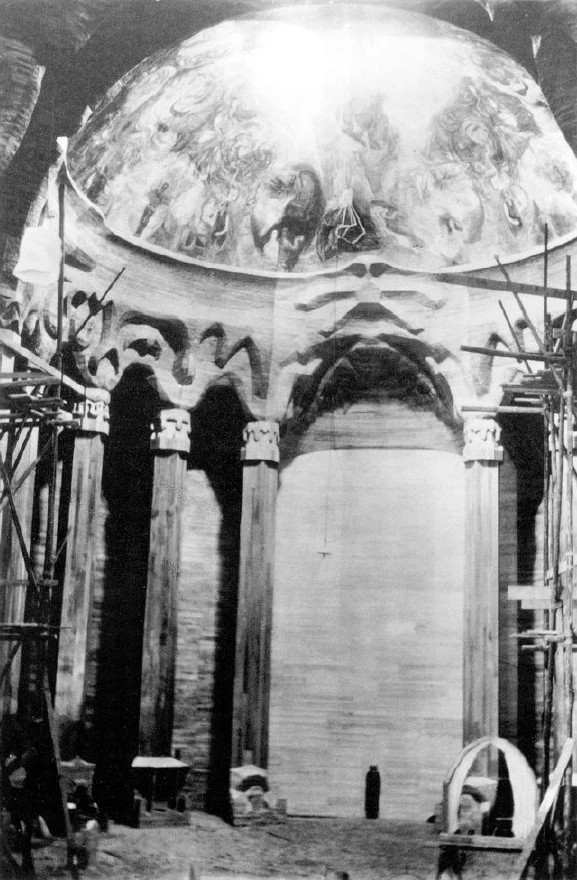 Let us look at what our revered friends actually saw. By visualizing this now in non-colored images, we must immediately point out that the essential thing about the painting of the small dome is not the motifs, but the bringing out of the motifs from the colors. There lies, I might say, the very beginning of what painting of the future will have to bring. Man will indeed have to understand more and more that in the details of nature, in essence, there is always something essential. For example, when you immerse yourself in a color, or in a color combination, it is not just this color combination that is present, but the color itself is something alive, something that works out of itself, and it is possible to educate oneself, for example, to live with the color blue. You will then get the feeling that the blue color gives you the impression of the designed, the moving, that which moves or is formed in space. So if you approach it in a creative way, you will get something that you draw out of the blue. The red or yellow gives you the impression that it wants to reveal itself, come towards you, talk to you. While the blue glides past you, the red gives you the impression that it comes towards you. In this way, being with a color, but especially with many colors, can be invigorated. And all these things actually are in the work of nature. And only someone who educates himself in this immersion in the elements of nature can understand this. Therefore, it is somewhat striking when, let us say, in the current, indeed, in itself quite justified new striving for art, things come across that actually show that one has come out of imitating nature and, isn't it true, into something that one is actually striving for new artistic things in the inartistic. When we see that all manner of expressionist and futurist and so forth things are put together in any old way, or put together differently, what appears in nature in a certain way, then very often – not always, of course – there is something very unjustified in such a combination. For example, someone who forms a human eye cannot help but place the second eye in the right place if they do not merely see, but if they know how to live intimately with the creative forces of nature. This is because the eye is not something in itself, but only exists with the second eye. But one only comes to the inner essential creation of nature when one can live with the entities of nature, for example with colors. And now, look, how could it not be possible to create from color itself? I just want to know when someone says: I am not interested in something created according to the model, but I am interested in applying the colors, I just want to know why then the form should not emerge from this pure application of the colors as the creature of the color. We have to get away from the model again. We have to get away from being tied to the naturalistic. Art has worked on that long enough. But we have to be able to develop an interest in seeing a light surface simply as a color spot and seeing a dark surface as a color spot. I would like to know how, when you simply have a light and a dark surface in an arrangement [it is drawn], how you could not feel a face turned in this direction, surrounded by hair growth here (Fig. 105). Everything can be brought out of the color combination. Just as everything can be brought out of the treatment of the surface, of the treatment of the form in sculpture. In contrast to color, if painting wants to work with color, the line, the drawing, is actually an untruth. Because, you see, the horizon is not really and truly present as a line. That is not true at all. It is not a horizon line. What is real is the blue sky, and below it perhaps something shaped by nature, and that borders on each other. It is the contact of two colored surfaces. Whoever draws the line is lying. Whoever paints two colored surfaces, which of course must then have a border, is telling the truth. And it is with things like this that one begins to get used to the truth. Because we, wanting to be naturalistic, have lied so much artistically, that is why we also have the plight that so many lies are currently being told in the other world contexts. Just think what, let us say, for example, the drama has achieved. Drama, at the end of the 19th century, in the culmination of materialism, began to be materialistic as well. There were people sitting in the auditorium watching dramatic performances of Arno Holz or Gerhart Hauptmann and so on, and now they didn't have something dramatic in the old Shakespearean, Schillerian or Goethean sense, where great series of events that are far apart are summarized, but a back house, a front house, or something like that, which was to be recreated in a very naturalistic way. The people should not talk about anything other than what is usually talked about in three hours. What kind of naturalism is that? It is the naturalism that, just like today's natural science, only takes into account the extra-human, which also, in the artistic, only takes into account the extra-human: can it be seen? If you wanted to be a model for a drama, you would have to remove the third wall so that everyone could see inside; then you could see what happens in three hours and recreate it from the stage. These things are of course not taken into account at all in the age of naturalism, and one does not find the possibility of really placing the human being back into the whole natural and cosmic context. But this must also happen in art. It is understandable that art has long adhered to the model; but now the time has passed when art can adhere to the model. Art must grow together with the creative forces of nature and work out of the creative forces of nature. For what is the point of recreating nature in a naturalistic way? Whatever is created in a naturalistic way can never be achieved by nature. Every smallest achievement that is made out of something that is not there in the senses can be more significant than anything that appears to be so perfectly created in nature. If you want something realistic, you can say that you are sticking to nature itself. And in addition, in many areas naturalism was even somewhat extraordinarily frivolous. One thinks of Hauptmann's “Weavers”: the well-fed people sat down in the theater to overlook the whole series of scenes in Hauptmann's “Weavers”. This was called “social art”, bringing the misery of life into the theater, something frivolous, a frivolous cultural phenomenon. So we have to turn to the supersensible again. Today, people find it difficult to decide to enter the supersensible in art. But it will not become light in humanity if we do not decide on something like this in all areas. Because the small cupola room is painted, the motifs are only the novellistic, not even the truly pictorial, artistic. But you have seen the thing itself, and so you might remember, especially in the pictures that I can show here, what you saw. It is perhaps even interesting to note how what is on the dome wall there cannot be reproduced if you only have the motif. But the motif itself, if you have it, must show that there is something incomplete about it. A motif that only appears in black and white is simply not satisfactory, because you have to be able to say what is missing. There must be something missing, because what is actually supposed to be depicted is areas of color, not black and white, and not lines, while what will appear to us is the novellistic element, the thought, which basically does not belong at all. 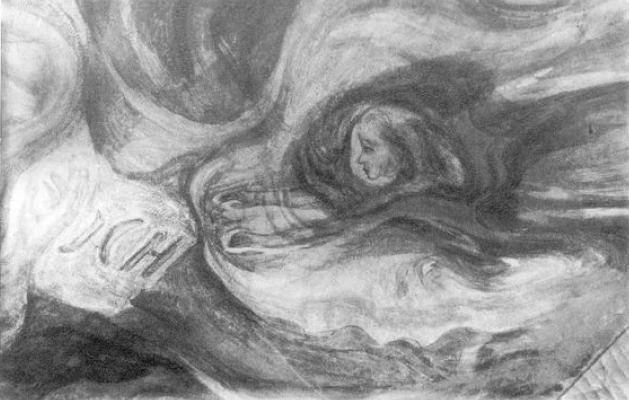 What you see here is what meets you from the small dome when you enter it. A child, emerging from the indeterminate material forms, flying towards the medieval figure, which has been captured by capturing a kind of Faust figure. It should be captured in a certain sense, the initiation of the Middle Ages. After humanity had gone through the most diverse forms of initiation, this initiation of the Middle Ages came about with all its tragedy. It is indeed the case that, according to the spiritual conditions of this stage of human development, the human being cannot rise to an understanding of the living unless the realization of death stands beside it. To see through the connection between life and death is what leads, ultimately, from the Middle Ages to our own day, and through it to true knowledge. 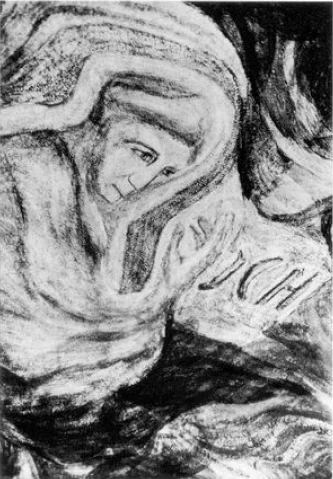 In the next picture you see here that which lies further to the east: this medieval initiate himself, who comes to his realization out of reflection, out of turning away from the world. But precisely if we want to experience this turning away from the world, we must experience it by acquiring an understanding of the forces of death that are out there in the whole world. And these forces of death are intimately related to our powers of consciousness. The same thing that confronts us in the human skeleton, that, my dear friends, that is the external image of death, at the same time expresses in external physical form what lives in our nervous system when we experience the reflective consciousness of modern times. The consciousness of the early Middle Ages and especially the ancient consciousness were such that they did not depend on the human being dying in every moment of their waking lives in order to think. But in return, human beings were filled with images and imaginations in their consciousness, even if they were atavistic. Intellectualism has only developed since the middle of the 15th century. It has developed because our head organs have assumed a formation that, when it takes hold of the whole person, continually leads to death. A battle between life and death is constantly taking place in the human being. The head wants to die. This is prevented by the life forces that continually surge up from the rest of the organization. This dying of the head, to which we owe our intellectual consciousness, is what should also be expressed through all the colors and everything that has been brought out of the color in this form. This is the only place where the letter, the written word, appears within our entire structure, and rightly so, because it is only in this time that the I, the I-thought of humanity, has become so abstract that it can be pointed to with letters. The I-thought will only be able to be borne more and more by the fact that this I is indeed filled with the Christ. That is why medieval mysticism had the task of developing the Pauline word through a whole series of sermons and reflections such as those of Johannes Tauler and Meister Eckhart. It is fixed for all eternity within the medieval language, which developed in the German-speaking areas after the modern era, that the I: written out, the initials of Christ Jesus: ICH; 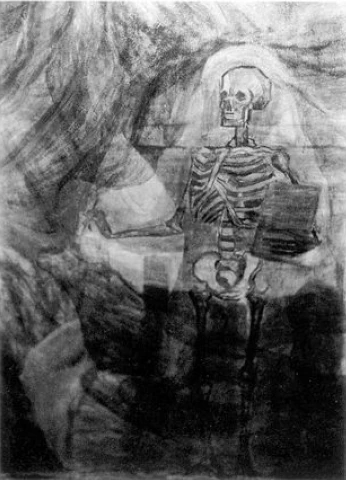 For the reasons I have just explained, you see Death beneath the Faust figure; this Death comes from forces that work from the center of the Earth towards us and combine only with the Mercury forces that work from the cosmos towards the Earth. The sight of the Faust-like figure with Death below him would be unbearable if the counter-image were not created in his perception, in the child flying towards Faust and the ego. 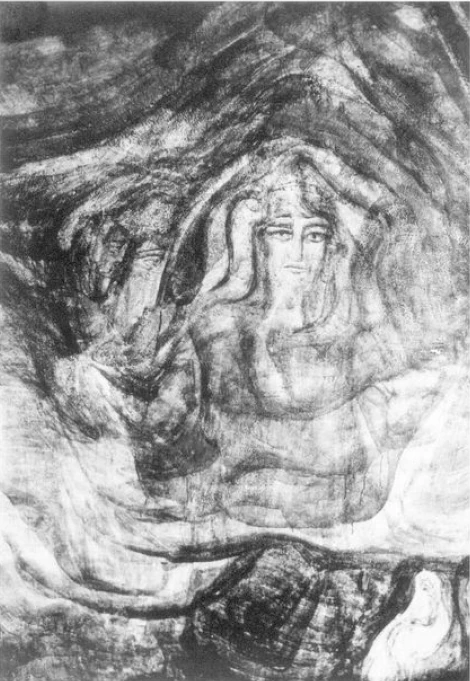 The next picture shows us the Greek personality as she lives under the initiation, a more feminine figure, since in fact the Greek initiation spoke more to the feminine. In general, in Greek high culture, the content of the initiation had to be gained by the initiate acquiring what female figures, who to a certain extent intervened in the flow that comes to man from the cosmos, what could be gained from such female figures: The Pythian priestesses in Greece are intimately connected with the whole structure of the Greek initiation. So that then such things appear as these heads, for example, which are worked purely from form. This already invites us not to ask in the abstract sense: What does something like this mean? This question is an unartistic one when posed in abstract form. At this point, one must look at what color is there and how, according to the principle that I have just explained here, the shapes themselves emerge from the experience of the colors. Everything that belongs to this figure has actually come about in the end through the perception of the colors. 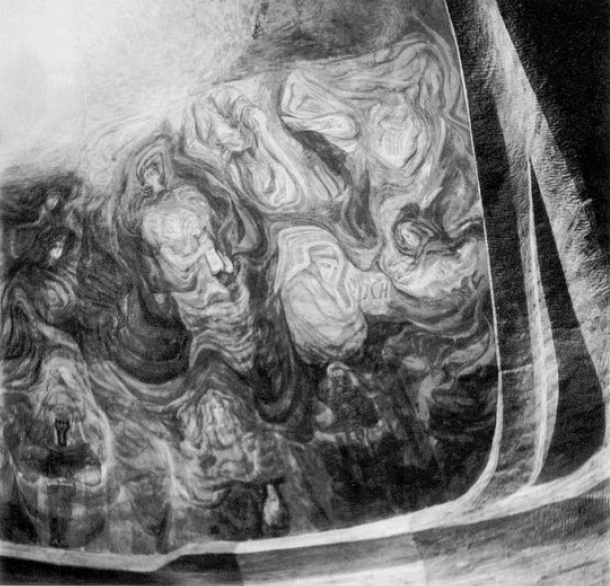 The next picture: you have a larger area to see here, here is the flying child seen earlier; here the small dome connects to the large dome; then this figure of the medieval initiator, and here is death. And here is the figure you just saw, above it the inspiring figure, an Apollo-like figure. Unfortunately, the picture is very imperfect. And at the top there is still the higher inspirer. In these pictures, there is always what is initiated as a personality. Above it, there is the figure that sinks the imaginations into the personality to be initiated, and above it, there is the figure of a higher hierarchical order that sinks the inspirations into it. So here you have the inspiring figure, which is above the Faust-like figure. 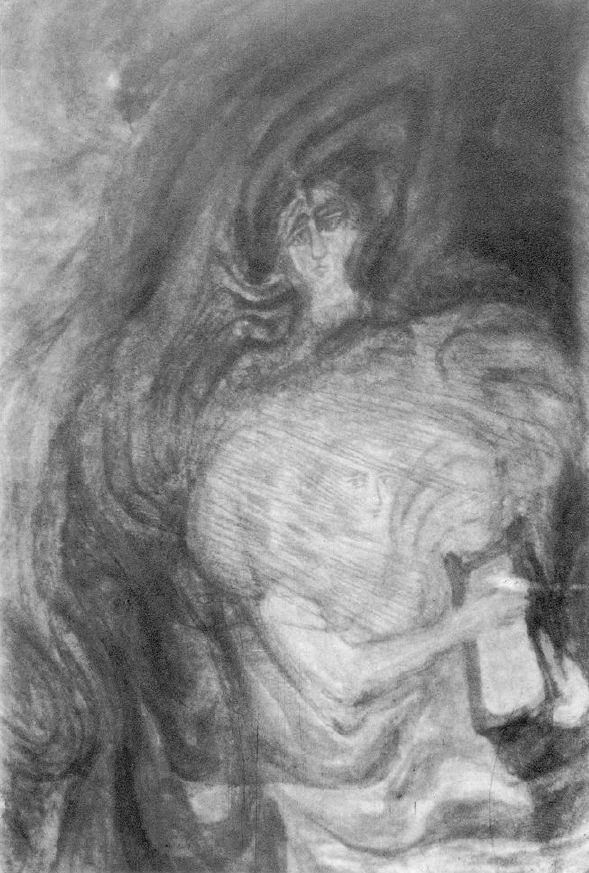 The next picture is unfortunately very unclear. This is the inspiring figure that is above the Greek initiator. If you imagine the one you saw earlier, with the three heads on the shoulder, then this is the figure above it, the one who lets the imaginations flow into the lower figure, and above that the inspirer of the heads of the inspirer. Here is the head of the inspirer, and below that would be this Athena-like figure, who inspires and is inspired and imagined. 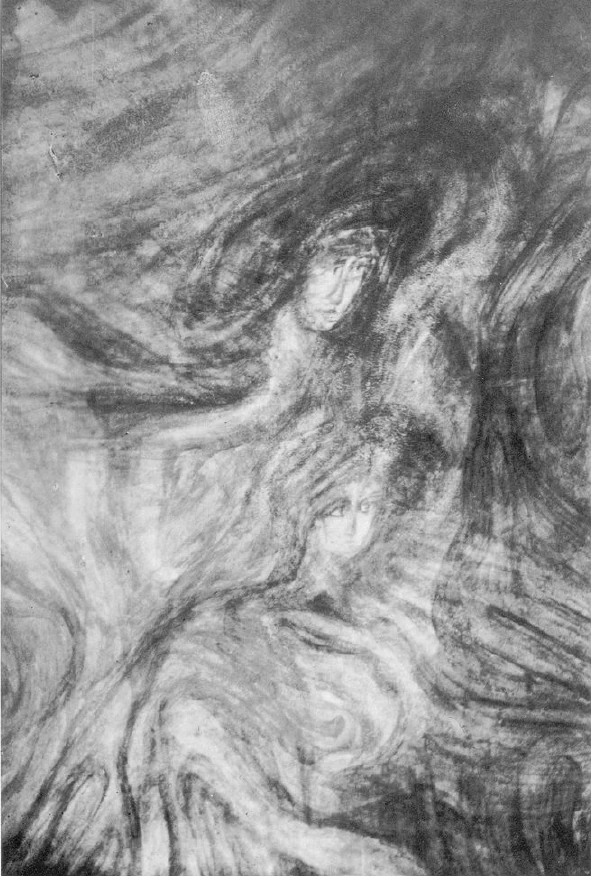 And here you have the two figures. The figure at the bottom is that which sends the imaginations down into the Egyptian initiates, and the other figure is that which allows the inspirations to flow into them. And as we move forward, we come to the representation of Egyptian initiation. 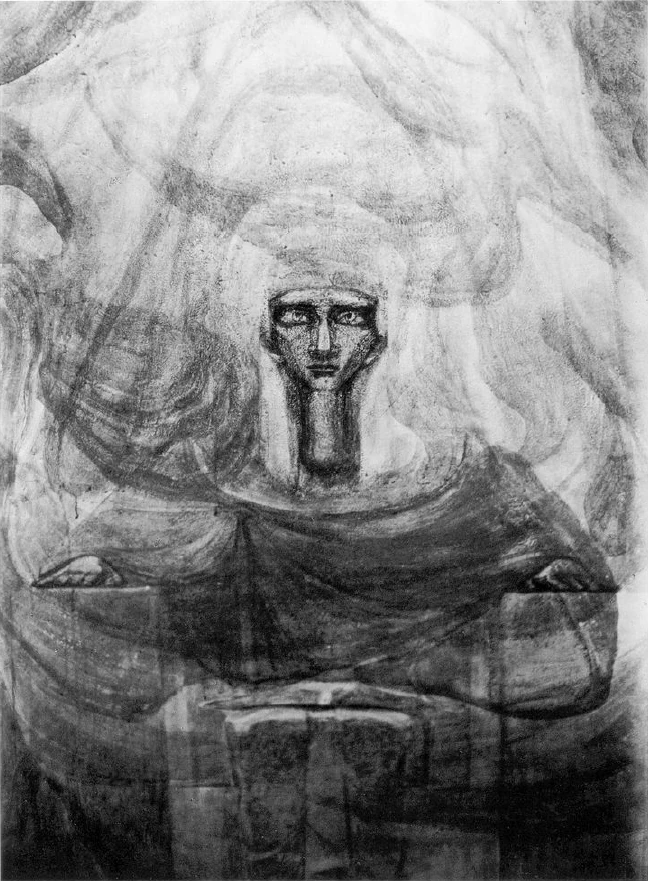 So the next picture is the Egyptian initiates; above him are the two figures that have just been seen here. 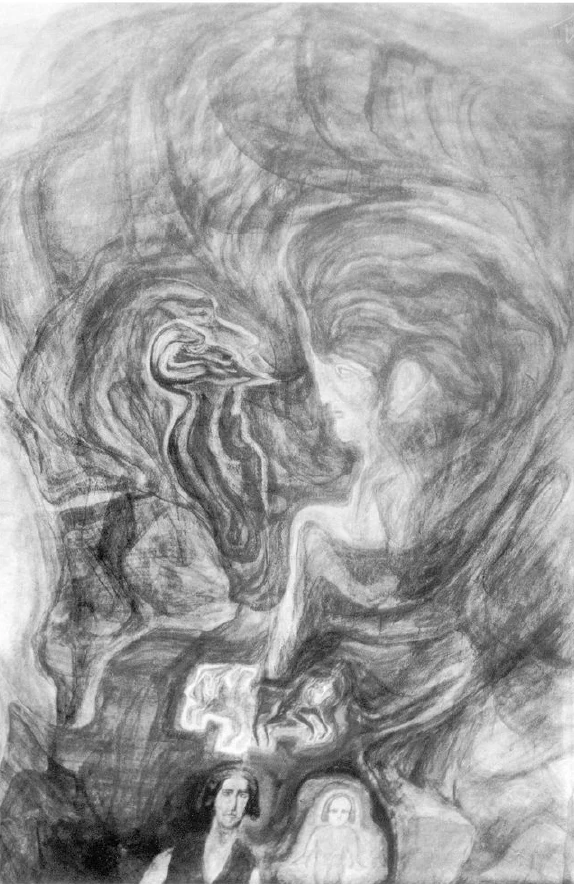 And so we come to the older Persian-Germanic initiation. This Persian-Germanic initiation is still effective in our time, but it has, as it were, something enclosed within it, the medieval initiation mentioned earlier, that is, the one characterized in the first figure. The medieval initiation is, as it were, shorter, and this one encompasses the whole long period. What matters in it is that the duality in the world - the bright, Luciferic, the dark, Ahrimanic - be seen through in its entire effect on the world. Here you have on the one hand the dark, Ahrimanic: the small head is in fact Ahriman, the other is his shadow, which he carries with him. On the other side: the Lucifer figure. You can see how this is developed in the sculptural group – you have all seen the group. So you can see how the contrast between the head of Ahriman and the head of Lucifer confronts you. And in the painting, one could also clearly express this mutual relationship between Ahriman and Lucifer. If you see, for example, how the forward thrust of Lucifer's forehead virtually takes away Ahriman's foreheads, or how Ahriman's foreheads are hardened towards the back, then you see the interplay as it is the organizing force of nature. This then goes down. You see how a kind of centaur shape corresponds to Ahriman – a kind of centaur shape also corresponds to Lucifer – that they are connected to each other, want to be apart and cannot, complement each other in the colors, and below that the Persian-Germanic initiate, who carries the child floating on his hand, pointing out how the future and the hope for the future must be taken up in man by seeing through dualism. 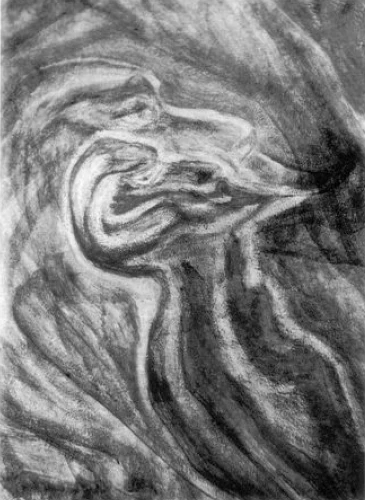 The next image: Ahriman is alone with his shadow. The Ahrimanic is therefore everything in man that works in one direction in man. The human being is so essentially that man constantly strives to keep the balance between the Ahrimanic and the Luciferic in him. The Ahrimanic is everything in us that, if we take the matter spiritually, inwardly, strives in us for the sober, prosaic, materialistic, for the philistine, for the bourgeois, for the tantric. That is the Ahrimanic, that which hardens man, that which solidifies man within himself, which prevents him from opening up to the world, which makes him absorbed in his egoism. It is that which draws man to the earth, physiologically speaking, it is that which works in man and by which he would actually be continually exposed to the danger of succumbing to hardening, to sclerosis, to ossification, if it were not for the reciprocal, the Luciferic. He would be constantly in danger of becoming diabetic, for example, or of developing terrible gouty lumps. That is the Ahrimanic. Ahriman suffers greatly from constant gouty lumps, from constant rheumatism, etc. There are things that are physiologically connected with the soul-like philistinism, materialism, bourgeois conformity, and so on, as I characterized it earlier. 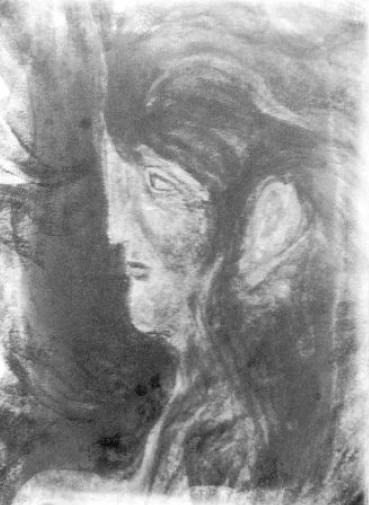 This is the Luciferian figure, the complete opposite image. It is the other side of man, that which continually causes man, in his soul, to stray into the mystical and the fantastic, continually causes him, as it were, to be a being that wants to get beyond the human head. All enthusiasm in man is that which is striven for by the forces that are, as such, Luciferian in man. Now there are two ways in which these contradictions can be present in human nature: One is that man strives to achieve a kind of equilibrium, that is, to facilitate everything that strives within him towards the philistine, the bourgeois, by also developing imagination, by also being able to devote himself to the world, and by also understanding how to bring the artistic into the purely abstract. That is to say, it is possible for a person to achieve such a balance of these two opposing currents that the person becomes one through the two harmoniously blending into each other and becoming one. But the other is also possible, that the two extremes continue to work in man, so that man does not find a balance in which they flow into one another, but that the two things are active in him. For example, you can meet mystical enthusiasts who ascend to the highest theosophical, symbolic regions, always wanting to rise above their heads, but in ordinary life they are philistines. Loving everything philistine, pedantic, materialistic, tough and so on - yes, tough! - goes quite well with mystical enthusiasm in a person. This, so to speak, obscures the balance deep within the unconscious. There, what is actually a twofold nature comes out in dualism. So in some ways, these two sides can also be present in a person, revealing themselves. One is not a philistine just because one is a dreamer. One can very well be a philistine and a dreamer at the same time. Figure 13 (Fig. 80): There you see the one who is inspired by the insights of the interaction of the dark and the light world, who must connect what is indicated by the child's hovering. 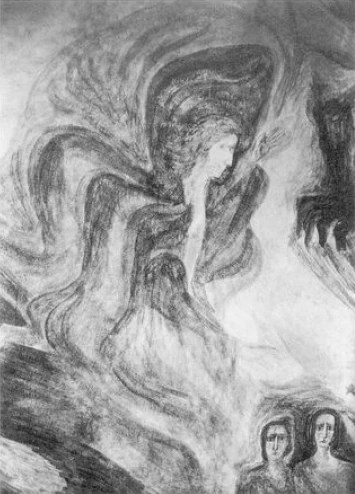 Here you see that which is already there in a certain way as an initiation principle, but which will only have its task in the future: the way in which the secrets of the upper world can be received in Slavic countries today, a kind of Russian figure that has its own shadow beside it, as so often the Russian invisibly carries its own shadow with it, always has its shadow beside it. What is inspired from above, we will then see more clearly. A centaur figure, something that is already humanly shaped or already superhumanly shaped. There is no need to decide this question, but rather to think in terms of form. In between, as a counter-image, the angelic form. Just as we have Ahriman and Lucifer in the present culture, the Germanic-Persian one, so here, where we go a little further, we have the human form, stuck in the animal, and a superhuman form as its opposite. 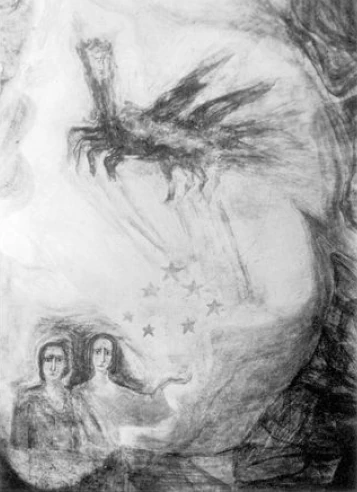 You see here above the figure still reminiscent of the animal, so to speak the animal transported into the world of the stars, the animal having become ethereal, which contains within itself the forces of initiation for this future time, when these forces on the other side – these forces, which are more of an Ahrimanic nature – are held in the balance by the superhuman, by the angelic, which approaches this figure from the other side. 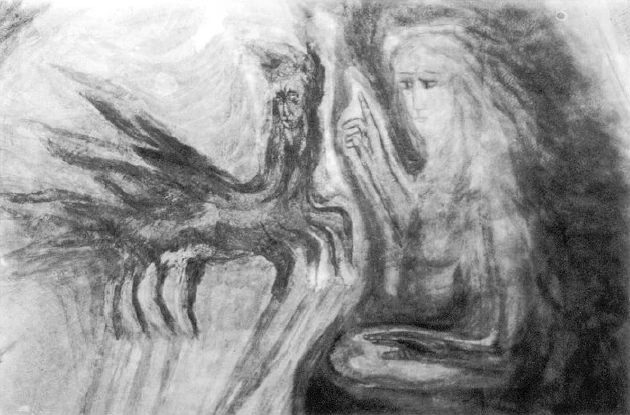 Here you have the angelic form together with the animal form, but it is something that is ethereally animal and ethereally superhuman. It is the interaction of the mysteries that work in one form or another that will bring about the initiation for the coming age. 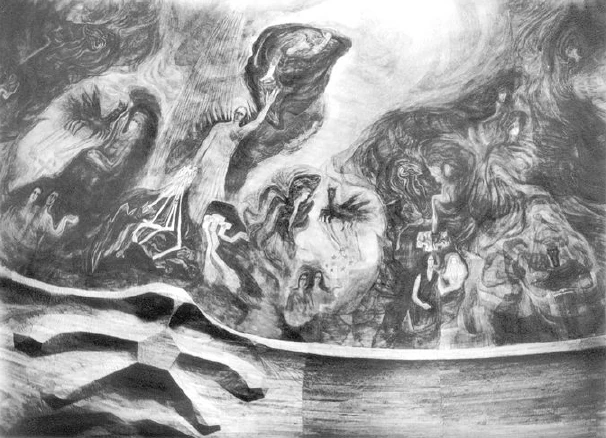 The next picture: Here you have once more, so that you can see more of it, the initiating and the initiated. Thus, an attempt has been made to put together in the dome that which leads to the knowledge of the supersensible from the most diverse human conditions - Egyptian, Greek, medieval, past, future - and from the most diverse temporal conditions. And all of this is worked out of color to such an extent that one can have the impression that the wall is destroying itself, destroying itself with something that actually has no end in the soul, that enters into the spiritual; so that the wall, through its artistic design, cancels itself out. 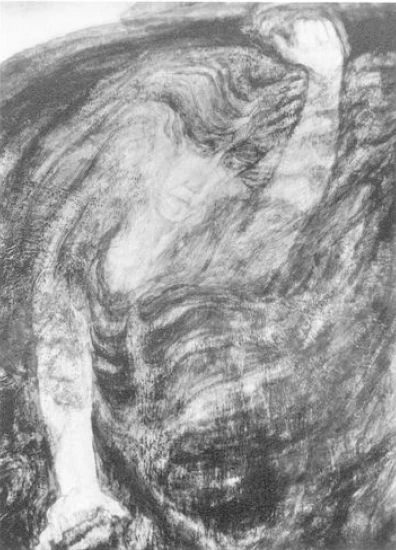 Here you see the Luciferian figure as it is in the central figure; here is Christ. You will remember that you saw it over there in the building: it is in particular red color, worked out of red and yellow. I wanted to distinguish it from the other colors; so that the whole – if one may say so – the Luciferian experience – is a red-yellow experience, from the burning, phosphorous color, from the hot color, everything that leads people to want to rise above their own heads. Everything that is otherwise in the dome and in the building in general is as if synthesized in this eastern group, in this Christ-like figure in the center, Lucifer above it, Ahriman below it, which is then completed in the rock group below. The whole mystery of man is there as a mystery: Christ, Lucifer, man, Ahriman, and thus there is a continuation of the building idea, which was found in its various metamorphoses from ancient Greek, Gothic times to our own. The Greek temple, as a dwelling for a god, had only one meaning in that it enclosed the god. One cannot imagine its forms of construction other than as the dwelling of the god. The medieval Gothic cathedral only has a purpose if the community is in it, otherwise it is abandoned. Its walling indicates that it only has a purpose if the community is in it. Inside, there should be that which leads man to self-knowledge, which presents man to himself, what man is: a being that has to seek the Hypomochlion between the Luciferic and the Ahrimanic. 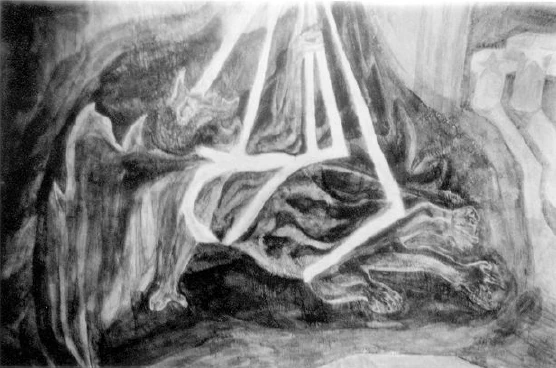 In the next picture, you can see below it the Ahrimanic, which is struck by the rays of fire emanating from the arm of the Representative of Humanity - the Christ Jesus. The Ahrimanic is also held fast by the forces of the earth. It is everything that pushes the human being towards the earth, the heaviness of the earth in the human being, just as the Luciferic is that through which the human being wants to move away from the world. The Ahrimanic: the inward brokenness, the inward heavy suffering. The Luciferic: that which leads the human being to stupefaction, to illusion, to hallucination. Here with Ahriman, everything bony, everything hardening. In Lucifer, everything feverish, pleurisy-like, etc., everything that, if developed one-sidedly by the human being, would cause the human being to burn inwardly through his joy and lust and greed and desire. The Ahrimanic: that which freezes within in pain and therefore endures infinite pain when the rays of fire come over its coldness. 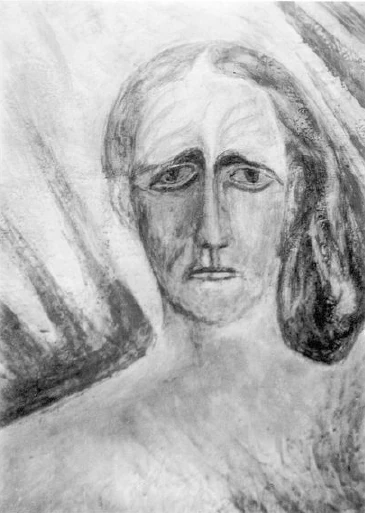 The next picture: the head of the Representative of Man, as I believe it can be fully captured in spiritual science. The usual image that one has of Christ - it was actually only in the sixth century that the bearded Christ emerged - the history of Christ portraits is extremely interesting. The Christ portraits emerged from lively discussions about whether Christ was beautiful or ugly. Of course, these discussions took place at a time when there was no longer a living image of Christ. Then the urge to capture Christ in pictures arose at a time when people could no longer depict beauty in the old Greek sense. We have to try to see Christ spiritually. And as far as I believe I can advocate the matter, it is – precisely by transforming the whole into the spiritual, which can only be seen in what has been preserved in the Akasha Chronicle – the figure of the one who really walked in Palestine at the beginning of our era. But this should not be taken as if there were a portrait study, but it can be felt that the representative of humanity is also connected with history in this way. Everything must follow from the artistic intuition itself. Now I still have a few figures in the next picture: you see the middle group here. Here the Russian initiation, above it the angel, the centaur; then this Golgotha Way, the threefold path, to Christ, to the two thieves or robbers. Here the Ahriman figure, struck by the rays of fire, then the Christ figure, above it Lucifer. Here again the other side: the angel, the centaur figure, thus the initiating one. Below that, in turn, would be the two initiators that belong together. Here you see the five-part leaf that I mentioned yesterday. Then you see the Germanic-Persian initiation, the Luciferic-Ahrimanic one, and then the Egyptian initiation. But this is already very unclear in this picture. You can still see the Egyptian initiate. An attempt has been made to photograph the object in a variety of ways. It is of course true that photography can only give the motif in the most diverse ways, which is basically not what it is all about. I would also like to mention that our building, the double-domed structure, is covered with Norwegian slate. Once, when I was on a lecture tour that took me from Kristiania to Bergen, I looked out of the window of the railway carriage and noticed the beautiful Voss slate from the Voss slate quarries. During that journey, I had the idea that it would be a good idea to use this Voss slate to cover our building – an idea that could then be realized. Those who look at the roofs of our building, as they shine, especially under certain effects of the sun in their grayish-blue, will see that this idea was indeed a justified one, to ship this Norwegian slate to the south just enough to cover this building. It does indeed reflect the sun's rays wonderfully, and the rays of light in turn. Of course, I can only give a brief description of what was attempted in this building. If you combine what I have been able to discuss, because there are pictures, with what you will see in the future, along with many other things, in general and in detail, you will get an idea of how this building should become a hieroglyph, an immediate revelation in the forms and colors of that which lies in the entire anthroposophically oriented world view. It should be presented as a great hieroglyph to the present day. And something would really be done for our time and for the near future if this building could ever be completed. It has been started with a certain devotion to the cause, started at that time especially from those areas that are now confined to world life, that can no longer really contribute because they are completely impoverished in relation to the rest of the world. Events have brought it about that precisely these regions have become impoverished in the face of world events, which first gave rise to this idea of building, and it would actually be good if so much un-chauvinistic, pure humanity could arise in the world that this building could now really be completed on the part of those regions that have suffered less from the horrors of recent years. It should actually be completed. However, if you look at everything that has been a motivating factor in the last five to six years, and if you see it continuing to have an effect on the winners and the defeated, if you see how nowhere does the realization dawn that a completely new situation must take hold, then there can be little hope that this edifice will ever be completed. But it is, my dear friends, a demand of the time, it is a demand of the future. It is something that should be understood quite differently than one has been inclined to understand it until now. And it would perhaps be the first sign of a manifestation of the will to heal the world if, let us say, an understanding were to awaken from the English, French, and American sides, precisely for the completion of this building. The first impulse came from Central Europe; the rest would have to come from those who were neutral in the last years or from those who were hostile to Central Europe, if there were real understanding. But it really seems as if souls want to continue sleeping, as if most of them say to themselves: Oh, what's the point of getting involved in something new! Things will only turn out well if we go back to what was more or less the case until 1914. Many people long for that. My dear friends, that will never come back. And those who want that, and who are working to bring it about, those who cannot rise above the idea that something as new must come among us as the architectural styles of this building here are, they are working towards the downfall of humanity. Isn't it actually, I would say, heartbreaking in terms of the culture of humanity and its development, as Dr. Kolisko had to say here a few days ago, as he had to characterize, as it were, how at the turn of the 18th to the 19th century and well into the 19th century, the Goethe culture had emerged, and that this Goethe culture has completely dried up. It had already dried up in Germany by the 1880s. Perhaps I may allow myself a subjective judgment in these matters, because I myself came to Weimar for the first time in 1889, then in 1890 to the Goethe-Schiller Archive. Yes, my dear friends, there we really were at the burial place of Goetheanism, at the real burial place of Goetheanism. And in that, there was no difference between the various nations of the world. There the German scholar, by cutting syllables, recalled Faust, together with Calvin Thomas, the American scholar, who cut syllables in the same way. People from all over the world worked there. Science had come to the point where it was far away, where it was concerned with Goethe. Truly, everywhere a cutting up of the living Goethean being, terrible, terrible! In Austria, however, which already carried the seed of destruction within itself, which, through its state-political system, carried the seeds of destruction within itself, there were still a few isolated developers of Goetheanism, as Dr. Kolisko characterized it here in these days. Then, what once existed was finished, covered up! It is up to humanity itself whether the same fate that befell Goetheanism befalls all of European culture and its American offspring. It is hard to believe, but the question for humanity today is: Do you want something new and thus save the white race from barbarism, or do you want the same fate for the entire culture of the white race as for Goetheanism? And rising above this barbarism of the white race, what will the non-white races, namely the Negroes and similar races, bring about what is now the civilized world? 1 The question today is: How many people are able to face this problem? How many people feel how serious it is today that it is a matter of the existence or non-existence of contemporary civilization? This building was intended to be nothing less than a living expression of this. It is the continuation of what European culture has achieved, and this continuation should live, not die! But this building does not appeal to an indeterminate fate, to which one might comfortably surrender, but rather appeals to something actively alive. If people want to save European civilization without this active life, without this impulse for salvation, without this will, without this act of freedom, then this culture will not be saved, and will meet the same fate as Goetheanism in Central Europe. Then one might establish large archives and do philology in these large archives about what once was in Europe. But we should not let it come to archives alone; we should let it come to living buildings, both physical and spiritual, which already announce their liveliness through their forms. I would like that to be read from these forms. Because this name, Goetheanum, was longed for by someone, my dear friends, as the final name for this building here, which has already experienced the difference between a mausoleum of Goetheanism and what could be a living organism for the Goethean spirit, but in its further development, now for 1920, in fifty years for 1970, etc. That is what I wanted to say to you today, following the description of the building.
|
| 288. Architectural Forms Considered as the Thoughts of Culture and World-Perception
20 Sep 1916, Dornach Rudolf Steiner |
|---|
| 288. Architectural Forms Considered as the Thoughts of Culture and World-Perception
20 Sep 1916, Dornach Rudolf Steiner |
|---|
| [ 1 ] Three years have passed to-day since we last gathered together on this hill, where a number of our friends met to lay the foundation-stone of this building, which is to stand as a promise that into the recent development of culture there shall break those spiritual impulses which have become for it an absolute necessity; they have become a necessity because only from those impulses can we hope for that insight into life which is necessary for the very existence of mankind, and because from these impulses alone can we hope for that loving human understanding which is necessary for human life. Three years ago we held this celebration, feeling that we were experiencing a critical moment in that spiritual development which, some of us for a long time already, and some for a shorter period, we have had at heart as the persuasive power of our lives. At that time there passed through our minds all that the human heart can feel as the progress of mankind. We did not think of what, although it was to be foreseen, still was not—by the mysterious power that is hidden in thoughts—destined to be kept in mind; we did not think then of that time of suffering and pain which has since descended upon human life in Europe. There still lay in the future, though the near future, the most tragic experience of suffering that has befallen people on this earth in our time. Whatever pain they have had to suffer formerly, the experience which has since passed over Europe is enough to make anyone despair, who lacks that power of inner recovery which springs from a profound consciousness of the life and activity of the spiritual world. [ 2 ] Now that we have worked three years at our building it seems indeed no time for joyful celebrations. We should be untrue, in a way, to our own hearts, were we to allow even a suggestion of the festive mood. We must leave this for another time, and we shall do better, to-day, to dwell—in a few thoughts re-echoing what we have already said on just this very spot—about the ideals which filled us, to some extent as an historical moment in our movement, when we set ourselves to realise this building. [ 3 ] This thought arose from the self-sacrificing spirit in which many souls, or at least a number of souls, spent year after year, while our movement gradually took shape within them. The longing of our movement to build its own sanctuary arose most vividly and forcefully in the soul of our unforgettable Fräulein Sophie Stinde at Munich—and coincided later with our need for a place in which to hold our Mystery Plays and the ceremonies connected with them. In this way the thought was first conceived of building a sanctuary for our movement and the spirit that pervades it. And from this arose the other thought, of realising our spiritual movement in the form of this building; that is, of so building this place, that in its form, in its very essence, it should be to the world a visible representation of our spiritual movement. But to achieve this, the building had to be placed like a living, creative thing, not merely on a foundation of modern spiritual life, but on all the essentials, and potential essentials, of modern spiritual life. No ordinary building was to be created for our souls, but it must realise for them a cultural thought. [ 4 ] A deep question then arose: What building does modern culture itself demand as a thought expressing modern culture? The answer depended on the knowledge that all truly fruitful thoughts in building, like all fruitful artistic impulses, have been bound up with contemporary spiritual movements, and above all with new, advancing ones. One cannot think of Greek architecture without feeling that its very forms express the Greek experience of culture: they are this culture crystallised, moulded, made to live in forms. Whoever studies deeply the Greek style of architecture will find that the achievement of this pure Greek architectural style corresponds to the emotional expression of the Greek outlook on life; it corresponds to the answer the Greek found to his tremendous question about humanity: What powers are those which are active from the moment of the earth's existence, and support the human being, so that he finds himself placed harmoniously on the earth? [ 5 ] If, creating the Greek again in spirit, we see the ancient Greek moving through his Grecian land with his particular conception of the world, with his way of seeing the world in its substance, we feel how there lived in this Greek, more or less consciously, just that power,—sprung from the forces of gravity in the earth—which was to place this Greek upon the earth with just his Greek experience of life between birth and death. This Greek experience is reflected in the beautiful proportions, in the wonderful statics of Greek architecture; it lives in that inward compactness or completeness of Greek architecture, which gives its form the appearance of growing out of the mysterious forces of gravity and balance in the very body of the earth, out of the forces which, with inner, discreet harmony, suffuse and permeate the creations of the Greek tragic poets, of Homer, and Greek plastic art, even of Greek philosophy. A great tide in art can only come from a profound understanding of the world. The Greek wished to live in the Spirit of the Earth itself. Out of the Spirit of the Earth [Geist der Erde] he created his statics of architecture. [ 6 ] Surveying the centuries which follow, we find that again, although we must speak with the inaccuracy inevitable in such a cursory survey, there develop, under the influence of the Mystery of Golgotha and from the impulses which led a part of the human race to an understanding of this Mystery of Golgotha, new architectural forms. We see that man has discovered, in addition to his earlier experience, that he does not only stand rooted in an earth- spiritual existence that lasts from birth to death, but that the universal soul pervades and spiritualises, from above, all that man effects on earth. And as an external embodiment of this gift of the Spirit of Heaven to mediaeval mankind, as the Greek received his impulses from the Spirit of Earth, we see the rise of mediaeval architecture. [ 7 ] Mediaeval architecture, again, is spiritualised, flooded, permeated by the forceful, powerful stream of the new conception of life which is passing through, and illuminating the world. I should have to go into great detail to show how the Christian spirit identified itself with art, to show how it found a home in Pre-Raphaelite, in Raphaelite art, in the art of Leonardo, of Michelangelo, in the Gothic architecture that aspires to heaven. I should have to enter into great detail were I to describe all the impulses which found such powerful utterance wherever it was sought to express, in form, the action and speech of the soul on the wings of the heavenly spirit; this expression found its consummation in Dürer and Holbein. For the soul that lives in Gothic architecture lives also in Dürer and Holbein. [ 8 ] With this hasty survey, certainly inexact, we come to modern times. And at this point the human spirit is, in a sense, brought to a standstill by the misery of the Thirty Years War which passed over Europe, particularly Central Europe, and had been preceded by a wonderful exaltation of all hearts to liberty, in such movements as that of Zwingli, Huss, and others like them. We see here, without yet being able to understand it completely, but so that it is clear, this whole misery of the Thirty Years War fanned and provoked by a spirit which already contained much of the later Jesuit spirit. And we see, under the influence of this impulse, ostensibly cultivating the spirit, just those forces grow up which have let loose materialism in Europe. We see that period approach, in which a philosophy of life, only directed, from the point of view of inner human perception, towards the material, cannot grasp the material, because it will not grasp the spirit in matter. We see a philosophy of life sweep Europe, denying freedom, because it desires to restrict everything that aspires to freedom within the limits of a rigid, blind obedience. We see the influx of a human perception—”all too human”—into the spirit that permeates history. And we see how there comes about, under this influence, the impossibility of realising the spiritual life directly in the forms of art. [ 9 ] Then there arose what one might call the ecclesiastic Baroque art, which is through and through a faithful expression of the new era, but in which human thoughts, human perceptions, are expressed in a subjectively arbitrary manner in artistic form and works of art. We no longer see the soul's urge to participate in the mysteries of earth-statics and earth-gravity, as it did when it built the Greek temple; we no longer see the soul directly expressing its experiences when it loses itself in heavenly heights, as it did when it created Gothic art, when Dürer adapted his profoundly expressive figures to the experiences which saturated his soul. We see rather the attempt everywhere to imbue potential architectural thoughts with human reason, with human, all too human, feelings. We see introduced into the pillars, into the element of support, all kinds of figures which have no architectural function, which originate in human design and are there only for decorative effect. There is no knowledge of the clear distinction between a plastic and picturesque thought and an architectural thought, and yet no power to combine—because of the inability to differentiate between—these different kinds of themes. We see that there is now employed a sham inwardness to support a conception of life no longer filled with its own true inwardness. [ 10 ] We enter many a church building whose pillars we no longer understand because they have not been constructed from a study of the objective facts of the world, but betray the fact that people's conception of the cosmos itself in all its spontaneous elementary power has vanished. Here we go along colonnades where pillars have shapes which are not architectural, but picturesque; recesses are marked by pillars in picturesque manner. But the secret and mysterious should speak from such recesses. And the way such pillars have to support what they have to support should look as a secret. We see human saints introduced in the most impossible places, not springing from a spontaneous architectural necessity, by which plastic art and painting grow out of the architecture with inevitable right- ness. We see art expressing what has no direct connection with a vision of the world; we see the materialistic conception of the world develop, powerless, however, to create for itself a real, appropriate form of art. [ 11 ] It was not a long way from this to the path which led to the degeneracy of the Baroque style, that style which is so particularly interesting and significant because it shows how this later period desires to live itself out in its own unspiritual way—but how it is unable to find any sort of original artistic thought, but only the thought of the commonplace, with which people are filled and which they can express more or less inartistically. This is particularly clear when the Baroque style is, as it were, taken by force from the Jesuits by Louis XIV and translated into worldly terms. Certainly humanity was always aware that monumental art must be connected with the highest and best of which humanity is capable, when it sinks itself in the universe. But with the new human, all too human, perception, there was intermingled—in a somewhat frigid and academic form—a renewal of antique art, not more than a dash of it, with the Rococo, which we often see mixed grotesquely with the antique. Thus we see, precisely in the art connected with the name of Louis XIV, the apparent severely classical forms concealing all too human Rococo forms, where the human spirit is not seeking admittance to any universal mysteries, however close at hand, but is only desiring to perpetuate its whims and fancies, its everyday feelings and perceptions in the forms which appear around it on the walls. [ 12 ] Thus we see how edifices arose—for certain reasons I do not wish to mention individual buildings, because they are not properly judged by our times and my valuations therefore would not be understood—which, judged by the inner necessities of art, are simply human champagne-whims poured frothing into forms. We see the Rococo Voltairianism of thought reappearing in countless places in the Rococo treatment of artistic form. This, however, is not adapted, like Greek or Gothic forms, to the very essence of man's conception of the world, but is like an external copy of human inner experience. [ 13 ] Then we see, in surveying further the development of human art, that in the eighteenth century a human yearning turns to the past to revive the Greeks—Greek taste, Greek art. We see a spirit such as Winckelmann seeking a truly religious consecration in an understanding of the Greek spirit, of the Greek art-spirit. We see the nineteenth century, inspired by Winckelmann, aspiring to recreate those artistic forms. But the philosophy of materialism was never able to win the power, the inner power, by which what is thought, felt, inwardly experienced, is so deeply thought, felt, and experienced, that it overflows as though of itself into its own forms, as it did with the Greeks, as it did with Gothic art. Thus we see, in the nineteenth century, that wonderful, yet, after all, curiously superficial, aspiration of an Overbeck, of a Cornelius, to create forms, to create artistic figures, yet without that permeating impulse of a world-vision. Old motifs, old philosophies are hunted out; old ideas are to live again. [ 14 ] It was architecture that chiefly suffered under this powerlessness of modern materialistic thought. Beauty—beauty, in the grand style, was achieved by the architects of the nineteenth century in the revival of antiquity. But everything is prompted by the impulse just described. Study such a wonderful revival of the Renaissance as that brought about by Gottfried Semper—you can study it at the Polytechnic in Zurich—and you will see that it is impossible for the deliberate architectural thought to catch that spirit of which it should be an expression. [ 15 ] Thus we see the time approach, when architecture, with a certain greatness, because it has wonderfully studied old forms and can use them, reveals its impotence in the face of the higher impulses of human development. We see Greek forms, just like an outer husk, built round those great buildings which actually only shame what they do not understand, as many a modern architect has done, when he has evolved Greek forms like husks round modern Parliaments. Or we see architects, with a profound knowledge of Gothic art, yet far removed in heart and soul from Catholicism, build Gothic forms around what should be the essence of the Gothic building, but which is completely foreign to their feeling and perception. Thus we stand before these buildings with a finer sense of art if we can feel: these were built by people who are really far removed in their hearts and perceptions from the sacrifice of the mass and all that is celebrated here. [ 16 ] What a different experience is ours in the buildings raised by those who still had sympathy with the old Christian feelings, common in the times when the Host was elevated for Consecration with different emotions from those of a latter day; what a different experience, where mysticism was incarnate in the building, compared with the cold life of the present age expressed in the structure of the spiritual-social life of humanity; how different are the buildings where, in the fitting in of stone to stone, there is no flowing in of sacred action or of the tremor of emotion in the human soul. One often feels about art of this kind—if one really contemplates art with sympathy—that an atheist is painting a Madonna. [ 17 ] Only from this kind of discrimination could there proceed the impulse to the cultural thought necessary for our building. The old impulses can no longer be brought to that degree of vitality at which they can live themselves out in forms. Anything created in the old forms can only be antiquated. But we may well believe that our spiritual science has such an inner vitality as to be able to give birth to forms of its own; such forms, indeed, as we believe to have proceeded through an inner living process from our spiritual scientific conception of the cosmos, and as desire realisation in our building. These forms should manifest again that connection between art and the cosmic conception, which is inherent in the fact that only he can paint a Madonna who has an impulse in his soul towards the feelings for a Madonna. People to-day cannot feel this impulse in their soul to the extent that they can truthfully create artistic forms from it. [ 18 ] If mankind does not wish to reduce itself ad absurdum new impulses must come through spiritual science into humanity. We must therefore make a start with new artistic forms which must be the natural fruit of a new world- outlook. Whoever wishes to understand rightly the meaning of the building whose foundation-stone we laid three years ago, must understand it by a living understanding of our spiritual scientific conception of the world, must understand how this, no more than a beginning, flows from a synthesis between a comprehension of heaven and earth, which we call the spiritual scientific conception of the world. This should arise just as Greek architecture sprang from the Greek conception of the earth, and as Gothic architecture grew from the conception of heaven held by mediaeval Christianity. [ 19 ] We should be stupid indeed to imagine that anything considerable, in the highest sense, not to mention anything perfect, could be achieved at one stroke. We shall never be able to do otherwise than admit that what we have begun is very imperfect; a first tentative groping towards forms which must arise and yet in very many ways be completely different from those evolved by our building. But it is at least easy to see from our building that it is a trial of the spontaneous growth of artistic forms from the urge and the perception that pulsate through our vision of the world. It is because so much in it is new that those who will never tolerate anything new cannot understand—and naturally so—anything so different from what has hitherto been experienced in the former kind of plastic art and painting. Only if we humbly see imperfection, and an inadequate beginning in our building shall we develop the right feeling, with which the beginnings of any evolution should be regarded, when the imperfect beginning is nothing but a stimulus to so much that is still to be created. [ 20 ] We have now worked three years at the building, and those whose hearts are bound up with the ideal it expresses will now be filled with a warm sense of gratitude towards all those who have made their sacrifice to bring this about—a sacrifice in one form or another—and who have further expended their energy upon it—for a great deal of beautiful, splendid work has flowed into the building which we see before us on the Dornach hill. [ 21 ] If these three years have also brought with them difficult food for thought and difficult experiences for our movement, we can still say: Whatever turn things may take, whatever may be in store for our movement in the lap of Karma—what we have been able to experience in connection with this achievement is precisely a profound experience flowing from the very essence of our movement and can be reckoned among the most beautiful fruits of modern experience. [ 22 ] We have seen many a metamorphosis of this experience; we have seen, for instance, many people, like our unforgettable Fräulein Stinde, whose whole heart and whole soul were bent upon erecting this building in Munich, sacrifice their desires with deep devotion in order to participate in the transformation of their plans destined by Karma. Whether the resolutions formed at that time, to effect this transformation, were absolutely right, only the future can show, when the facts prove how far the culture of the present day is taking up the anthroposophical movement. Much of what could be expected is still unfulfilled, and it would sound like foolish boasting if I were to mention only some of the expectations which could rightly be described as disappointed. [ 23 ] The building was there. It revealed even in its outward forms the existence of a movement of some kind. Let anyone turn to the bibliography of our movement in many languages in the educated world to-day, and let him see from it how much opportunity there was of understanding our movement, how much opportunity was given of connecting the building on the Dornach hill with certain essentials in our cultural movement. It was all the more to be expected that, at the present time, which has imposed so severe an ordeal on mankind there should be heard, precisely in view of this difficult time of suffering, expressions of sympathy with the deeper cultural significance of this spiritual scientific trend. Of such voices we can say that not a single one was heard from outside, during the terrible time of suffering and war; only a few isolated voices were raised within the anthroposophical society itself, and, because the outside world showed so little understanding for the movement, these died perforce on the wind. [ 24 ] Thus, to-day, when we wished to look back to some extent on the impulses which inspired us three years ago, we can only pledge ourselves anew and with the greatest solemnity to remain true to that impulse, to win understanding for the contribution of this spiritual scientific conception of the world, and all that it involves, to the development of humanity. From outside Europe, from distant Asia, opinions are being formed on the European situation which are in a way more illuminating than the war that is raging through Europe. But just these opinions show that the re-birth of Europe is only possible through the spiritual scientific conception of the world. May this eventually meet with understanding. [ 25 ] We suffer from the Karma of thoughtlessness, that thoughtlessness which is at the same time I brutal, because it desires everywhere to crush underfoot any glimmering of the spiritual necessities underlying the development of our time. It is remarkable. The yearnings—as I have often said—are coming to the surface everywhere, yearnings which do not understand themselves because they do not know what they want, and because they cannot, in the brutality of the times, find the way to the vision of the world of which our building is a monument. Whoever contemplates this age at all finds many signs of the times; but they are all signs of longings. [ 26 ] We find, however, a queer fish of a fellow, a simple journeyman carpenter, who is a living refutation, through what he became, of the senseless idea of modern times that spiritual science is only for educated people and not for simple souls. This is a senseless idea; for just the simplest souls are aware of those longings which could actually be satisfied within them if they were not repressed by the so- called brutal culture of the times. What longings are voiced in words like these of a simple carpenter, who has read a few books and taken stock of the aims and possibilities of the present day, and who expresses himself in these lines:
[ 27 ] Let us go out to meet the longings, and find the way to those whose hearts are full of yearning. We can look from this simple journeyman carpenter, a queer fellow, as I said, who tried to fight through from knowledge to contemplation—to the man whom I have mentioned before, Christian von Ehrenfels, who is Professor at the University of Prague, and who attempted in his Cosmogony to imagine a “Retrospective Vision,” in which we see longing, inclining towards the attainment and acquisition of what can only be attained and striven for precisely through spiritual immersion in a backward-looking vision. [ 28 ] The thick night of modern so-called philosophy naturally allows such spirits only a limited vision, while permitting occasional glimmerings to shoot up within them; but the stultifying culture of the age restrains them from an understanding of spiritual science. Their longings get no farther. But these longings are sometimes quite curious. And this Cosmogony of Christian von Ehrenfels has a remarkable conclusion. This professor attempted, in his way, to contemplate the world and the course of the universe, he attempted to get a clear conception of the needs of the present day by studying the course of history; and what is his final word? — [ 29 ] “In this sense, and from this point of view, I have sought to understand the history of mankind, and have come to the following conclusion—which, however, I am enabled to impart for the first time without the armour of scientific argument, and simply as the result of expectant awareness; “In God, with the elevation of the human intellect (and probably with similar processes on other heavenly bodies) consciousness awoke and a deepening process began in His activity. “In, and with man, God is seeking a guiding principle capable of directing this hitherto impulsive creation into paths of conscious design. This principle is not yet found.” [ 30 ] You must remember, such a man naturally calls the nearest spirit he senses his God, as does, for that matter, the whole present age. But he understands from history that he lives in a time when this spirit, near him, has some plan for mankind and stands at a critical turning point. So he says: “In God Himself a phase of deepening has dawned in His activity.” He feels so much. “In and with man” (he goes on) “God is seeking a guiding principle.” As a man he feels himself incapable of thinking out guiding principles, guiding purposes; but he senses a God who seeks guiding principles “capable of directing His hitherto impulsive creation (the Creation of God) into the paths of conscious design. This principle is not yet found.” This is how the book closes: may some God, hovering somewhere about, find a guiding principle somewhere in His impulsive will. This is how a philosophical book ends, and one that has been written in the immediate present. [ 31 ] Wherever we look—the two examples I have taken, that of a journeyman carpenter and that of a university professor, could be multiplied by hundreds and thousands—everywhere we should see that there are longings to be satisfied by the message of our building. When people understand how this building had to be kept free from all conventionality, and that thus only the spontaneous perception flowing from the spiritual scientific conception of the world can be embodied in it—when people understand how, on the other hand, we had to keep ourselves unsullied by that superficial symbolising practised everywhere by abortive, superficially occult societies and societies aspiring to occultism—when people understand, how, between the conventionality and the shallow symbolism of the present day, we had to seek truth in this architectural thought, people will at last discover in this memorial the fruitful seeds and productive impulses of spiritual science. [ 32 ] If, with all that the future may bring forth, we absorb this desire, this experience in our soul, the building will be for us, even in what it has been since it was built three years ago, the beginning that we felt it to be, when we laid the foundation-stone, at a time when we were filled with our spiritual scientific ideals. Let us feel this particularly in the midst of an age in which quite a different impulse is reducing itself ad absurdum: let us try to feel how one thing is connected with another: we shall see that we can feel this if we will. Much, indeed, has not yet been brought to pass through this experience. But in many of our souls an honest, genuine will is alive; and this honest, genuine will, if it is true to itself, will add understanding to its honesty of purpose, and then in all our souls there will be formed that other foundation-stone, which will bear into the world, spiritually and in abundant variety, the building that we strove to raise up for our ideal—over the physical foundation-stone which we entrusted reverently to the earth upon this hill three years ago. |
| 288. The Building at Dornach: Lecture I
23 Jan 1920, Dornach Translator Unknown Rudolf Steiner |
|---|
| 288. The Building at Dornach: Lecture I
23 Jan 1920, Dornach Translator Unknown Rudolf Steiner |
|---|
[ 1 ] As a sort of episode inserted between the lectures now being given, I should like to-day to bring forwards a few things about our building, so that our friends may find in what will be said, a sort of foundation for their own work. We shall have, in the near future, to take strong measures in different directions for the benefit of the cause, so that the Dornach Building, the “Goetheanum”, should be made the centre of the movement for Spiritual Science from the point of view of Anthroposophy for which we intend to work. It would be of great importance if the Goetheanum could also be made known to the outer world, so that those who have not at present an opportunity of seeing it, may become acquainted with it. The very way in which this building is put before the spiritual culture of the present time may, if brought to the consciousness of our contemporaries in the right manner, work in the direction, which we consider is the needful direction for the age. So to-day, when I have said, I wish to provide a foundation for that which others will carry forth into the world, I will once more give you a little of what I have already expounded here in other connections, so that from what is contained in these episodic lectures, a complete conception of the whole may be formed. [ 2 ] To begin with, it must be stated that the Dornach Building has grown out of the Anthroposophical conception of the world. The Building was able to grow forth from this for the very reason that when this conception is rightly understood, it will itself possess the inner force with which to create its own artistic forms and figures. Once again, I should like to repeat what I have said before in other connections, that if any of the spiritual tendencies of the present, which with their various programmes come before the world to-day, had at any time required a building of their own, some architect or other, and some artist or other would have been approached, who would have built a house in such and such a style, in which the movement it was built for could have been carried on. There would have been an external relation between what went on within it and the building itself, which might be either of the Renaissance period, or of ancient Gothic style. [ 3 ] There must not be any such merely external relation between the conception of the world which is to be given forth at Dornach and that which encloses its activities. The relation between them is to be an inner one. Every detail connected with the housing of our activities, every detail of form and figure had to proceed from the impulses of this world-conception itself. If you bear this in mind, you will see, that this is connected with the position Spiritual Science or Anthroposophy claims in the whole development of mankind. The life of modern humanity has become simply intellectual; it has become so because for centuries modern humanity has hardly received any other education than that of thought. When forms have to be created, people turn to those already existing to some one or other of the old styles of architecture; just as when they wish to make anything artistic or such-like, they do not turn their minds to the conception of the world, but to something which has been substituted in its place. What actually brought this state of things about? [ 4 ] You see, in everything of note in human culture there have always been two streams flowing together. The presence of those two streams can be traced far back in the historical development of mankind. One of these, which has achieved its greatest intellectual development in the last few centuries, can be traced back to what we may call the Old Testament outlook on the world. We must never lose sight of the fact that one of the essential tenets connected with this was the command: “Thou shalt not make to thyself any graven image of the Lord, thy God”. The pictorial representation of that which is of a spiritual nature, was lacking in the one stream of human development. And this still holds good up to the present day in the modern development of this stream. [ 5 ] Many schools of thought and of philosophy, many different sciences and popular conceptions of the world have been built up, but none of these have, of themselves, succeeded in creating artistic forms. All that has been achieved is the establishment relationship with the inartistic element of the present day conception of the world. Our modern age is not concerned with creating new forms, or with giving shape to what is capable of representation. [ 6 ] But really there are two entrances into the world of the spirit; it may be entered in the intellectual way in which it is penetrated by the monotheistic religions, in which case the thought element, the intellectual, is principally developed. By this means great progress can be made along the lines followed in our most recent times. Or, on the other hand, the element which is to be found in the imaginative may be cultivated, the element of vision, of life in course of formation. modern humanity has not much living relation with this latter element. It revives bygone styles, old methods of artistic representation, but never identifies itself with them. Indeed, things have gone so far that, on the one hand those who wished to create artistically had an actual fear of every kind of philosophy, for it is quite reasonable to stand in some sort of fear of the modern world-conception, which is imaginative an intellectual. Put on the other side this has been a great disadvantage in another sense to the development of modern humanity. This disadvantage itself is the sign of decadence of recent times. Some time ago in this very place, I drew attention to the fact that in all the present struggles of humanity there is something of the Jehovah-striving of the Old Testament, that in a sense an endeavor was being made to make each individual people what the Old Helm wanted to make of themselves and that Christianity, as such, has not fully entered the hearts of modern humanity. And so a certain intellectual thinking, an intellectual feeling concerning humanity as a whole, has in a one-sided way grown up round our social life. But man as man, 0r man as a community, can never be understood from a purely intellectual standpoint. [ 7 ] What man is, that in him which enables him to take his place in social life, can only be understood if we rise to imaginative conception. Anyone who is acquainted with the law to which such things are subject, is aware that even the Fairy Tales, the legends and various mythologies contain more wisdom concerning the real nature of man than does modern science, which does not even possess the means of giving man an explanation as to himself. People are afraid of the inpouring of the spiritual, which can only manifest in our human civilisation in the form of pictures; they dread it. But our civilised life will never be raised until men's hearts are once again filled with a conception of the world not only capable of forming from itself thoughts, but of creating forms and permeating the whole of life. We want to make a beginning, yet in its own way it is intended to show all that can be accomplished by a really creative conception of the world at the present time and more especially what it must do in the future. In a sense you see before you, in a picture, all that is characteristic of the conception of the world which is studied here, when you are confronted with that which is meant to be representative of it, when you see the Goetheanum on its hill, at Dornach. [ 8 ] If we wish to describe in a few words the special characteristic of this conception of the world, it is this: The realisation that in this age a new spiritual life must be revealed to man. And as we approach the building which is to stand for the spreading of this new spiritual life, we cannot but feel that a new revelation is to he made. Anyone who draws near to it cannot help feeling that something will reveal itself here, something new in the development of humanity. The very shape of the building impresses you with the sense of something new making its way into the development of man. Two cylinders of circular shape, in neither of which is the circle complete, covered with hemispheres equally incomplete, expresses the duality of that which is revealed and of that which comes to meet it. The very predominance of the two domes conveys an impression to the observer, as he draws near, that something is enclosed herein, something enclosed but which intends to make itself known. [ 9 ] Do not take what I an now saying in a symbolical sense; take it in an artistic sense and you will then develop the right understanding for it. I shall have to speak further about these things, but this evening we will begin by making a survey of the different effects produced by the contours of the building, seen from without. Let us begin by supposing that someone approaches if from the North-East from any point around the hill on which the Goetheanum is erected. He would then see a Building (Picture 1) which could be in no other form. This is the feeling which ought to be experienced, when directly confronting that which stands as the representative of a new world-conception.    [ 10 ] It is first of all necessary to study the different forms. It was in 1908 that the thought first occurred to me to erect a building with twin domes. But much of the original plan had to be altered, for it had originally been intended to put it in a city, in Munich, where it would have been surrounded by houses, where the outer architecture would not have had to be so much considered. When the building had to be remodelled to stand upon its present hill, it became of course necessary to so plant the outer architecture that it might produce the right effect from the different points of view in the neighbourhood. Here let us begin by noticing that the building stands on a sort of platform, not absolutely on the ground.  [ 11 ] We now draw rather nearer to the Building and this is a picture of the principal entrance. Kindly observe you begin by entering the substructure and that, as we shall see, the staircase by which we ascend to the auditorium belongs to the substructure of the Building. Having ascended that, we then enter by the main door into the real Inner Hall. The Building stands rather above the level of the actual surface of the ground. It will be apparent to anyone who approaches the Building, especially when he finds himself opposite the main door, that an attempt has here been made to depart from the usual purely mathematical-geometrical-mechanical structure forms, and to discover organic ones. Of course those people who are quite accustomed to the old conception and who believe that the geometrical-dynamic can alone rightly hold a place in the art of building and in architecture will have many objections to bring against this introducing the forms of architecture into organic forms. All these objections are known. But here we have actually dared to make the attempt. [ 12 ] Then, however, we had to think the whole thought of the Building as of a living organism. No one will understand what I mean by this, unless he himself really makes the endeavour—which very few people will do as yet—to turn his feelings away from all that is symbolical and intellectual, from everything merely mechanical and mathematical, and allows himself to be carried into a really organic-artistic, a feeling way of thinking. This does not imply that the form of an organic being is symbolically expressed in the structural forms, it means that in order to understand an organic being we must realise that a quite special sort of intuitive thought-form is necessary. We shall have to become accustomed to these intuitive forms of thought. And we then ought to be able to find these architectural forms even coming of themselves quite originally and elementally, out of the intuitive thinking. [ 13 ] I should like to draw your attention to something of which most people in the present day have no suspicion. It may be said that in nature there are organic forms. Structural forms are made, more or less modelled on some such organic forms in nature, structural forms which in a sense are a symbolical expression of the organic forms of nature. But nothing of that kind has been done. There is no direct prototype in nature of structural forms here. And if a man seeks for such in nature, it only shows that he has failed to understand the whole basic thought of what is in question here. [ 14 ] To be capable of understanding an organism is a very different thing. For when a man really understands a natural organism, he then possesses a kind of thinking which is able to find organic structural forms quite independently of nature. But such forms as these must be discerned in complete independence, they must be created from out of their own form-essence. They will then, if they result from a real living structural thought, bear the nature of the organic. What then is the nature of the organic? Well, take as an example the most complicated organism, man, and then take merely the lobe of his ear; if you have the right intuitive thinking and feeling, you will say that the lobe of the ear, situated where it, is, could be no other than it is; in its place it must be just as it is. It is the right width, the right height, and is properly rounded off, and so on. And this must be so in every single form in this organically conceived Building. Each detail, in that it represents a part of the whole, must make evident in its own form that it is indispensable. The very smallest appendage in the different parts of the Building must be as manifestly indispensable as the lobe of the ear, or an arm or a hand is to the human organism. [ 15 ] Nothing here has been copied from nature. And if these forms remind anyone of this, that or the other, it only shows that he is not judging of the Building from the standpoint of Art, but that his opinions are inartistic. If the forms in the Building remind one of anything—and what is there that people have not been reminded of—human eyebrows and eyes and so on—that only proves that he is judging of each thing on its own merit, especially; whereas each detail in the Building only has a significance in its connection with the whole and must be so understood. The next picture shows the same, a little nearer. 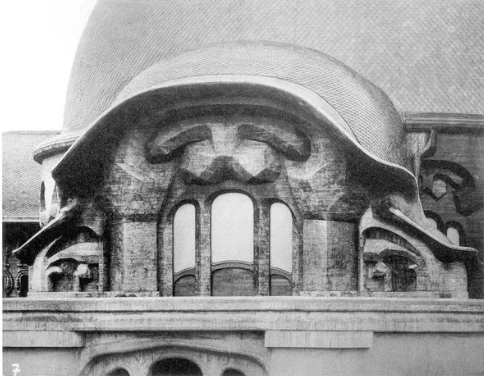 [ 16 ] Below we see the entrance; facing us are the cloakrooms; and to the right and left, where the substructure extends in a circular direction, is the well of the staircase. We then go up the stairs and through the main door, by which we enter the inner building. The motive which we encounter in the main entrance is one if those organic motives to which we have been referring. If you take the various motives that are to be found on the different sides of the Building you will find that they are always formed in accordance with the organic principles of metamorphosis, so that the one always grows forth as a development of the other. For instance, look at the motive here, above the principal entrance. If you can feel it in its forms, you will feel the same form again in the motives of the window of the side-terrace, which you can distinctly see here to the South. (Figure 14) The motives of the windows are apparently quite different. But in studying them you will see that they develop out of that one over the principal Entrance in the same way as, according to Goethe's principle of Metamorphosis, the different organs of the blossom develop from the leaf. It is again a metamorphosis of the same motive. We can only develop a living thought of the Building, if we really inwardly and intuitively grasp the principle of metamorphosis. [ 17 ] In what is attached right and left of the Principal Entrance you can see that the attempt has been made, just as it is in nature itself, to cause one motive to proceed out of another; although there has been no copying of what is organic. In every line and surface you can see that they all proceed from the same principle—like that same principle which causes the cheek to be carried from the temple of the forehead in a human face. The evolving of the cheek from the temple of the forehead might really be taken as a subject of inner study. Only while doing so we must be free from the purely intellectual ideas of the world. We must be able to view the world in forms, without beginning to symbolise. We then shall be able to see how one surface, one form, proceeds out of the other in such a way that they might really have grown forth; and besides that, they really belong to the place where they are. [ 18 ] Now in the whole of this building there is not a single thing that is mere symbol. At the time when our movement still had many people in it who were full of sectarianism and false mysticism—which tendencies indeed I had to fight over and over again—but when there were these tendencies in the different persons who came into our movement from co many different quarters, persons of artistic natures who happened to come among us were often horrified at this tendency to symbolise. These members valued a Rose-Cross, a cross with seven roses, far higher than a really artistic motive. Now in this building we may say that this has been definitely overcome and that what is really creative in a conception of the world has been expressed in forms without any transition though the symbolical.  [ 19 ] I want you to notice that in the forms, (though of course all this is only a beginning) an attempt has been made so to shape the surfaces that they lean towards the corresponding centres of support. (Kräfte-Lagen). For instance, if you go in at the principal entrance of the substructure, you will see the arches. If you study the forms of these arches you will find them so constructed that their lines follow the distribution of weight of the building. Towards the door, where the weight is less, the arch is wider; where the arch curves towards the building it bends inwards, the curve is arrested. Thus the forms of the arches correspond to the distribution of weight. If you can feel the forms in this way, you have grasped a structural thought.  [ 20 ] We now obtain a view of the North side. In the part between the principal entrance and the one wing, you can see the motive of the principal entrance in metamorphosis. There you can study the metamorphosis of the separate forms, which allows for the motive of the side-wall which is to follow. When you go in at the principal entrance the motive meets you, whereas here you pass it by. An organic structural thought should express whether a motive is one that is to meet the eye, or is to he passed by. It is the same motive, in different states of metamorphosis. Similarly that which finishes it above, which overhangs the motive—is only a metamorphosis of that which is the motive of the main portal. it is differently formed, but has only become different in the course of its metamorphosis; it is the motive of the principal entrance.  [ 21 ] Here you have the side-view of the side-terrace. In the motive of these windows, you can study how organic shapes are formed. The motive completing the windows above is precisely the same as that you have just seen over the windows and the motive over the principal entrance, only in an organic growth it is the case that metamorphosis comes about through that which in the one structure is wider and more forceful, becoming contracted and condensed in the other; what in its earlier state as in a more primitive form, extends to more ramifications. It is just in this that metamorphosis consists, and here you can see it carried out. [ 22 ] And I should like to draw attention here to the fact that in the whole building the endeavour has been made to develop structural truth, architectural truth. That is actually very little understood in the world to-day. You can here see the overcoming of the mere Renaissance idea. The setting of windows is not merely decorative, but as you see it arises from below. In the whole building there is not anything to be Nothing in this building lies, whereas in the present-day conception of architecture there is an enormous amount of untruth and deception. In our civilisation there is so much untruth in our forms that it can hardly be wondered at that so much of what men say is untrue too. Here the endeavour has been made that everything shall absolutely and truthfully express what it actually is. This can never be the case in symbolism, which always contains something arbitrary. I want you to take note of this. 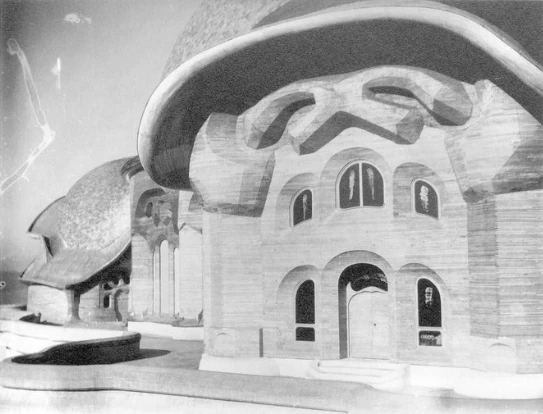 [ 23 ] Here we have the facade of the side terrace. You see in metamorphoses that which is above the principal entrance. Of course, you must bear in mind that whatever you see here is nothing but a new beginning. I always say over and over again, to all who will listen, that if I had to construct the building over again, it would be very different. This is just an attempt. But in its different parts you can see what we really intended, how the organic structural thought has been carried out, and how, for instance, the merely mathematical-geometrical-dynamic column formation has been developed into the organic, so that nowhere is the principle, merely of support or of burden in evidence, but everywhere the principle of growth can be seen, the coming forth of one from another. And as we shall see tomorrow, there is a marked effort to carry out this idea in the architecture of the interior. 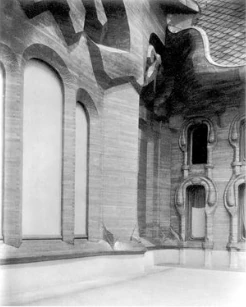 This is the juncture seen from the side, seen from the corner.  [ 24 ] The model of the building. Here you have the picture of my original model. I wanted first of all to give you a conception of the idea one receives in approaching the building. I wanted to show you the effect it ought to produce when you walk round it. now show you the inner part, in my original model, carried out in wood and wax. This model was the basis of the whole building. You see it here cut in two through the centre. You can thus see under the great cupola.the seven columns which, in succession, encircle and enclose the auditorium. Here in the middle is the place of the Drop-Scene, and here beneath the smaller cupola you see 6 of the 12 columns which encircle that space. As here seen, the building is divided from West to East. In the East will stand the principal Group: the Representative of Humanity, in the midst of the Luciferic and Ahrimanic elements. Concerning the principle by which these columns with their capitals and architraves were constructed, I shall steak tomorrow.  [ 25 ] Here we have the ground-plan of the building, the principal entrance with the staircase on either side, the auditorium, and the space beneath the small cupola, the place in which the Mystery-plays and the Eurythmic-representations and so on, will be given. These two spaces will be divided by the curtain. On the line dividing the two will be the speaking-desk, on both sides of this dividing line are the two side-alleys, for the use of those engaged in the representations, and their dressing-rooms and so on. [ 26 ] This ground-plan will show you that certain things were indispensable to the building. Whenever I refer to this ground-plan I am always anxious lest the actual structural thought should be misunderstood. I once gave a lecture in Dornach on this ground-plan and its form, drawing a comparison between it and the human form. Some of my listeners jumped to the conclusion that the building was a symbolical image of the human form. That is absolutely not the case; but if a man is able really to understand the human form and how on the one hand it is an instrument for thinking and on the other hand for willing and that both these are held together by the power of feeling; if he understands the whole human structure, the formation of the head, and limbs and the trunk, with the heart system as the centre, he then would also be able to construct other organic forms. And this is one of these other organic forms. On this account when one sees this and the organic form of man together, it is possible to find a certain relation between them. But there is absolutely no question of the one being modelled on the other, for the Building here is in its organic architectural form constructed from out of that which is organically creative in nature and from cosmic activity itself. You will be able to see the same in the transverse section that I will now show you.  [ 27 ] The small cupola, as connected with the great cupola. This cut through the centre from East to West. The whole Building has but one axis of symmetry and everything is arranged in accordance with that. That necessitates the structural thought being a living one, for the more highly evolved organism develops along a certain axis. Certain lower organic forms alone evolve from the centre; and we may take it, that as a result of the attempt that has been made here, certain more perfect forms of building than the centrally constructed (Zentralbauten) ones, will be developed, because a first beginning has been made to follow the principle of organic growth along an axis.  [ 28 ] Here you have the vestibule into which one enters through the door of the substructure; and this is the stairway by which one ascends to the terrace. You see that, forming part of and attached to the balustrade of the stairs is a remarkable structure. What this actually is can perhaps only be completely grasped by one who is able to look away from everything merely intellectual, in order to see only the artistic. When this form was about to be made, I said to myself: anyone going up these stairs must have some sort of halting-place, to bring about in him the right frame of mind. Now just look at these three directions of space. But it will not suffice to look at them, you must notice how they droop over and bulge out, how weighty they are, bending over with their own weight. If you take the whole form into your feeling, they will be to you,the expression of the mood which it would be desirable for you to have when you ascend these stairs. Anyone who goes up them will have a premonition that here, in this Goetheanum Building, he will find something which will give firmness, security and strength to his life, which will give him something to his balance. One ought to have that feeling here, for simply from that feeling did the form arise. I might say that besides this, one should feel that the form must be what it is, for although it is not slavishly copied from them, it does resemble the three semi-circular canals which form the small auditory bone of the human ear. If this organ of the human ear is injured a man falls, he loses his balance. It is an organ of balance in the human organism, a diminutive organ of balance. [ 29 ] Now one cannot help feeling that there must be something here to help us to enter the Hall in a properly balanced frame of mind. This is no puzzled-out idea, it has been really felt. If one takes it as a thought-out thing, it will be his own fault, for it shows he has begun by reflecting and digging down and speculating. There should be no question of speculating or puzzling out, but of feeling the heavy pressure of the overhanging weight of feeling the form and in so doing, of arousing the mood that may come over one while mounting these stairs. [ 30 ] Here is one of those vaulted arches which can only be understood by organic structural thinking. If you stand here in the Building and feel the Building, that is, feel how you come in or out there, and how you go up the stairs, meeting all the weighty pressure of the whole Building, you will then feel this curve is expressed exactly as it should be: while at the same time you will feel what the whole structure means. The attempt has here been made to give over to the organic the work that is generally done by columns or pillars. There is nothing in this but the feeling for form that comes when one intuitively feels the supporting strength, which this particular form must convey. If anyone is reminded of an elephant or a horse's hoof he may be so but, that only shows that he does not consider it from an artistic point of view, but merely an imitative one. What is important here is the being able to feel that weight has to be supported, while that which is to bear it grows into this form, develops into it, and that this arch could curve in any other direction but this. It is not a question of copying anything, but of trying to feel the weight-carrying, weight-bearing forces, and of moulding such forces as are able to bear weight. [ 31 ] In the ordinary-structural-conception the geometrical-mechanical-dynamic weight-bearing and carrying, is the only feeling one has. But here in every surface and line should he expressed in the structures, the beginning of the feeling for life. If the things I have mentioned do away with all that is merely speculation, you will have understood the subject in the right way. [ 32 ] To-morrow we will continue and pass from the outer to the inner architecture. I believe that when all that underlies the conception of our Building is made known to the world, and it is shown that here something really new in the way of artistic forms is growing out of the Anthroposophical conception, we shall be able to arouse a feeling for all that is being done not only in this line, but also in regard to the social question. |
| 288. The Building at Dornach: Lecture II
24 Jan 1920, Dornach Translator Unknown Rudolf Steiner |
|---|
| 288. The Building at Dornach: Lecture II
24 Jan 1920, Dornach Translator Unknown Rudolf Steiner |
|---|
[ 1 ] Yesterday we considered the Building from the outside, from different aspects. To-day we will approach it from the inside and will try to bring before our mind the idea of the inside architecture. This idea of the inside architecture might be described something in this way. When one approaches the Building as it appears at present from the outside, the idea called up through the impression that one gets, is, that here is an enclosure that in a way is cut off from the rest of the world, and containing an idea in itself which has to be introduced into the present evolution of humanity; something that has a new element to be brought into the evolution of humanity. The outward forms point to this something that is new in the contemplation of the universe. They aim at a new style. If the Goetheanum had been built in the old style of architecture, it would not have been possible to receive this particular impression that I have to emphasise. This inner architecture is now to be shown in contrast to the outer. 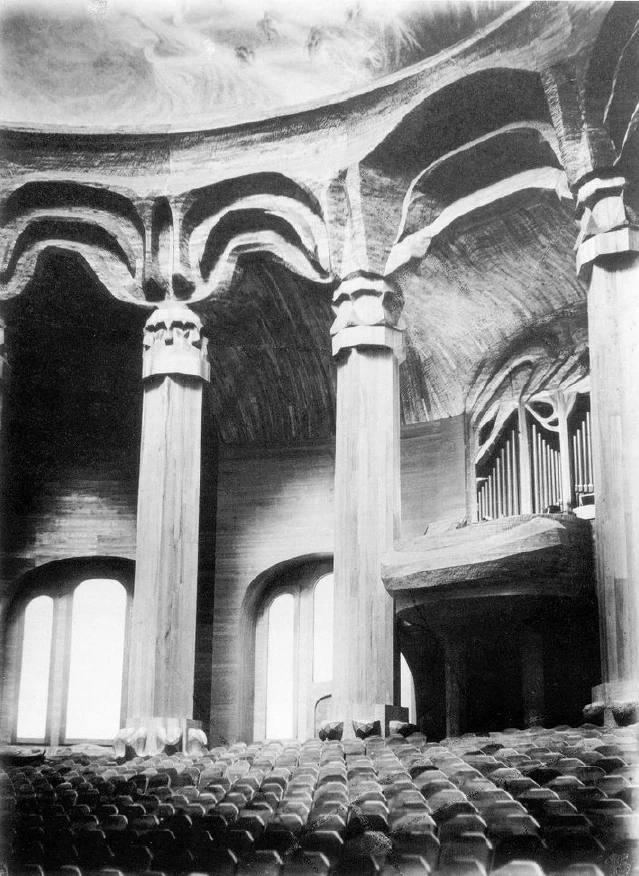 [ 2 ] When we come from the terrace through the main entrance and step into the first Hall, turn round and then towards the West side, we see this picture. We have before our view that which shuts off the space above, the first two pillars to the left and the right. As we go a step further we see here the capital of the first column to the right and left, and above that the architrave. If you will notice that which is essential you will mark the progressive development in the configuration in the capitals of the columns as well as in the architrave over the capitals.  [ 3 ] Yesterday I told you that the chief thing about this Building is that everything is felt to be in its place by reason of an inner necessity, exactly as a limb of an organic body is felt to be in the place determined by an inner necessity of the organism. You can see that everything that is included within the Building is an attempt to express the idea which has inspired the Building, so that it does not appear as a habitation constructed with walls in which something arbitrary here and there is placed. No, everything included in the Building itself is in organic union with its spiritual idea, You can be sure when you look at the next picture (1A) that it is in vital in connection with the one that has gone before. This is the organ left (photographed as you see from the model) which will show that also here the organ is built in full harmony with the rest of the architecture, so that you have not the feeling that it has been added but that it is a part of the whole form, as if the organ had actually grown out of the architecture. That is the fundamental principle upon which the whole Building is carried out.  [ 4 ] In the next picture (31) you see the first pillar and I want to call your special attention to the way in which the motive of every pillar develops out of the one that has gone before in a living metamorphosis. In order to do this we must look at the next picture (32) where the second pillar develops out of the first and where also the architrave motive is transformed in a developing metamorphosis, every succeeding form springing after its own law from the form which precedes it. You see here how the second pillar develops itself out of the first—that is to say when you take the forms which reach up from below and those which reach down from above, and when you picture to yourself how each succeeding leaf of a plant issues through metamorphosis out of the foregoing leaf, then you will realise how the form of the second pillar develops out of the form of the first pillar. The whole of it is to be found in continuing metamorphosis.  [ 5 ] If you would really get an understanding of what is meant, then you will of course be wrong if you attach exaggerated importance to the nomenclature which as a matter of fact only—relates to exterior conditions. The first pillar has been called Saturn, the second pillar Sun and so forth. Well, that is conceivable and that nomenclature is from a certain standpoint justifiable. But to abide by such nomenclature would of course be most inartistic. The essential thing is the relation of the second pillar to the first and the first to the second pillar. The essential thing is the change from one form into another for it is just in this change from one form into the other that the laws of world order are to be found, and ordain the change from Saturn formation into the Sun formation. I do not mean to say that these pillars are symbolic of Saturn and Sun, I simply mean that the law of change from Saturn to Sun is an inward law whose workings can be seen. This inner law whose workings can be seen has been expressed here in the sequence of the form. We will now see the second pillar by itself.  In the next picture we show the second and third pillars together with their particular architraves.  [ 6 ] You see how in the first place the capitals are pictured in progressive metamorphosis and also how the architrave motif progresses, each form building itself up out, of the form that has gone before. Whenever you see a curve or a turn you must realise that this is not to be considered only as regards its own form but always in relation with the form that has gone before and that which is to come after. Through the entire development here neither a capital nor an architrave motif can be understood by itself. They exist as a sequence. They exist in their relationship one to the other. That is what we chew here. That is the truth which expresses the life element. Now we shall see the third pillar by itself.  [ 7 ] Now then, we will see the third and fourth pillars together with their architraves. We shall see as we continue that things become more and more complicated. That is in accordance with the nature of evolution. Evolution proceeds from the simple forms to the more complicated. You see here that the fourth motif is really very complicated in relation to the one that has gone before and especially the architrave motif is becoming more and more complicated. We will now see the fourth pillar by itself.  [ 8 ] As I have said before this pillar and this motif must be seen in their relation to all the rest. That is the essential thing in all the ideas expressed in this Building. Whereas elsewhere one finds repetition, here one has a progressive evolution. This is really the essential new element that has been brought into the idea of this Building. Whereas elsewhere the dynamics of Geometry are put before us in repetition so that like balances like here one is concerned with the growth of the one out of the other. Look at them again - this pillar and the following one—together with their own architraves. Here we see how the moss complicated motif will be found in the capital of the 5th pillar and how the architrave motif becomes extremely complicated as it develops from the simple form which was there at the beginning to these very complicated forms. We will now look at the 5th capital by itself.  [ 9 ] Perhaps the form of this capital suggests to you the staff of Mercury wound about with snakes but you must not regard it as though it stood by itself - you must look at it as though it were veritably a living metamorphosis from that which precedes it—as a composition that has not come into being as an isolated idea. You will see if you once again change this form according to law and also according to the principle of progressive change the next form will develop out of this one. We will now see this with the next once more and the contents of its capital. [ 10 ] You have only to notice how certain lines which wind themselves about this Mercury motifs branch out from one another, how the Mercury motif with its small top and its points directed downwards appears to be growing larger, and notice how that which you see there at the edge grows to meet what is underneath it and is united with the Mercury motif. Then you will understand how forms which are in living movement grow through and grow out of each other, and that the succeeding motive is developed from that which has gone before. [ 11 ] But I must draw your attention to one thing. Just now when we have passed the middle point and we look at the next motive and compare it with the one that has gone before you might be inclined to say that this is more simple than the previous one. This is a point which must be quite clearly stated. If you follow the idea merely intellectually it may seem to you as if evolution consists in the fact that beginning from the most simple forms it proceeds to more and more complicated forms so that the last form will be a perfection of complexity. That is however not the case. A wholly false idea of evolution has come into being in modern times owing to this mistake. It is just when we follow the idea of evolution in Art asp I had to do in order to model these capitals and architraves one from another that VT identify ourselves with the real principle of evolution in nature and indeed in the world. You have then to model things after the pattern of evolution in the world and in nature, then you get an inner vision of what evolution really is. The marvellous and significant thing is that this trend at first is towards the more complicated forms but just about at the centre, just when you have what is most complicated, this trend is reversed. and turns again towards the simple. Thus it has been shown in an artistic manner out of its own nature that when the most complicated stage has been achieved there come; a return to the simple and the complicated has to appear again in its most simple manifestations [ 12 ] I should like very specially to explain to you this principle of evolution. Granted we had to follow the course of evolution through any form of metamorphosis we should say this here is a simple form (see drawing 1st form) Now we go a little further and see how a subsequent form can grow out of this one. Now let us understand how the following form grows out of this one. Here we have an illustration of the complicated which has grown out of the simple (the second form). 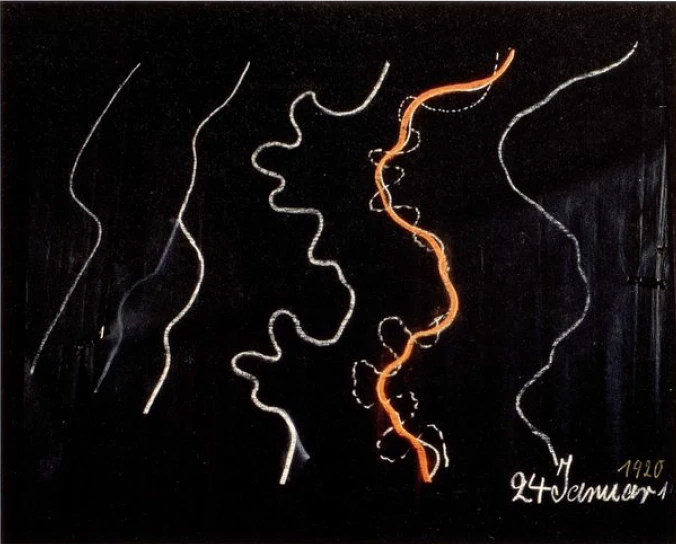 [ 13 ] The next still more complicated form could be moulded in this way (see 3rd form). Now you have the third form having grown out of the previous one. Follow the development further so that it becomes apparent to you what is organic and growing and in this way you will feel yourself forced from a certain point onward. Through this relationship (or connection) in which you come with the living principle of evolution you feel yourself forced onward to mould not something apparently more complicated but something like this (see drawing 4th form and the next you would feel obliged to mould in this way (see 3th form); that is if you are really immersed in that which in nature is the origin of the principle of evolution and the power of evolution. Then you would get a development which is really modelled from nature—that is, from the simple to the complicated, then again to the simple. [ 14 ] But this simple form which one now achieves has a certain quality It is indeed apparently simple but if you compare this simple form with the simplicity of the first form you will say to yourself “here is a simple roughly drawn line” (referring to the first one) “but here is a change” and one has the feeling that one can see in it what has gone before so that in a certain sense what has gone before is actually included in it and so you feel that out of the complicated comes the simple, in so far as this simple form builds itself up on a mysteriously complicated element (see the red line). So that the later evolution develops its simplicity out of the complicated. [ 15 ] It is marvellous how if one traces evolution through Art we identify ourselves with what evolution really is in nature. You see how we are led in this way to something that I have often pointed out If we follow the principles of evolution merely intellectually, then it is easy to believe that humanity is the most perfect result in the development of the organic creation and that it is also the most complicated. This is not true. If we contemplate a human organ—say the eye—we find that the human eye as seen from outside is certainly not the most complicated eye. The eyes of certain lower organisms are much more complicated. They grow organs like the sword appendix; the fan of lower organic beings which if; like the continuation of the blood vessels in the eye. In man these organs have apparently entirely disappeared and the human eye has returned to a simpler form, but simpler according to the principle of that which I have here shown in Art. [ 16 ] Now as I have said, if one contemplates this simplicity which develops out of the complicated—one has the feeling that this. line has to be completed in thought (dotted line). Simplicity is created from concealed complexity. Simplicity is what is seen outwardly, that is actually to in nature. Man has no appendix in the eye, and apparently no fan but if one could add to the physical eye the etheric, then there should be added that which in the lower organic beings is developed physically. Just in the same way as (see drawing) I had to add, the dotted line here, just as I had to build up that which is externally visible on the foundation of this by the dotted line, so the human eye in its simplicity, in its physical; simplicity is formed out of a complicated etheric eye-formation: the apparently simple physical out of the complicated etheric. [ 17 ] This is a proof to you that when we really grow into the inner form in the way that the metamorphosis of forms demands, we grow into the creative principle of nature herself. For then we understand for the first time how evolution progresses in nature, and here, dear friend; you can see how necessary it is in order to understand a certain inward power of development that we must learn to know nature not only in intellectual ideas but to grasp her forms with the imagination of the artist. This is the thing that you must realise as most important in every sense of the word. If one is to try in the way that science till now has done to get at nature with ideas and conceptions of an intellectual kind one will never grasp nature in her fullness of evolution. One will, only grasp nature in her fullness of evolution when one has built up in pictures and in imaginations what are otherwise intellectual ideas and so-called natural laws, for nature creates not in intellectual ideas but in pictures and in imaginations. [ 18 ] This is the main impression produced by our Building that it indicates to what kind, of representation we must progress if we would come to a satisfactory view of the world especially, in relation to the social future of mankind. The old world beliefs were developed from imaginations. You know the root of world beliefs is not to be found in intellectual ideas hut in pictures, in legends, in myths, and through pictures and images man sought to understand the forces which work in human life. And pictures and images were transformed into social impulses. All that originally came from the old pictures is to-day in a process of transformation and has to-day changed into intellectual conceptions; and intellectual conceptions cannot suffice for life. From this comes the present conception of the world with its dead element, with its destructive element containing within it the seed of death. And the conceptions of the world which appear new and young make nothing but sentimental and vogue claims. [ 19 ] Nothing fruitful for the future can develop out of that which today appears in the form of social ideas. Anything fruitful for the future must be born out of an imaginative conception of the forces of growth. These must ever be comprehended in their actual inner reality by means of such simple forms. In this Building the principle that lives and works creatively in nature can be realised from within. It will be seen then from the moulding of isolated forms that so far as this Building is concerned you have before you that which you really need in order to build up a vies of the world and a social life for the future. [ 20 ] It was of course a drawback that in the beginning the sectarian feelings of a great many people have given a false meaning to that which this building is meant to express, through over much symbolizing; and there have been people who consider it highly important that we should any that this is the Venus column, that the Saturn etc. These things that have a mystical flavour with which the mind can act a pretty play had to come to an end. In our time the task-of humanity is really something quite different from a mystical playing with ideas. And the main thing is that we deal with the clearest conceptions, and act with fullest consciousness—that is with that which transcends everyday consciousness—what I may call the super-consciousness, but which never descends to sub-consciousness. We must overcome all that pertains to day-dreaming, we must overcome all false and deadening mysticism. For higher than this mysticism, my dear friends, stands the everyday consciousness. For example while a raster Eckhardt or a John Tauler were in harmony with their particular time, to-day anyone who turned to this same consciousness which John Tauler or raster Eckhardt had would be entirely out of place in our world order. For the task of to-day is to get further, to awaken, not to go to sleep. There is much too pronounced an attitude among men for the pseudo-mystical, even among those who believe that they are on a better path But they only believe it. But there is still much too much of the idea that if we want to attain to spiritual truth, we can go to sleep a bit, we can dream a little, one can be a sentimental mystic. That is what is most injurious to the culture of our time. Instead of sinking from every-day consciousness into dreams we cannot sufficiently strive to climb out of the everyday consciousness to the more clear, to the super-consciousness. [ 21 ] For this reason this Building precisely through its artistic side had to make certain claims. Men to-day when they are confronted with Art tend to become a little dreamy and where possible avoid thinking, which is so very exhausting, when we are following our everyday concerns, cooking or tending machines or planning architecture or anything of the kind, and we think we will rest a little when we are enjoying Art; we think we can sleep a little. This Building is not for that kind of sleeping consciousness. People with this kind of sleeping consciousness come into this Building and they say “we do not understand this.” We understand it in the moment we follow with the eye every turn, every curve—where we with the eye of the soul follow the physical eye—where we do not concern ourselves with all the rubbish about names, Saturn or or Sun, Mercury pillar etc.—where we follow the forms and see how one grows out of the other, how everything lives and interweaves, when we leave our false mysticism behind and really exert ourselves to follow these forms. [ 22 ] We see that everything is not calculated to induce sleep but is for the purpose of awakening, for a shaking-up and not less for a becoming more aware than in ordinary life. This is the thing for instance, which pains me most. It is when I see again and again that people so love sleep even here in the Anthroposophical Society. They would like to pour out rest over everything and this is really the satisfaction of a selfish desire for sleep. Well, here the thing with which we are concerned is to become wider awake than we are in ordinary life. This Building can only be perceived in its Art form - in its inner artistic mobility when as we enter it we allow ourselves to be profoundly stirred and become more awake and aware than we are in everyday conditions. In ordinary life we sleep a great deal to-day, and it is from this sleep that our principle misfortunes come. [ 23 ] That is why every single form must be conceived actively. We must be able to set ourselves inside these forms and this Building is a living protest against all morbid mysticism. The worst of it is that even from well-intentioned people a certain mystical fog has spread itself around this Building through gossip and chatter, so that other people are able to repeat it: If only we could deal with the objections of our enemies with the reply that those who love this Building are concerned with supremely active life' But we must have a desire for this supremely active life. [ 24 ] We must seek here not soul-spiritual indulgence but soul-spiritual activity. We must grow and not let ourselves be lulled in dreams. This is the thing which I specially wish to say with regard to this Building. If with the whole soul we actively identify ourselves with the living movement, with every single form which has been built into the whole, then we shall see that while this Building gives the impression from the outside, “here within is something which wants to reveal itself to the world,” in the moment when we enter it the forms will so work that the walls themselves in a certain sense will disappear. That is a new thing, viz, the way in which walls have been conceived in regard to this Building. Up to the present time, walls have always been built in such a way that they form an enclosure. The Art principle in these walls is that they roll themselves up so that we have the feeling the walls do not enclose us, the pillars do not stand there in order to define a limit. But the thing that is expressed in the pillars, the thing that is expressed in the walls break through the walls and leads us into living touch with the whole universe. The Building is shaped out of the universe. Just as the world itself in its living interweaving life, in its spheric harmony, so is this building intended. That is the thing we aspire to in our eurhythmics. Not to allow that kind of sleep to enter into our eurhythmic forms but that a greater awareness shall take place in the action of eurhythmics than takes place in ordinary life, which we never could express in ordinary life. The performer of Eurhythmics should not be overcome in the struggle he has to wage continually against sleepiness in life. [ 25 ] We will now continue further with the pictures. This is then the pillar by itself in which you can see how when man comes to this perfection he comes outwardly to the perfection of simplicity.  [ 26 ] Now here you see the last two pillars with their architraves. Everything has become simple although it has arrived at perfection. You see the marvellous thing about this is that through the harmony between nature and creative Art other harmonies now manifest themselves that have not been noticed before. If you take the capital of the first pillar you can place that which was convex into the concave form of the last pillar and vice versa. This was not intentional. This is something which has been born out of itself. The convexity of the first Pillar fit into the concavity of the seventh. The convexity of the third pillar in the concavity of the fifth, and the centre pillar with its capital stands quite independently alone. These are things which are born, just as in nature certain realities are born in progressive metamorphosis which do not need to be foreseen at all but seem like a kind of crux of the experiment which one discovers only at last when one has been creating in the same way as nature herself creates. Here you see also the most perfect, and apparently also the most simple pillar of all.  [ 27 ] We will now let the seven pillars follow one after another so that we can see how one forms. as a metamorphosis emerges out of the other form—from the simple, the imperfect to the most complicated middle one, then back again to the most simple and the most perfect. [ 28 ] The first pillar. You have only to imagine the principle of growth transforming this pillar and you will get the next, the second pillar, then the third, the fourth, the fifth, the sixth and then the last.  [ 29 ] Now for the next picture. Here you see the last pillar and the point where the great cupola impinges upon the small cupola. So that you have a glimpse here of the meeting point of the two cupolas, where the architrave of the big cupola impinges upon the architrave of the small cupola, only separated by the aperture in which.the curtain will drop. The little cupola is supported in the same way with pillars and architraves of which I can show you only a little. We have not been able to get good photographs of the others, but this juncture we shall see again in the next picture. We see here another aspect of this juncture where one cupola impinges on the other.  Here we have another aspect of the pillars and architraves of the little cupola. And now you will see a bit of that part which represents an architrave space to the East in the middle of the small cupola.  [ 30 ] You see a bit of what is in the middle; beneath that will be the sculptured group of the Representative of Humanity with Ahriman and Lucifer in the vicinity. Above is the picture of the same.  [ 31 ] When you observe carefully this bit in the small cupola of which only a small portion is shown, you will see that in the forms of this architrave is included—as in a synthesis—everything that is shown in forms on the capitals and the architraves of the small cupola. This is here a comprehensive expression of all that has been expressed in the capitals and architraves of the small cupola. Here is to be found everything repeated again—of course transformed to accord with the place in which it is found. You will find when you compare that which confronts you in the form of the sculptural group showing the Representative of Humanity, Lucifer and Ahriman with all the different curves and forms and surfaces which are found on the capitals and architraves, contains in itself the whole Building in a certain sense. So that this sculptured central group might be conceived of as the synthetic epitome of the whole Building. Just as for example the human head is a repetition of all the rest of the organism, or, if you like it better, the human larynx and its neighbouring organs is an organic repetition of the whole man. Only that everything is put together in its own place out of an inner organic necessity. In the same way this Building must be grasped as a whole for the parts do not exist alone but each must be considered as a part of the whole. [ 32 ] I want to draw your attention to the way in which this idea with regard to walls is apparent in a still more material way in the glass windows, the reproductions of which I cannot show you here. The glass windows are only works of art when the light of the sun is shining through them. At other times they are only like a musical score. Thus you will see that. these glass windows (about which I shall speak more fully later on but which I cannot show you now) are in themselves an evidence that the building does not stand as a thing by itself but that the light of the sun is imagined as unity with it. And now in the same way everything connected with the form of this Building is imagined as being in unity with the creative powers of the whole universe The Building itself may be likened to a bit of the whole universe. [ 33 ] The next picture. This gives you the portal of our glass house underneath. You can observe once more how the effect has been made in everything which belongs to the Building to express in every form of truth that I have again and again pointed out. This glass house (and I have called it a glass house because it was originally built in order that the glass windows might be fashioned there) has also two cupolas. It is indeed a metamorphosis of the great cupola of the main Building. You have to imagine that the two cupolas of equal size are pulled apart, for you could not unite two equally large cupolas in the same way as you can unite a large one and a small one. It would he against the laws of nature. In order to bring the cupolas together as they are brought together in the main building they must be made of different sizes, the one large and the other small. If they are the same size they must be drawn apart and everything else must be adapted in the same way. You will see in the formation of the steps, how, in every case each individual line in its own place is the outcome of a law of necessity, and how a part is in every case an expression of the whole. 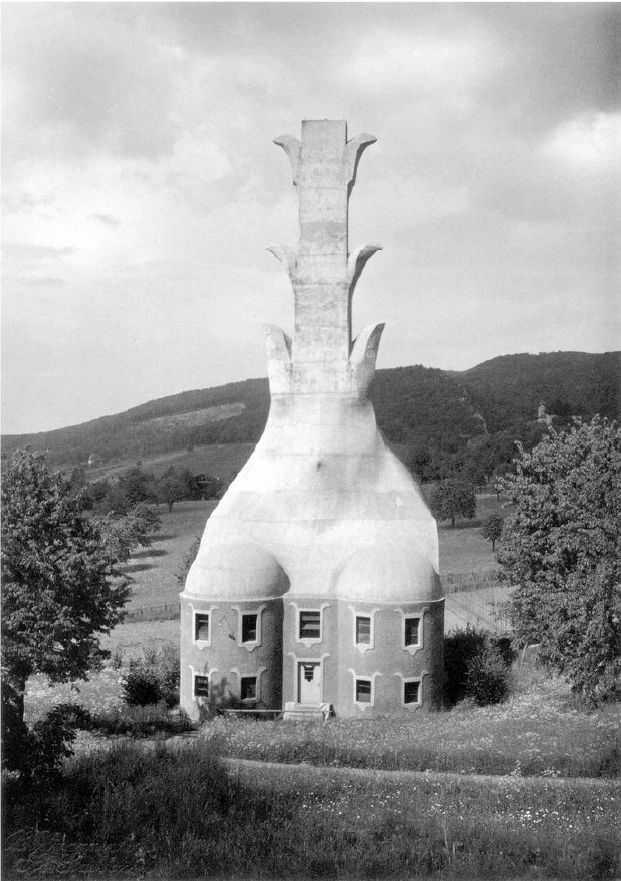 [ 34 ] Now here you,see that which is to many people a monstrosity. It is the. house which is to contain the apparatus for the lighting and heating. If you were to ask me upon what principle this building is designed, I can only say it is fashioned in accordance with the creative principle of nature. It is formed in a way which, as you will see if you look into it, may be compared, for instance, with the way in which the nut shell correspond: to the kernel of the nut. It is true, is it not, that the kernel of the nut has a certain form? The shell of the nut fits itself exactly to the kernel of the nut. The shell cannot be different so long as the kernel has a determinate form which is the effect of quite a different cause. In designing such a building as we have here we have to consider carefully every detail it contains. What purpose does everything serve that is contained herein? For this is a building whose purpose is pure utility. One has to get a conception of what is here contained and of what purpose it serves—that is the nut. Afterwards one has to consider how to build the corresponding shell of this nut. To the “nut” itself belongs the smoke which escapes, this building is only complete when the smoke is rising. It is only a work of art if this chimney really fulfils its purpose. Then only will one see the necessity of these projections. We shall not look at theM as they were leaves of a plane or anything of that sort, but we shall feel ourselves into the shape and then we experience how this shrine is bound by an inner law of necessity to the crake. As the smoke is linked in organic connection with the building and also that which is happening inside the building, so in the same way we shall realise these globes. Imagine what would be there if we had not attempted to create this form. [ 35 ]I will of course admit that we shall be able to carry out these ideas in a more complete way, but a beginning must be made and everything that follows can become more and more perfect. The beginning must be made, first, to demonstrate that a building which is designed for utility must follow some such inner creative principles. Secondly, it must be built with regard to the adaptability of the most modern material: concrete. For every material demands its definite laws of building. When we build in a certain material we have to observe certain quite definite principles, that are bound up with the very nature of the material. The conception of building must give expression to the idea of utility and also to the demands of the particular material. [ 36 ] You see it is not to be wondered at that these things which are all more or less new are repudiated by many people. Those who are not familiar with these ideas will not easily follow what I mean. But it becomes easier and easier as time goes on. Every idea that has come into the world in this way has experienced at the outset strongest opposition. But we must always take into account that it is exactly with regard to the things that are at present working that we must not sleep. It is also necessary that we make a certain energetic stand for the essential. We shall not succeed for a long time to come with out the energetic stand even if there are only few people who can follow the things with really inner understanding, for you see how things are. We shall take the opportunity tomorrow when we are speaking of the paintings in the cupola, to speak more of many things about, around and in the Building. I have already said that you can see from all that with which we have been dealing how far this building represents that for which our anthroposophical ideas stand, and how every detail is born out of the way in which we look at the universe. If that could be brought into the world in the same thoroughness, we should have achieved something. For you see my dear friends, it is impossible for us to succeed to-day with these conceptions with which in past years we thought we should be successful. [ 37 ] I gave you an example a week ago of the unsavoury lying methods which are being used. Why do they use such lying methods? I assure you that this is only the beginning of opposition. There is going to be lying on a much bigger scale. But I can show you how these lies are being systematically spread and the very lies that people are spreading, themselves, they use as further evidence. This systematic campaign will continue. I know there are many people in our Society who will not believe how low is the condition of morality in the world to-day, but it is necessary that we should not blind ourselves to these things. [ 38 ] But we must realise two things. First the intensity of the campaign comes from the fact that people feel, here is reality, they will not let it evolve. If it was a matter of programmes, as has been so much the case in the past, the people would not take so much trouble to slander us. But people will take the trouble to slander what is born of real force. For because they feel that they are face to face with the future they will slander and they will lie. But it is not a matter of convincing liars of the truth; they will not be convinced; they do not want to hear the truth. The thing is to go to the people who are not yet lying and put things before them in the right way. Those who think that they can counter with arguments and proofs that which the Catholic Church is now spreading abroad against us do us very bad service. For to those who are spreading these slanders it is not a question of this or that truth—it is a question of turning minds against us. And if we were confront them with the truth it would be a matter of complete indifference to them, they would only lie the more. But we have to see through it, dear friends, and then adjust ourselves to the position. It is not a question of convincing those who lie but it is a question of showing to the world that is still uncorrupted, in what way these slanders and falsehoods are spread. [ 39 ] I am more and more astonished (and I have to repeat this very often) that:the pernicious tendency shows itself even within our own Society to occupy ourselves with those who slander and lie and to endeavour to meet them directly, while our real task is to explain to the world what kind of human beings these people are. If we are not able to see right through this thing, dear friends, we shall not get very far because it is incumbent upon us, especially those who live here in the vicinity of this building to become objective and to develop interest in the great objective universe, holding ourselves above cliques and personal feelings, and all these commonplace puerilities. If we cannot become objective in relation to this building and what it stands for, then the movement will really not be able to get very far forward. We must subdue the purely personal; we must be able to put ourselves into the big interests of the world. And in everyone of its particular forms this building is a demand upon us that we shall escape from the, narrow personal points of view and rise to the great interests of the world. [ 40 ] For every single form as a matter of fact expresses what is necessary to humanity for the future. Look at the abuse which is all around in the world. Do you find anything really pertinent to our cause? It is because people cannot find anything against our cause that they become personal. It is for this reason that they try to bring about the destruction of the ideas of this Movement by personal slander. It would be a sad thing if we were not able to look at these things properly and become aware of the things that are going on around us. [ 41 ] To-morrow we will consider the pictures in the Cupola. |
| 288. The Building at Dornach: Lecture III
25 Jan 1920, Dornach Translator Unknown Rudolf Steiner |
|---|
| 288. The Building at Dornach: Lecture III
25 Jan 1920, Dornach Translator Unknown Rudolf Steiner |
|---|
[ 1 ] Passing on to-day to the paintings in the smaller dome, it has not been possible to make lantern slides from the photographs of the paintings of the larger dome—as we pass on to the paintings in the smaller dome, I am indeed in a peculiar position, and everyone will be in this position who wishes to present an idea from these copies of what is meant by the paintings of the dome, to the wider public who has not first seen them here. The attempt has been made in accordance with that artistic point of view referred to, in my Mystery Play The Portal of Initiation, to evolve form in the painting entirely out of colour, so that, as regards the painting of the smaller dome, as far as possible, the influence of this point of view is actually felt—even then of course everything is only at the initial stages. [ 2 ] To allow form to appear as the creation of colour is that which is aimed at here. If we follow the history of painting we see that this fundamental principle to draw forth all that is pictorial from colour, can really only be at the very beginning of its development. Men tried in the art of painting because it offers the special temptation—this was even so in the most brilliant period—to express some naturalistic theme in reproduction. Even though it must be admitted—and who would not willingly admit, in reference to the production of Raphael, Leonardo, Michael Angelo and others?—that the greatest heights of pictorial art have been reached in striving for expression in this way, and it must be admitted that the whole modern cosmic conception which is unspiritual can scarcely do otherwise than somehow strive for expression, yet the time has come when a spiritualization of our cosmic conception must be sought; another principle, another way of artistic thinking, especially in the art of painting must make itself felt. [ 3 ] This artistic feeling certainly will only be admitted by him who has a presentiment that in this world each element represents a creative whole. If we have a right sense for the world of colour we find something truly world-creative in colour. Anyone able to sink himself into the world of colour is able to soar up to the feeling, that from this mysterious world of colour a world of beings spring up, that the colour itself through its own inherent forces will develop into a world of beings. I might say: as we see the growing man in embryo in the little child, so can we see a world of beings in embryo if we have a right sense for the world of colour. [ 4 ] Certainly it does not mean that we should have merely a feeling for the single colour; the single colour, as a rule, establishes only a relationship between man and colour as such. To see blue means to feel an intense desire, longing, to go out into the space in which the colour is manifesting, to follow the colour; to look at red calls forth a feeling of being attacked, as if one had to defend oneself against something, and so on with the other colours. Colours have also a certain relation with that which can be formed in colour, if we are able to draw the form out of the colour. Blue, for instance will always help if we wish to express movement, red will always help if we wish to express physiognomy. But what I mean has to do much less with single colours at with what the colours have to say to one another, whet red has to say to blue, green to blue, green to red, orange to lilac, etc. In this exchange, I might say, of speech, and exchange of activity between the colours, an entirely new world would come to expression. And we do not fully perceive this interchange of speech and interplay of: colours, if me are not. able to perceive colours as ocean-waves rising and falling, and at the same to perceive, playing upon the waves of colour, coming into life from the colour-waves, the elemental beings which develop their forms of themselves out from the colour-waves. [ 5 ] Thus the attempt has been made to show in painting the secret of how to create out of the very nature of colour. For a greater part of that which is living, which we look out on, is born wholly out of the creative colour-world. As our vegetation has sprung forth from the ocean, so that which is living grows out of the colour-world. [ 6 ] I might say, it is always pitiful to see how those who are possessed of artistic feeling truly feel that the old forms of art are bankrupt, that they can go no further, and how in spite of this the world is not willing to respond to the impulse which can only be explained through the anthroposophical interpretation of the world. Certainly this anthroposophical interpretation of the world must be something more than a mere intellectual idealistic set of ideas. It must be an intuitive perception. We must be able to think in colours, in forms, just as we think in ideas and thoughts. We must be able to live in colours, in forms. [ 7 ] If our Building is to be what it is intended to be, it must in a certain sense, bring to expression, as in one living being, the spiritual, the psychic and the physical. The spiritual is essentially brought to expression in the forms of the pillars, the architrave and the capitals, etc. In these is reflected the spirit, out of itself creating form. The psychic finds its manifestation, for example, in the glass-windows. In this interplay of the external light with the engraving on the coloured sheets of glass may be dimly apprehended by the play of the psychic, and the physical, that shows itself in its own configuration if one has the right-vision for what is painted in the domes. The paintings in the domes express to a certain extent the physical substantiality. It is, of course, the case that in the arrangement of the Building, which strives to give an understanding of the world to come extent, there is a reversed order, as compared with the ordinary comprehension of the three world principles. This follows naturally in contrast to what one generally imagines, i.e. the spiritual above, the physical below. In that which should develop in the human soul as force of inspiration through the whole artistic structure of the Building there must be a reversed relationship. [ 8 ] But this very creation from colours is of course just what I cannot show you in lantern slides, and therefore with lantern slides we do not get what is really essentially purposed in the painting in the domes. We get as it were inartistic ideas, effects of what is intended to he artistic. But of course that cannot be helped, and it is to be hoped that those who see these lantern slides of colour-pictures will regard there pictures as it were as crying out for something else, as not really giving expression to that which is intended. If we take them in the right way we must say, as regards these lantern slides of colour-pictures somewhat as follows: “What is really in these pictures, really wishes to speak to us in a totally different language”, and then we shall be led to see the Building itself in the original conception of it. And out of the contemplation of these lantern slides, this will be a longing that will then arise in him who has artistic perception. Hence I do not think it quite superfluous to produce even these lantern slides. 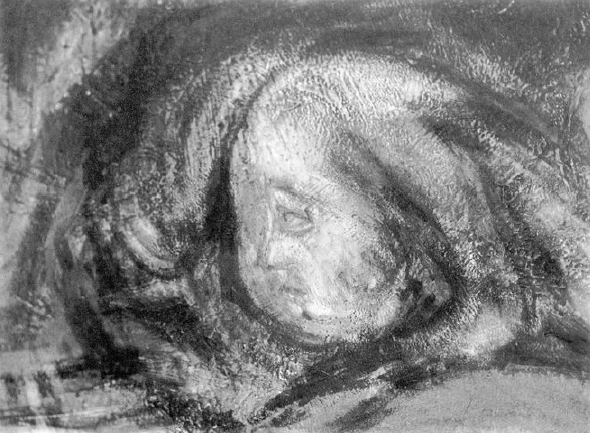  [ 9 ] We start from here in the small dome, where as a beginning there is, on the surface of the walls, a kind of flying child, immediately at the junction of the large and small domes. You see this flying child, which in its composition belongs to what follows on here on your left. The composition is of course entirely derived from the colour; yet it also forms an element in the configuration of the small dome. You understand the whole figure of this child here if you keep in mind the two adjacent forms.  We will now put on the next picture.  [ 10 ] You see here as it were a figure of Faust. Here we are in the riddle Ages, just at the time when our fifth post-Atlantean age begins and here you find the only word written in letters, the Ich or I or Ego. In the whole Building you find nothing anywhere expressed in written letters. The intellectual method of representing a word, of this foundation word I or Ego, has so far its justification here, in that, with the commencement of the fifth post-Atlantean civilisation that in which ourselves stand—in the 15th century, developing further into the time of Faust, in the 16th century, that which was invisible appeared, that which expressed by mere symbols, by what had detached itself from Reality. That which lay at the bottom of the real ego-being of man was not grasped. In the universal spiritual evolution of humanity no image of the ego had been evolved. For, when man said “I” he had only an abstract idea in his mind. This is therefore the justification for introducing a wholly unreal representation of the ego through letters. And it falls into place naturally by the side of the Faust-figure. [ 11 ] Do not, I beg you, attach any special value to my expression Faust-figure. The main thing is that in the whole composition this figure expresses what the spirit of the age in that very epoch produces in the seeking man. You see it brought to expression especially in the eye, in the countenance, in the attitude of the hand, you see it expressed in the whole gesture of the figure. That we are reminded of Faust is what one might say—purely arbitrary. It is the man who in the fifth our post-Atlantean age actually seeks, which is the characteristic of our age. Of the real fundamental character of this seeking few men as yet are conscious. Since the 15th century we have evolved ever more a sort of philosophy of death, which is no longer capable of grappling with life. [ 12 ] This is the result of the whole training which humanity had to pass through at the beginning of the fifth post-Atlantean period. During this period humanity has to develop the inner force of freedom. self-consciousness. Humanity can only do this by breaking adrift from nature. But to break adrift from nature means to identify oneself with the forces which in perceiving, alone understand death, recognise what is dead. All our ideas, all concepts which are the actual concepts of civilisation lead to death, are concerned with what is dead. And he who to-day is not himself dead, as most learned men are in soul, he who to-day is not himself dead as regards his seeking, finds in the seeking of these principles an incentive to what makes man free but is at the same time, I might say, the abyss or the dead. He has constantly the feeling: Thou makest thyself indeed free, but in so doing thou comest into proximity with death. Thus Death had to be brought into proximity with the Faust-figure.  [ 13 ] This is below. Hero you see the seeking man, who to-day is under the impress, under the feeling of death, death which always accompanies the most important ideals in the search for knowledge. It would be unbearable to a feeling soul to have a sort of Faust-figure above and below to have death, and no counterpart in the composition. Therefore, before we come to this composition of Faust and Death, we have this flying child, which to some extent represents the contrast to the feeling of Death. Thus a Trinity is to be understood: Death, the Seeking Man and the young Child full of life. With this is painted in the small dome what may be presented as the Initiation of the fifth post-Atlantean time. The Initiation-wisdom of the fifth-post Atlantean time is not to be won without one's having as it were full consciousness of the significance of Death, not only in human life, but in the life of the whole world as well. We possess indeed our powers of thinking because we continually bear the forces of death in our head. Were these forces which are active in our head for the purpose of thinking to penetrate our whole organism we should not be able to live, we should continually die. We only live because the tendency in our head to death is continually balanced by the tendency to life in the rest of our organism. That is, I may say briefly and lightly expressed in the abstract, the law of our time. [ 14 ] When I tell you this, I can understand that it does not penetrate specially deeply into your hearts, into your souls. To have experienced, signifies something fearful; to have experienced that impulse which in every effort for knowledge says: What thou canst acquire as knowledge at the present time, thou owest to Death which penetrates more and more into the earth-life. What really must enter into the earth-life of humanity will only enter when this initiation-principle, now at the very beginning of its growth—the power of Death!—extends further and further and engenders the vital longing of the newer future humanity for the compensating spirit, for a youth who is already Jupiter, which is no longer earth-youth, which is already the youth of the next planetary embodiment of the earth.  [ 15 ] We now go back to what can-be pictorially represented of the fourth post-Atlantean (the Graeco-Latin) period of civilisation. A sort of form is given here in the paintings of the small dome, which in its whole configuration - you will particularly feel this when you look at the colouring of this figure in the small dome—which, in its whole configuration, in its whole nature, portrays the shining-in of the spiritual world into humanity during the fourth post-Atlantean period, as it was to be at that time. Above this figure you find those who gave the inspiration, of which I have not been able to obtain lantern slides from the photographs. You always find those who inspire, over the corresponding figures, only in the case of the fifth post-Atlantean period of civilisation, Death itself, appears from below and approaching man above is the real Being which inspires.  [ 16 ] Here you see above a kind of God, an Apollo-like form, as the inspirer. That which, through inspiration, is able to enter a human form of the fourth post-Atlantean period of civilisation comes into this figure. Thus you see the actual human history of the inner soul-development is painted in the small dome. Of course you must give up asking inartistic questions. When an artist paints a form on the wall, there is nothing in his soul that,can meet such a question as: What does this or that mean? The inartistic man will stand before this figure and say: What do there two or three heads mean on the left of the principal figure? That it not the question of an artist; it is the question which he who paints it will least of all be willing to answer, because for him visions have to form pictorially, they simply appear in space as forms in a vision. He perceives nothing whatever with which to meet the question: What does that mean?—but he feels a necessity from the creative cosmic forces to place a form, which is inspired just like this one, in the neighbourhood of that which has already been-represented in human form. [ 17 ] I spoke of the creative forces themselves inherent in the colour-world. At the present time, if one sees any painting, one always has the image in one's mind. This is just what must be overcome. There are many more elementary impressions which must possess the artistic soul. (I will explain more clearly in detail what I have to say). Suppose I simply make a smudge of colour, a yellow smudge, and add to it a blue smudge (see illustration). He who perceives colour as something actually living cannot experience other than, when he so perceives a colour in this way, a yellow smudge with a blue border, to see a head in profile. 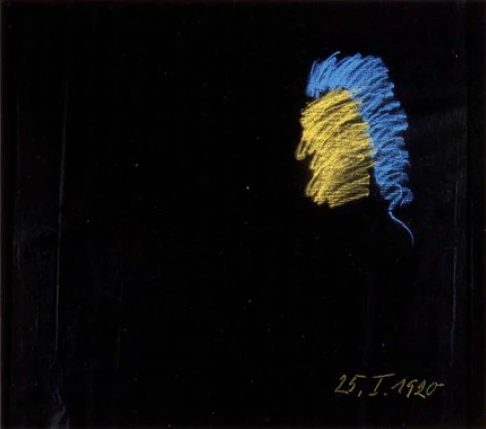 [ 18 ] This follows of itself for him who carries the life of colour within him. Just two smudges of colour are, to him who possesses the creative idea of colour, that which at the came time leads to the experience of its essence. But anyone cannot, let us say, paint a face according to colour in such a way that he can say: I have seen a face, or indeed, have a model, and after this model I have formed a face, and it resembles it. Not in this way will painting be done in the future, but colour will be experienced, and the artist will turn away from everything naturalistic, from all copying, and from the colour itself that will be drawn out which already lies in it and which must necessarily be drawn out, if one has a living feeling with the life of colour itself.  [ 19 ] Here you find a combination of what you have seen singly before: here above, the Flying Child, this Figure of the 16th century, below Death, the remainder less distinct. You see here above, the one inspiring, you can recognise him the higher inspirer of the figure you have just seen on this sheet but which is here very indistinct. It is, of course, difficult to reproduce in this rough way of colourless pictures things which have really only been lightly breathed into the colours on the walls. Such can only be understood, I might say, as a description of what is actually intended.  [ 20 ] Here you see the inspiring figures of the third post-Atlantean (the Egyptians) period of civilisation, those which inspire from the spiritual world that figure which will now appear in the next picture. We have here, inspired by the previous figures, the Initiates of the third post-Atlantean period of civilisation.  [ 21 ] Thus in the small dome the actual psychic evolution of humanity is painted, certainly not according to historical time, that you will see at once, but in an inner way. For now we are not going back simply to the earlier second post-Atlantean period of civilisation, but we are going back indeed to the Persian principle of Initiation, which also had developed out of the primeval Persian principle of Initiation, and is the Germanic principle of Initiation. So when we pass on to the next picture we have the Germanic principle of Initiation. This Germanic-Persian principle of Initiation is founded on a dualism, and everything depends on the understanding of the fact that the initiation of of the period of civilisation which took its rise in the primeval Persian period, continued its development in the Goethean period of civilisation. It spread geographically from Asia Minor, across the Black Sea northwards into Europe, and this Initiation-stream reaches its fulfilment in recognising the principle of man's effort to seek the balance between Lucifer, whom you see on the right, and Ahriman on the left. The essential point is that we understand that this current of civilisation crust derive all force in the finding of the condition of equilibrium between the Luciferic and the Ahrimanic. And an attempt has been made, in this very figure, which is inspired by the Ahrimanic-Luciferic principle itself, by that which you see here on the right as Luciferic, and here on the left as Ahrimanic, to show in the attitude, in the whole physiognomy, that spirituality that must result from the realisation of this dualism, the Luciferic and the Ahrimanic, between which man has to find the balance.  [ 22 ] The fact that you see here the child as it were held up by the Initiate, for this there is no good foundation. For what flows into man through the inspiration of the dual principle, could not be endured, it would kill him inwardly, if he had not always the vision of youth, of the child. When you see this in the dome, you will observe that an earnest attempt has been made to draw out of the colours just what is meant here. An attempt has been made to draw out of the colours even the contrast between what is Luciferic and what is Ahrimanic. Only you must not analyse minutely, but seek what is essential in the artistic perception.  [ 23 ] Picture 8: Here you see Ahriman presented. There are not two Ahrimans, but Ahriman and his shadow. That is to say, Ahriman does not go about without his constant shadow accompanying him. Ahriman himself would be a much too freezing, too drying-up a principle of he appeared for instance in his full nature. It is most necessary to have near him his shadow which qualifies his freezing influence. If you study the colours in the small dome, you will see that in this particular shade of colour, the brownish-green, an attempt has been made to expr ess the freezing effect of Ahriman; an attempt has been made to bring everything out of the colour.  [ 24 ] Here you see the Lucifer-theme. You will only understand the Luciferic and Ahrimanic principles fully if you see them in connection. If you simply look at Ahriman alone and Lucifer alone you will really understand neither; only when you have them side by side, because really Ahriman and Lucifer create and work in such a way in the universe that always whatever the one accomplishes is taken and made use of by the other, and vice versa. Thus their figures can only be rightly understood if one sees them in their living relationship to each other. The inspiration that come from these will be shown in the next picture. 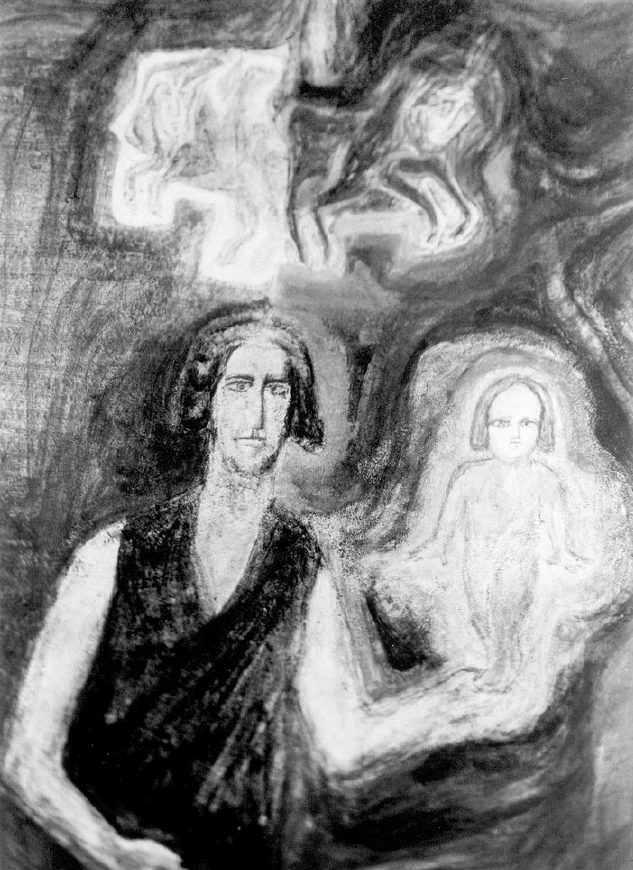 [ 25 ] I had hoped to express in this countenance with its adequate colour what is possible to express in a figure standing under the influence of this dual principle. It is the need,of inner stability, and at the same time self-possession in temperament, in character and the joyous inclination towards that which is young and childlike, in order to bear all that which one experiences under the actual inspiring influence of the dual principle. Here we have the same again in another aspect.  [ 26 ] Here you see that into which our Period of civilisation will resolve itself. This picture is to be found nearer to the central Group, that of the representative of Humanity with Ahriman and Lucifer We have attempted to represent what had to be shown here as an Initiate, i.e. such a man who could embody the spiritual revelation of the coming 6th post-Atlantean period of civilisation, even now in advance, and we have attempted to represent such an Initiate through the medium of form and colour. For this reason we had to picture not a Russian of to-day: but that which is to be seen to a certain extent in every Russian to-day. every such Russian has his own shadow continually as his companion. He has always his second self who accompanies him, and that is what is here expressed. [ 27 ] But you must realise that that which is here inspiring him is more spiritual compared with the earlier source of inspiration. Hence this angel-like form which here appears in its whole outline growing out of the blue. You will see more clearly in the next picture the kind of centaur-figure which is essentially necessary to the inspiring Being. You see, this inspiration leads at the same time out into the starry world. We recognise again man in his connection with that in the Cosmos which is external to the earth. But the Being which inspires is no longer to be conceived of in human likeness. In our attempt to show form we come to figures which are no longer human-like which have certain qualities of form which recall the qualities and temperament of man but are no longer human as such.  [ 28 ] Here is this inspiring figure which is a figure of the Cosmos and at the same time in connection with that which still tends towards the human, but is an angel-like Being born wholly out of the colour of the clouds. This is what we see as the colour Inspirer.  The same Being; only there is more to see; the Initiates are here to be seen. Of course the whole effect lies in the colour composition, which, naturally, is here wholly lacking.  [ 29 ] Here we see the upper portion of the Central Group. The middle figure shows the Representative of Humanity, above it, Lucifer. The middle figure is represented in the painting—under it the Group which is the Chief Group stands—is here represented in painting where the space is small, so as to represent the Luciferic and Ahrimanic principles in one figure only; while, in the plastic Group, on account of the weight, on account of the proportions of the space they are given in double form. This figure is only to be understood through the colours, through the Red colour out of which it is chiefly composed together with some other shades of colour. And here we are shown how man is seeking the state of equilibrium between that which is Luciferic and that which is Ahrimanic. This search for the state of balance is to certain extent to be found in man as much physically and physiologically as also in his soul and spirit. [ 30 ] From a physiological, from a physical point of view, man is not that simple growing being that he is often represented to be in superficial science. an inclines continually on the one hand towards ossification, and on the other hand towards .a softening gelatinous condition. The tendency in a man towards softening, which arises when the blood gains the upper hand, comes from Luciferic influences. Where the Luciferic influence tends to gain the upper hand physiologically in the human being, where feverish phenomena appears physiologically in man as actual formative principles, the Luciferic influence is predominant. As a result, the human form approximates more and more to this form. Man had this form during the ancient-moon period. In other words: if that principle which is specially the principle of growth in heart and lungs were alone to rule the human being, man would preserve such a form. Only through the fact that the Ahrimanic principle is found at the opposite pole to the Luciferic, the physiological state of equilibrium is maintained between that which the blood brings about and that which is produced by the ossifying tendency. This is the case viewed physiologically, from the point of view of the physical body. [ 31 ] From the point of view of the soul one may say: man is continually on the search for the state of balance between excessive enthusiasm, which is Luciferic, and that which is prosaic, materialistic, abstract, which is Ahrimanic. From the point of view of the spirit: man is continually seeking the balance between theca conditions of consciousness which are specially permeated with Light where the consciousness is awakened through the irradiation, through the illumination of the soul; through the Luciferic. And the opposite pole is that through which weight, gravity, electricity, magnetism, in short, all that which holds one down, bring about the consciousness of self, the attainment of consciousness: all this is Ahrimanic. Man is always seeking the balance between these two conditions, and we may observe how that all that man can make man more conscious, that can bring him away, from the middle.path always inclines either to the one side or the other, the Luciferic or Ahrimanic. It would be of immense importance even for the study of human physical organism, if we discarded the merely theoretical principle of growth, that of the One principle, and took into consideration that polarically-opposed impulses of growth are present in man as if interwoven, intermingled with each other. The other impulse of growth is Ahrimanic.  [ 32 ] Picture 17: Here is the exact opposite. In every shape, in every line you will see the exact opposite of Lucifer, in this Ahriman, who as it were grows out of the masses of rock, i.e. out of the solid conditions of the earth. His aim is to approach man and so lay hold of him with his force of gravity, (his solidity) that at the same time he slays him with ossification or presses him to death in barren materialism. This is what is expressed in this figure of Ahriman. He appears as if slain by light, hence the rays of which bind him wit) cords so that he is fettered by them. In between we have man - man himself.  [ 33 ] The real man, who represents the condition of equilibrium, under him Ahriman, above him Lucifer. I expressly draw your attention to this, that here again it is not essential to aim at the visionary conception of the Christ. The essential is that we feel what is here presented in this figure. Then we shall arrive ourselves, through the art representation, to the Christ. That is, we shall discover the central being of all earth's existence, the Christ, when we experience that which is to be felt in this form. The Christ may to-day discovered purely spiritually. But we must rightly understand man and rightly perceive him. [ 34 ] On the other hand it may be said: he who to-day understands and smypathises with that which man can suffer, with that which he can enjoy, he who fully realises how man can go astray or raise himself towards one side or the other, he who is striving after a real self-knowledge, if he only goes far enough along the road of feeling, perception and will, he will discover the Christ. And he will then be able to find again in the Gospels, in all historical documents, the Christ he has discovered. We cannot to-day really attain to true knowledge of man without attaining to the knowledge of the Christ. [ 35 ] Even along physiological, biological lines if we rightly conceive of man in his physical form we shall come to the understanding of the Christ. It is just the task of the fifth post-Atlantean time to attain more and more to this understanding of the Christ. Hence there could not be a visionary Christ-figure, concerning which one merely enquired its significance, in the central point of our Building, but the Representative of Humanity, in which the Christ to a certain extent appears in his essence. This is what I would beg you always to consider concerning these things; not to start out from the prosaic intellectual, but from the symbolic, not from the visionary to set out from that which is really there on the wall, not from that which may be imagined about it. That which should fill our thought should come forth from that which is on the wall itself. [ 36 ] Of course that which is on the wall is only imperfectly executed, but every beginning must be imperfect; even the gothic architecture, when it first appeared was imperfect. The perfect will undoubtedly follow out of that which has here been attempted. This is not to say that earnest effort has not been made to find the true Representative of, Humanity by every means of the art of occult investigation. You see, that figure of Christ which is the traditional one arose only in the 6th century after Christ. For myself, I only give this out as a fact, but do not require from anyone that he accept it as a dogma of belief, for myself I am quite clear on the point, it is for me a fact, that the Christ Jesus who walked in Palestine had this countenance, which you may see on the carved figure. And the attempt has only been made to represent in the expressive gesture that which one sees more when the etheric body is observed than when one observes the physical body. Hence also, the strongly-marked asymmetry which we have dared to portray. This asymmetry is present in every human countenance, naturally not in this strength, but the human countenance is thus indeed, especially as at present man wears in many respects an untrue mask. When humanity will have reached a certain spiritualisation in the 6th and specially the 7th post-Atlantean period where physical man will no longer live on the earth, then man will wear his true countenance, i.e. will express in his countenance what he is really worth within. [ 37 ] But all this—I should like to point out—is very difficult for the paint-brush or chisel to represent in the painting and sculpture and that which we have attempted to express as the Representative of Humanity. As imperfect as these things may be, he who studies them will find that the secrets, the mysteries of human evolution are actually sainted in this little cupola. He will certainly find that which is meant to be expressed., may be experienced from out of the colour, and that these pictures can only indicate to you what you are capable of feeling, when, on receiving the information which I have given you to-day, you expect nothing symbolic, nothing about which man can enquire the meaning, but when you—rather, with the information I have given you to-day, seek to feel that which is painted into this little cupola.  [ 38 ] Picture 19: Now I want to show the other view of the heating-house. Yesterday I showed the front view, and you see that this heating-house is thought out as a whole, so that its side-view to a certain extent stands full in harmony with the whole, as I yesterday, through the comparison with the nutshell, explained to you. [ 39 ] I have tried to give you to-day what we have up to the present in pictures. I should like to say that the actual attempt has been made with this Building to make the conception of the Building as far as possible a unity. For example, you see the Building covered over with Norwegian slate. Once when I was travelling on a lecture tour from Christiania to Bergen, I saw on the mountain slopes the wonderful slate-quarries of the neighbourhood of Voss, and the thought came to me that our Building must be covered with this slate. You will find, if you strike a favourable day, and desire to see the thing, that the particular blue-grey glistening of the dome—the covering of this slate—in the sun, makes an impression which is suited to the Building in its dignity. [ 40 ] This is what I am able to say concerning the Building, in reference to these pictures. I wanted.to make this Building comprehensible to our friends who are willing to undertake the,risk of making it known to and understood by those to whom the Goetheanum in Dornach is perhaps nothing but a name they have heard, and to whom the place is only a geographical idea. I wanted to give this exhibition for those friends who are willing to bring before the understanding of those who are thus placed what will proceed from the Goetheanum for , the future of the evolution of humanity. It is of great importance that this visible token of Spiritual Science from the point of view of Anthroposophy should be accurately brought to the knowledge of the world, and that it is made to a certain extent the centre-point of our considerations and of our feeling within our anthroposophical world-conception. [ 41 ] He who truly feels at what a turning-point the evolution of humanity has arrived in the present day, he will really indeed find within himself the necessary stimulus to make known what is here being carried out in Dornach. There are not many to-day who see how strongly the forces of human historical forms, coming from the past, act as destructive forces. We have indeed submitted to the destructive forces in Europe during the last 4 or 5 years; only the very few have wished actually to think over and appreciate what really happened. Those who do appreciate it will surely feel that nothing is to be gained for the further development of humanity from that which has been brought over from old times, that literally the new revelation which presses in upon us since the last third of the 19th century must be received by this world of ours. [ 42 ] No one can think socially to-day without taking up the impulses which come to us from this knowledge which has been described. We must painfully, really painfully, realise, when we hear that there are to-day men who say: Oh Spiritual Science according to Anthroposophy was very pleasant, as long as it was Spiritual Science ,as long as it did not bother itself with outride things, as for example, “The Threefold State” does. There have arisen individual men among the earlier followers of Anthroposophical Spiritual Science who say: Spiritual Science was very acceptable to us by itself; with the social aspect we cannot and will not identify ourselves. Such an attitude of mind is sectarian, and that is what our movement truly never wished to be; this sectarianism only strives after a certain spiritual voluptuousness. I should like to know how anyone can be so without heart, so terribly heartless in the presence of such impulses as are appearing in the evolution of humanity as to say: I want something that comforts my soul, that assures me of immortality, but I won't touch it if this spiritual striving is to have a practical social result. Is it not heartless in such a time as this, not to wish for a practical result from that for which we are striving spiritually? [ 43 ] Is it not the most confused mysticism to as it were fold the hands and say to oneself: For my soul I will have Spiritual Science but this Spiritual Science must have no social result. It is heartlessness. For how terrible it is to think that to anyone this Spiritual Science should be the most important thing in life, and that it should have no counsel to give in the present-day burdened social condition of humanity. That is the good of this Spiritual Science if it contains no help towards which humanity to-day may turn! Shall it be quite unfruitful, this Spiritual Science, for life? Does it only exist to pour into men a spiritual bliss? No, only thus can it preserve itself, by creating out of itself actual practical results. And it means that true Spiritual Science is not understood if men will not advance to practical results. And Spiritual Science must not be mere visionary knowledge, Spiritual Science must be actual life. Therefore it is always such a great pain that not very many more human souls are able to rouse themselves out of the impulses of Spiritual Science to the great interests of humanity to-day. To-day that which affects the individual is of such infinitesimal importance as compared with that which is fermenting and working in humanity, and the moment one occupies oneself with anything personal, the thought is immediately directed the great interests of humanity. But how many people think like this? For I must remember, how necessary it really is to communicate certain esoteric truths to humanity, and yet how impossible this is because there is really no set of people in whom really the impersonal objective principles have the value that they should have. It is a pressing necessity to communicate certain truths of Initiation to humanity. Only it cannot be done, when one has to do with men who the whole day long are only occupied with their own personal interests, as if they were of the highest importance. To turn our eyes to the human interests, that is what is of such immense importance. He who does this will see very very much to-day. [ 44 ] I have to draw your attention again and again to the beginning of this battle-storm which will arise with all sorts of slander and lies against Anthroposophical Spiritual Science. Men do not want to believe this, but it is true; Spiritual Science will not be fought primarily on account of its faults; these would be forgiven it; Spiritual Science will be attacked just when it succeeds in accomplishing something good. And the hottest and most infamous attack will be directed against that which Spiritual Science can do of good. [ 45 ] Each one must examine himself, whilst continually observing with true inner force that which can only be criticised as relentless opposition to Spiritual Science, whether he does not perhaps carry in himself too much of that attitude which does not attack the failings but rather the good sides of Spiritual Science. Much of this sort might be pondered over to-day: And this sort of thing must continually be pointed out. And the time must certainly come firstly, in which it will be possible not to have to approach closed doors with the communication of certain esoteric truths, because men are only occupied with their own personal interests, and secondly in which it will also be possible to bring the most important things when they are spoken, actually home to the hearts of men. As a rule one may proclaim things of the greatest significance—men take them only as a kind of theoretical knowledge, and hence they do not penetrate into, their hearts and affect them deeply; whilst everyday things, humdrum things even perhaps relatively big things, penetrate easily into the hearts of men. [ 46 ] This is what we must before all else strive for; that that which is drawn from the Spirit shall truly penetrate right into the heart, into the soul, that it does not remain merely in our understanding. Much of the most important of that which has been spoken to-day, which may already be found in the teachings of Spiritual Science or Anthroposophy, bears no fruit on this account, that men let it get no further than their understanding, and then they say perhaps: This is something which should only be grasped by the understanding: But that is their own desire—to leave it only to the understanding, because they only take it as a wisdom for the head, and do not let it reach their hearts. This observation I wish to link on to the Introduction I have given you of the Building. |
| 289. The Ideas Behind the Building of the Goetheanum: The Building as a Setting for the Mystery Plays
02 Oct 1920, Dornach Rudolf Steiner |
|---|
| 289. The Ideas Behind the Building of the Goetheanum: The Building as a Setting for the Mystery Plays
02 Oct 1920, Dornach Rudolf Steiner |
|---|
Over a period of three hours I shall have the opportunity of speaking to you about the building idea of Dornach. In this first lecture, it is my task to characterize how this building idea emerged from the anthroposophically oriented spiritual movement, and then, over eight days and in a fortnight, to go into more detail about the style and the whole formal language of this our building, the framework and the external representative of our spiritual scientific movement. By speaking about the genesis of the Dornach building, I would like to perhaps touch on something personal by way of introduction. I spent the 1880s in Vienna. It was the Vienna in which the ideas were developed that could then be seen in the Votivkirche, in the Vienna City Hall, in the Hansen Building of the Austrian Parliament, in the museums, in the Burgtheater building, that is to say in those monumental buildings that were created in Vienna in the second half of the last century and which, to a certain extent, represent the most mature products of the architecture of the past era of human development. I would like to say that I heard the words of one of the architects involved in these buildings resound from the views from which these monumental buildings were created. When I was studying at the Vienna Technical University, Heinrich Ferstel, the architect of the Votivkirche, had just taken up his post as rector. In his inaugural address, he said something that I would like to say still echoes in my mind today, and it has echoed throughout my subsequent life. Ferstel said something at the time that summarized the most diverse views that had emerged in art at the time, especially in the art of architecture. He said: architectural styles are not invented, architectural styles are born out of the overall views, out of the overall development of the time and the emotional soulfulness of entire peoples and eras. On the one hand, such a sentence is extremely correct, and on the other hand, it is extremely inflammatory for the human mind. And anyone who has ever immersed themselves with artistic sensibility in the whole world of vision from which this remarkable Gothic structure of the Votive Church in Vienna, translated into miniature, was created by Ferstel himself, anyone who has felt the Vienna City Hall by Schmidt, anyone who has felt the Austrian Parliament in particular, which, through Hansen's genius, has achieved a certain freedom of style, at the time when this same view had not yet been spoiled by the hideous female figure that was later placed on the ramp. Those who had experienced the artistic heyday of Gottfried Semper's mature architecture at the Vienna Burgtheater could truly feel the background from which such an artistic view emerged as that of Heinrich Ferstel, which has just been characterized. In all that was built, one sees ripe fruits, but basically one sees only the renewal of the styles of past epochs of humanity. And I was able to feel this, I would like to say, inwardly inciting fact, for example, when I heard the lectures of the excellent esthete Joseph Bayer, who, out of the same spirit that Ferstel, Hansen, cathedral architect Schmidt, but especially Gottfried Semper, created with, tried to illustrate the forms of architectural art, the forms of ceramics, and so on. Such a fact, such a world of ideas, is inspiring for the human mind, I say this because perhaps, when faced with such an idea, “architectural styles are not invented, but born out of an overall spiritual life” in the human mind - when one sees: this view has achieved something magnificent and powerful, but from a mere renewal, from a renaissance of old architectural styles, old artistic perceptions, so to speak - because then the question arises before the soul: Are we perhaps such a barren time after all that we cannot give birth to something new in this sense from our overall view, from the scope of our world view? At the same time as all that could so richly fill the souls from these buildings when they immersed themselves in these views, from which the buildings arose, something else, though characteristic of the time, was concentrated in Vienna. In its soul body, Vienna had at that time also absorbed a certain height of precisely the newer medical progress. Skoda, Oppolzer and others represented a flowering of the development of medical science in the second half of the 19th century. At that time, especially if you lived among those who had to deal with such things, you could often hear a saying – and this saying also stayed with me: We live in a time in which medical nihilism has developed. This medical nihilism, which had emerged precisely in the heyday of pathology, actually culminated in the fact that the great physicians mainly studied those forms of disease that could be observed in their course merely through pathology, in which nature's healing process only needed to be helped along by all sorts of measures, but in which little could be done for the patient by taking remedies. Thus, precisely out of this medical school arose a disbelief in therapy, a skepticism about therapy. And when pathology had developed to its highest peak that it could reach at that time, people actually despaired of the possibility of real healing and, especially in initiated circles, spoke of medical nihilism. That is what one could feel. Our world view, where it was to prove fruitful in a certain area of practical life, led to nihilism and a certain powerlessness in the face of that practical life. Anyone with the ability to feel and perceive these things will, in the subsequent period of European civilization, be able to fully sense how, basically, those impulses, which on the one hand found expression in the fact that an architect as important as Heinrich Ferstel had to say, “Architectural styles are not invented, but are born out of the overall development of the time,” and yet still built in the sense of an old architectural style, on the other hand, expressed itself in the fact that in a practical area of life, people's views have led to nihilism. What developed from this in the period that followed was basically a continuation of what had been expressed in this way. Through the most diverse circumstances, seemingly, but probably through a necessary connection, I was confronted with the necessity of setting up impulses of a new spiritual life everywhere in the face of the appearance of what lay in the lines of development I have indicated. This new spiritual life would in turn draw from such original sources of human thought , human feeling and human will, as they repeatedly existed in the epochs of human development and as they proved fruitful in order to give rise to the artistic, the religious and the cognitive. If we want to feel in an even deeper way what the human mind was actually like at a time when, in art, only a kind of renaissance was living in the highest expressions of the artistic, and when, even in practical areas, views have led to a kind of nihilism When we delve into what was actually taking place in the soul and spirit during this time, we have to say that the spiritual matters that directly concern the human being, the scientific, and even to a high degree the religious life, had taken on an abstract, intellectual character. Man had come to cultivate less that which can arise from his entire human essence, his powers and impulses. In this most recent period, he had come to establish a mere head culture, a mere intellectualistic culture, to live in abstractions. This is something that occurs as a parallel phenomenon in the materialistic age: on the one hand, people believe that they can completely immerse themselves in the workings of material processes; but on the other hand, precisely because of this striving for immersion in a tendency towards abstraction, a tendency towards mere intellectualism, a tendency through which the urge to shape something that can directly reach into the full reality of existence fades from the most intimate affairs of the human soul. One withdraws into an abstract corner of one's soul life, leaving one's religious feelings to take place there. They withdraw into the closed rooms of the laboratory and the observatory, and devote themselves to specialized investigations in these fields, but in so doing they distance themselves from a truly living understanding of the totality of the world. One withdraws as a human being from real cooperation with practical life, and as a result one arrives at a closed intellectuality. And finally, everything that we see emerging in the fields of philosophy or world view in this period bears a distinctly abstract, a distinctly intellectual character. I believed that anthroposophically oriented spiritual science had to be placed in this current. It was not surprising that this spiritual science, when it was first placed in an intellectualist age, when it had to speak to people who, in the broadest sense, were fundamentally oriented towards intellectualist abstraction, initially had to appear as a worldview as if it itself had arisen only from abstraction, from mere thinking. And so it was that in our work for our anthroposophically oriented spiritual science, that phase arose which filled the first decade of the twentieth century and of which I would like to say: it was inevitable that our anthroposophically oriented world view should take on a certain intellectual character through the very nature of the people who were inclined towards it. It had to speak to people who, above all, believed that if you wanted to ascend to the spiritual and divine, you had to do so completely detached from the lower reality, you even had to arm yourself with a certain world-contempt, with a certain unreality of life. This was already an attitude that was alive in those who, out of their inclinations, had found their way into the current of anthroposophically oriented spiritual science. And on the other hand, the world's judgment of this anthroposophically oriented spiritual science arose: Oh, they are dreamers, they are visionaries, they are people who are not relevant to practical life. This judgment arose - such things are very difficult to destroy - and still lives on today in most people who want to judge anthroposophically oriented spiritual science. Of course, people saw that something different was alive in what appeared at that time as this anthroposophically oriented spiritual science than in their theories, in their world-view ideas. And since they regarded what they had sucked out of their bloodless abstractions from their materialistic orientation as the only spiritual reality to be attained by man himself, what the anthroposophically oriented spiritual science spoke to the world from completely different foundations seemed to them to be something fanciful, something fantastic. But a quite different phenomenon was involved. What was spoken at that time out of truly shaped spiritual science oriented to anthroposophy is not the speech of fantasy or enthusiasm. It is the speech of spiritual research that can give an account of the nature of its research to the most exacting mathematician, as I said at another time. But it is true: what has been spoken here out of spiritual realities sounded different from the bloodless world views of modern times. It sounded different, not because it was more abstract, or because it ascended to regions of the spirit more bloodless and frozen than those which have given rise to the theories developed out of the modern way of thinking, but it sounded different because it proceeded from spiritual realities, because it proceeded from those regions of man where one not only thinks, where one feels and wills, but does not feel and will in a dark way, not in the way that modern psychology considers to be the only one because it only knows this; not out of dark feeling, but out of feeling that is just as bright, as bright as the purest thinking itself. And the words were spoken out of a will that is suffused with a light that is striven for as the bright clarity of pure thoughts is striven for, and these thoughts are grasped when we seek to comprehend reality. Thus, in this anthroposophically oriented spiritual science, there lived that which wanted to come from the whole person, which therefore also wanted to take hold of the whole person, to take hold of the thinking, feeling and willing human being. When one was able to speak in this way from the innermost being of the whole person, one often felt the inadequacy of even modern modes of expression. Anyone who has felt this way knows how to speak about it. One felt that modern times had also brought something into external language that leads words into abstract regions, and that speaking in the way language has now become itself invites abstraction. And one experiences, I would say, the inwardly tragic phenomenon of carrying within oneself something that one would like to express in broad content and sharp contours and developed with inner life, but that one is then rejected back to what modern language, which is coming out of an age of abstraction and is theoretical, alone knows how to say. And then one feels the urge for other means of expression. One feels the urge to express oneself more fully about what one actually carries within oneself than can be done through the theoretical debates in which modern humanity has been trained for three to four centuries, the theoretical debates that have shaped our concepts, our words, in which even our lyricists, our playwrights, our epic poets live more than they realize. One feels the necessity for a fuller, more vivid presentation. Out of such feelings, the need arose for me to say what was said in the first phase of our anthroposophical movement, which was clothed in more intellectual forms, through my mystery festival plays. I tried to present, in a theatrical way, in scenes and images that were to embrace the whole of human life, the physical, soul and spiritual life, what can be seen in the course of the world, what is contained in the course of the world as a partial solution to our great world riddles, but which can never be expressed in the abstract formulas into which the laws of nature can be expressed. This is how that which I then tried to depict in my mystery dramas came about. I had to resort to images to depict what comes from the whole human being. For only from the human being in his head comes what modern language has created for our science and our popular literature, and what today's people, if you listen to them, are able to understand. You have to touch the deeper sides of their minds if you want to speak to them what anthroposophical spiritual science actually has to say. This is how the need for these mystery dramas arose. These mystery dramas were first performed in Munich, in the surroundings, in the setting of ordinary theaters. Just as it literally blew apart the inside of the soul when one had to express the anthroposophically oriented spiritual science in the formulas of modern philosophy or world view, so it blew apart one's aesthetic sensation when one had to present in an ordinary theater, in an ordinary stage space, what was now to be depicted in a pictorial way: the spiritual content of the anthroposophical worldview and world feeling, of the anthroposophical world will. And when we worked in Munich on the theatrical presentation of these mystery plays in ordinary theaters, the idea arose to create a space of our own, to perform a building of our own, in which there would no longer be the sense of confinement that one in the manner just described for anthroposophically oriented spiritual science, but in which there is a framework that is itself the expression of what lives in anthroposophically oriented spiritual science. Therefore, this building was not created in the sense of an old architectural style, where one would have gone to any architect and had a house created for what anthroposophically oriented spiritual science is to work out, but rather it had to arise from the innermost being of anthroposophically oriented spiritual science, because it did not merely work out of thinking and feeling, but out of the will itself, a structure had to arise out of this living existence of anthroposophically oriented spiritual science as a framework, which, as a style, as a formal language, gives the same as the spiritual-soul gives the spoken word of anthroposophically oriented spiritual science. A unity had to be created between the building as an art form and the living element present in this spiritual science. But if there is such a living element, if there is a living element that is not merely theoretical and abstract, if there is a truly living spiritual element, then it creates its own framework, because with such a spiritual element one lives within the creative forces of nature, within the creative forces of the soul, within the creative forces of the spiritual. And just as the shell of the nut is formed out of the same creative forces as the inside, which we then consume as a nut, just as the nutshell cannot be other than it is because it follows the laws the nut kernel comes into being, so this structure here in all its individual forms is such that it cannot be otherwise, because it is nothing other than a shell that has come into being, been formed, created according to the same laws as spiritual science itself. If I may express myself hyperbolically, it seems to me that at the end of my life I would not have been haunted by Heinrich Ferstel's thought that “architectural styles cannot be invented” if the truth contained in it had not been clearly reckoned with. Yes, architectural styles cannot be invented, they must arise out of an overall spiritual life. But if such a spiritual life as a whole exists, then it may dare, even if in a modest way, even with weak forces, to also gain an art style from the same spirituality from which this spirituality itself is created. I believe that I know better than anyone else what the faults of this building are, and I can assure you that I do not think immodestly about what has been created. I know everything I would do differently if I were to build such a structure again. I know how much this building is a beginning, how much of what is intended by it in the sense of its style may have to be realized quite differently. In any case, I do not want to think immodestly about this building. But with regard to what is intended by it, it may be pointed out how it wants to prove that architectural styles cannot be invented, but that they can be born if, instead of the nihilism of world view, a spiritual positivism is set, if, instead of the decadent decline of old world views, new sources of world view are sought. This building has therefore been created with a certain inner necessity. Just as feeling led us to present our world view in the mystery plays, as if feeling were to be taken into account in addition to thinking, so should the will, which is inherent in anthroposophically oriented spiritual science, first express itself artistically in this building. The fact that there is life in this spiritual science should, however, be shown in an equally modest way, just as a beginning – I always have to emphasize this – by the fact that we do not want to use this building to shut ourselves away and, as it were, strive for a higher world view as if it were a satisfaction of our inner soulful desires. No, in the next lectures on this building I will show you how all the building forms here live in such a way that they basically do not represent walls, but something artistically transparent. This is how the wall, which is designed here, differs from the walls that one is accustomed to in other architectural walls. The latter are final; one knows oneself inside a space that is limited in a certain way. Here, however, everything is shaped in such a way that, by looking at the frame, one can get the feeling, if one feels the thing in the right way, of how everything cancels itself out. Just as glass physically negates itself and becomes transparent, so the artistic forms of the walls are meant to negate themselves in order to become transparent; so painting and sculpture are meant to negate themselves in order to become transparent, so as not to lock up the soul in a room, but to lead the soul out into the world. And out of this tendency there also arose the impulse, still modest, which I call the social impulse and which in my book The Core of the Social Question should be presented to the world, not as a theory but as a call to action. Spiritual science could not remain with intellectuality. In its first phase it had to take human habits into account, had to speak to those people who were still educated entirely in abstract intellectualism. But it had to progress from thinking to feeling in order to present to the world what was to be expressed not only through the abstract word, but also through the dramatic play, the dramatic action, the dramatic image. But this spiritual science could not stop at mere feeling. It had to progress to the realm of will. It had to overcome and shape matter, it had to give form and life to matter. Therefore, a new framework, a new formal language, indeed a new architectural style, had to be sought for the mystery plays and for everything that wants to express itself through them, including the living anthroposophically oriented spiritual science itself. In order to affirm what lives as the deepest impulse in this anthroposophically oriented spiritual science, the social impulse also arose quite naturally in the time when adversity taught people to replace the tendency of decline with the tendency of ascent. We wanted to gain through this building, even through its style, that state of mind through which the human being goes out to experience all of social existence, goes out to be able to participate in the necessary social reconstruction of our time with living soul content. Thus, I believe, this structure can be seen as standing within what reveals itself as the deepest needs of our time, which in turn want to lead people out of mere abstractness and the materialism associated with it, out of mere thinking and into living feeling, and into active will. And we believe that in this way we also have what must be the substance, as it were, for what is so urgently demanded of us today, for what we know: If we humans are unable to accomplish it, the slide into barbarism will continue. A worldview that encompasses the whole person, the thinking, feeling and willing human being, must also be able to provide the state of mind that enables people to work together on what is a vital necessity of the present and the near future: social action. |
| The Ideas Behind the Building of the Goetheanum: The Artistic Impulses Underlying the Building Idea
09 Oct 1920, Dornach Rudolf Steiner |
|---|
| The Ideas Behind the Building of the Goetheanum: The Artistic Impulses Underlying the Building Idea
09 Oct 1920, Dornach Rudolf Steiner |
|---|
In today's lecture, my task will be to contribute something to the understanding of what lies in the artistic impulses that carry the building idea of Dornach, in order to then develop this building idea in more detail in the next of these lectures. It will be necessary for me to say something about these artistic impulses, so to speak, because strong misunderstandings have spread about them. The point is, and this is clear from what I said here eight days ago about the development of the Dornach building from our entire anthroposophical movement, that the Dornach building should in no way create something that could be called the carrying of abstract spirituality into what is actually artistic. The Dornach building should be created entirely by artistic forces. And this building should mark the beginning of a development towards this goal, so that what works in spiritual science as a spiritual being can also flow out, stream out into artistic forms, into artistic designs and so on. This is something that had to be fought for against certain tendencies that very easily run in the opposite direction, especially in such a movement as anthroposophy. It is very easy for all kinds of mystifying elements to enter into such a movement. These elements push towards the abstract through a false mystification, and which actually – because the artistic element must express itself in the shaping and forming of the external – bypass this artistic element and strive towards the symbolic, towards the allegorical. They want to keep the spirit in its abstract form, so to speak, and see in the outwardly shaped and formed only a symbolic illustration of the spiritual. This leads to a killing, a paralysis of everything truly artistic. In this direction, due to the penetration of false mysticism from the theosophical into the anthroposophical movement, one has had to experience all sorts of things. For example, a play like “Hamlet”, which is an artistic creation, was interpreted allegorically and mystically, so that one figure was understood as the spiritual self, the other as the astral body, and so on. There is endless allegorizing among those who would like to profess such a spiritual movement, and I once had to experience the following, for example: When I tried to discuss the well-known painting 'Melancholy' by Dürer in such a way that I traced everything that lives in this painting back to the chiaroscuro and showed how Dürer wanted to penetrate the secrets of the chiaroscuro, of the chiaroscuro, to contrast the light with the dark, the darkness with the light, in the most varied of ways, a voice was heard from the audience saying, “Yes, but can't we understand this picture on an even deeper level?” The deep interpretation was obviously sought in the fact that one wanted to extract from the artistically captured chiaroscuro an abstract-allegorical interpretation of what is depicted in the picture, which Dürer has already forbidden by placing the polyhedron in the picture to suggest how important it was to him to express the chiaroscuro variety that becomes visible when you compare differently directed surfaces, differently positioned surfaces of a polyhedron or the different surface layers of a sphere with any spreading light. That it is infinitely deeper to look into this working and weaving of light and darkness and to spread one's own spirit over this weaving of light and darkness, that for the one who feels artistically, it can be infinitely deeper than the abstract-intellectual allegorical interpretation of such images, such an interrupter had no understanding. And so what is present in this building had to be seen as an initial, weak attempt, in many respects fought for in the face of those aspirations that strive towards allegory and symbolism. These can be seen sufficiently when one enters some particularly solemnly decorated rooms where Anthroposophical spiritual science is practised and sees that attempts are being made to begin with colours and all kinds of paintings and drawings, but that these attempts ultimately leads to nothing other than offending every artistic feeling by painting a hideous rose cross, when what matters is only the allegory of showing some symbolism in seven roses painted in a certain way on a cross. I must mention this so that, if anthroposophically oriented spiritual science is also to show its artistic fertility to the world, it is known that what is attempted artistically must not be confused with all the abominations that easily arise from symbolizing and allegorizing, especially on such mystical ground as I have indicated. It is absolutely essential that the true spiritual scientist should realize through direct insight what the essence of the ideal consists in, so that he can find the transition from the ideal to what must be expressed in prose words, even though these prose words are only an inadequate means of revelation for the rich revelation of the spiritual world itself, and that this necessary prose presentation, which must also take on certain forms if it is to do justice to the spiritual world, is sharply contrasted with the actual artistic presentation, including that of the supersensible vision, which has nothing of symbolizing or allegorizing in it. That is why I had to point out in the lecture I gave to you on declamation and recitation that it is nonsense to fantasize and allegorize all sorts of things into my mystery dramas that are actually anthroposophical theory. The point of the dramas is to be understood artistically; and I myself, if I may make this personal comment, suffer the most unspeakable pain when someone presents me with abstract concepts that are supposed to “explain” these mystery dramas. These mystery dramas have been seen and experienced down to the last word, down to the tone of voice, as they stand, and the one who introduces allegorization does not understand them. He cannot really bring out the measure of super-sensibility that lies in them, for he only imprints the intellectual concepts into what should actually be experienced in the artistic sense. And so it is with everything else that is to arise artistically from those impulses from which spiritual science itself arises. I would like to say it clearly, although it may sound a little pedantic: no art can of course arise from spiritual science itself, as it is communicated in words; only allegory and symbolization can arise from it. But from those spiritual impulses that stand behind spiritual science, that drive spiritual science itself out of themselves like a branch, from those, as another branch from the same origin, artistic creation also arises. Therefore, those who understand spiritual science in the abstract and then want to translate it into art will never be able to create anything other than straw-like allegories or lifeless symbols. It has been said many times that symbols and allegories can be found in this building. If you look at the building properly, you won't be able to find a single symbol or allegory in it. Everything is meant to be – although some things have been left in initial attempts – in such a way that it has flowed into the form, the design, the color. And because misunderstandings can easily arise in this regard, I would like to discuss a few artistic matters with you today, so that, as I said, I can get to the actual building idea next time and characterize it in very specific terms. I would like to assume that, when we once had to perform that scene from the second part of Goethe's “Faust” in the carpentry workshop, in which the Kabirs appear, I tried to create the three Kabirs plastically from the supersensible vision that arises when one tries to penetrate the mysteries of Samothrace. So I tried to visualize these Kabirs in order to be able to bring them on stage. Now these three Kabirs were there in three dimensions. Then a personage who was very close to our movement wanted to give some other people an idea of these Kabirs, who could not see them here, or who wanted to have a souvenir of the way in which the Kabirs were vividly reconstructed here, and the question arose as to whether these Kabir sculptures should be photographed. For someone who has a feeling for sculpture, however, every photograph of a sculpture is a killing of the actual sculptural work of art. And so I decided to simply reproduce these Kabir statues in a drawing, in chiaroscuro, that is, using a different technique. So from the outset they were conceived two-dimensionally on the surface, and so it was possible to photograph them and disseminate them through photography. So you see: if you really stand on the soil of those life forces that pulsate in spiritual science, then above all you acquire a truly artistic feeling for the artistic means you use, and you acquire emotionally, not intellectually, what lives in existence. Let me mention the following example, which leads us more into the intimacies of the artistic empathy of the world process, which we then try to shape. Let us assume that one wanted to create a kind of sculptural representation of humanity, as I attempted in my sculptural group, which includes a figure similar to Christ (Figs. 94-98). If you want to create a sculpture of this representative of humanity, you would be led to feel quite differently about what is present in the formation of the head than about what is present in the rest of the human being's form, which lives outside the head.      In sculpting, you feel what appears as a huge difference in the human being. In sculpting, where one is dealing with the shaping of surfaces, one feels that a formative impulse must be at work in the head, which, as it were, pushes inwards, draws away from the outside, but which shapes from within; and one feels that in the rest of the human being, one encounters that which is shaped in precisely the opposite sense. It is not so important to say that one thing happens from within and the other from without – that would lead to an abstract, intellectual description again – but rather it is important to have the opposite feelings when developing any form out of the depths of the world process develops some form that can only be shaped from the inside out, or when one takes out a form that can only be shaped from the outside in, in which one can see, as it were, how the external world forces concentrate and shape from the outside in. If one continues in this feeling and sensing, then one comes to understand how, through having different feelings for the head than for the rest of the organism, one experiences something as a sculptor that is neither gravity nor vertically acting buoyancy nor even spreading force. Pure spreading force is what we feel in the light. Gravity alone is what we feel in our own weight and experience in particular in the aging of the human being, if one can take a look at this aging in true introspection. Of these two forces, gravity and buoyancy, one senses a kind of interaction in such a way that, I would say, the buoyancy forces, those forces that tear the plastic away from the earthly, can be felt more in the head, and the forces that work upwards from the earth's gravity and, as it were, drive the body upwards, these are felt more in the shaping, in the plastic formation of the rest of the body. But, my dear attendees, when one has really felt this, and – especially when one has metamorphosed this feeling into artistic creation – when one really lives not in an abstract idea, but in this feeling and endeavors to bring into the material that which one feels there, then one feels a strong difference... [gap in the shorthand]. For example, in sculpture there is something to be sensed, such as the balance of two forces, of which the sculptor himself need know nothing. Even someone who knows about such forces as spreading force, gravity and buoyancy force, completely forgets it in sculpting; it is none of his business there, he lives purely in feeling the spreading of the forces of the surface, in feeling how the surface expands in space, or in shaping the surface itself. If you have not appropriated anything abstractly conceptual – that is, if you can completely shed the cloak of the ideal when you immerse yourself in artistic creation – then, in a sense, you become a different person emotionally when you immerse yourself in artistic creation; then you also acquire a feeling for the diversity of artistic means of expression. And when one moves from working with sculpture to working with painting, one comes to say to oneself: All that one has to say about sculpture in terms of the way in which forces acting vertically and in the direction of propagation interact, of heavy elements and light elements, all that one has to have put aside when dealing with color and its nuances in painting. Because there it is about creating not out of the line, not out of the form, but out of the color, so that one completely stops feeling differently towards the head than towards the rest of the organism, as the sculptor does. In painting, one feels that difference disappear that arose for the sculptor between the head and what is not the head in a human being. This completely balances out and becomes something completely different, an inner intensity that cannot be represented by a contrast of lines, but can only be represented by penetrating into the intensity of the color nuances, so that it is not possible to go into detail, for example, on what still stands out very strongly in sculpture. And if you want to overcome it, you can only do so if you push the sculpture to a certain degree of consciousness, as I did with my central group for this building. But if you move on to painting, it is a matter of thoroughly rejecting any thinking in lines and moving on to the feeling that creates purely from color. And however strange it may seem to someone who speaks of a spiritualization of art in a falsely abstract sense, it must still be said: for someone who thinks in terms of painting, the most important thing is that there is a certain color nuance at a certain point on a certain surface and that, when one moves from this color nuance to another point on the surface, other color nuances are there. It is about creating from color. In this creative process, however, the artist is supported by what I would call the experience of color, the experience of blue, the experience of yellow, the experience of red. What the artist has, in experiencing yellow and red as if they were attacking him, and experiencing blue as if he had to chase after it with his soul, as if he had to expand himself, is what transforms into creativity within him and what then gives him the opportunity to transform the sensation into what is to become a work of art. If, for example, one is faced with the task of painting any surface, then it is a matter of nuancing between so-called light, warm colors and dark, cold colors. If one has the color experience, one can create out of this color experience, just as the musician creates out of the sound experience. Then it is a matter of the form arising out of the color itself, so that one does not draw and then smear color into the spaces created by the drawing spaces that arise through drawing, smearing the color in, but rather it is a matter of starting from the color experience and allowing the line experience, the form, to arise from the color experience. That is why I said at one point in the first of my mystery dramas - that is, I had a character say it, to whom I put it in the mouth - that the form must be “the color's work”. Fundamentally, we must be aware that all drawing and all thinking in drawing is actually a lie compared to painting. For example, when I see the blue sky, with the sea-green of the surface of the sea below, I have the blue of the sky above, the green of the sea below, and the line of the horizon simply arises from seeing, from the experience of color. And I am actually lying when I draw a horizon line that is not actually there (Fig. 114). This must now be thoroughly examined, otherwise one will not be able to enter into that world, which can be experienced through all the means of artistic expression, through the colors and their nuances, as well as through the concepts and ideas, if these concepts and ideas are really rooted in the spiritual and are not abstracted from ordinary human consciousness.  You see, here it is not so much a matter of expressing spiritual science in all kinds of forms, but rather of gaining impulses for artistic observation, which are just as necessary in the course of human development as spiritual science itself. But they are required as something special. It is the case that on the one hand there is the spiritual-scientific stream and on the other hand there is the artistic stream, which in a certain way must now also take on new forms. Therefore, I say to everyone who stands before this group, which is to become the central group here: One can feel something in the central figure like the Christ-figure, but it must be felt, it must not be thought that the name Christ is there. It will certainly not be written on the outside, but it does not even have to be thought, rather, the intuitive experience must take place within us, which draws our attention to how we must look at the matter, so that we develop reverence, develop high regard, develop the intuitive perception of the depths of the human being. So there should be nothing but feeling, nothing but experiencing in feeling, the same feelings that we experience, for example, when we immerse ourselves spiritually in the figure of Christ. But everything we experience spiritually when we immerse ourselves in the figure of Christ through spiritual science must not be carried over into what is formed plastically or pictorially. What is formed plastically or pictorially must be born out of form, out of line, out of surface. And this life in form, in line, in surface, in color, in word itself, is what later develops such forms, such painting, as it is to appear here in this building before you. What I have said now has little to do with the building itself, but only with the artistic attitude and artistic feeling that underlies the entire building idea of Dornach. It should always be borne in mind that it is at the beginning of the development of that architectural style, that artistic language of form, which can be expected to flourish in a special way in the future. Because I would not rebuild this building in the same way a second time. Not because I consider the artistic attitude on which it is based to be misguided – that is not the case – but because everything that is alive is also constantly evolving, so that a second time all those mistakes would be avoided and everything that could be said in terms of impulses for perfection could be taken into account. But I see all this myself and take it much more seriously than those who often call themselves critics of the building. I know the mistakes very well today and know what could be avoided if the building were to be rebuilt, and what could be brought into it if it were to be rebuilt. And it is necessary that all the details of the building idea from Dornach be taken up in this way.  To take one detail, I would like to mention the small dome (Fig. 57). Later, at the end of this hour, we will raise the curtain and you can then take a look at the small dome. Above all, I would like this small dome to be understood in such a way that nothing abstract is fantasized into it. For in this small dome, in which I myself am essentially involved – this is of course not to say anything special about the also in turn initial and in many respects perhaps amateurish in the painting of this small dome – an attempt has been made to paint really out of color, out of the color experience. In fact, this color experience should be understood in such a way that one sees, above all, the color nuance at a particular point. It could not be a matter of, for example, at a certain point where, let us say, the blue was to be emphasized, where the blue was experienced according to its position near the opening, further away from the center, contrasting with the color effects in the center, of thinking of a fist (Fig. 70) and paint it there because one feels a kinship of the nature of the fist with the blue color, but it could only be a matter of developing the color experience of the blue at this point and then letting the form, the shape, the essence arise out of the color. It had to become what it is there out of necessity.  From this you can see that it is not important to the person who originally gave rise to the idea of forming a figure out of the color experience of blue at this point, which then leads the feeling back to the sixteenth century, reminiscent of the Faust figure, but rather that it is important to him to give birth to form and essence out of the living color. And if, in the end, interpretations are attributed to the works, then one must be aware that these are interpretations from the outside, that they may help one or another subjectivity to experience this or that; but I myself prefer it if you completely forget, when facing this small dome, that there is something Faustian, something Apollonian ( Fig. 76) or of any doppelgänger (Fig. 84) and the like, and that you first surrender to the pure color experience from which the whole is born, and that you are initially just as indifferent to whether there is a Faust crouching there or some other figure, just as the person who wanted to create from the color was indifferent to whether this figure emerged. It just came out because the world lives in color.   But one must not take the starting point from the linear or symbolic boundaries of the being; rather, one must take the starting point from painting from the color experience, from moving in color, so that the color and especially the color harmonization and disharmonization come to life as such. One will then see that one narrows one's view of the world if one tries to translate the intellectually abstract world view — even one that arises as spiritual science — simply symbolically, allegorically into color or into form. Rather, one will see that when one immerses oneself in color, the whole richness of the life of color overflows one and that in this immersion in the world of color one has, that one still discovers a new world. While with every allegory you only bring the world you already have into the colorful world, if you start from the colored experience itself, you discover a new world that is as creative in itself as the world you have in mind when you summarize the external natural fact in abstractions or in natural laws. In this description – because everything artistic, when it is discussed, must be described – I had to show you how an attempt has been made here in this building, not to secretly incorporate anything into the plastic forms, into the color nuances, but to experience the secrets of these worlds ourselves, which give us the means to express them artistically. And when one experiences the secrets of these worlds, then one gradually frees oneself from all straw-like allegorizing and straw-like symbolizing. In painting, for example, one learns to overcome the line, even in the representation of the copperplate engraving or the woodcut, and to allow form to arise purely out of the contrast between light and dark. It is out of such experiences, not out of abstract thought, that the building idea of Dornach has come into being, out of what can be experienced in colour, in form, in surface, what can be felt as that which strives upwards, freeing itself from burdens, as that which works downwards, bearing burdens, bringing them to life within itself. All this is here in architecture, sculpture, painting, even in the window panes - the nature of which I will also discuss next time - felt, experienced, not thought; because all abstract thinking is the death of art. The life of art is born only out of form, out of color, out of the burdened, out of the carrying, out of the rounded, out of the angular – I now mean “rounded” and “angular” as a verb. And when one can live in the round, in the angular, in the burden, in the carrying, in the arching, in the covering and opening, in the plastically rounding, in the surface giving, in the expressing the interior in the exterior through the special surface treatment, when one can experience what arises like beings in the waves from the surface of the sea, when one experiences from the living colors, then the forms are formed in such a way that they are a creation of the color. Then there is truly no allegorization, no symbolization; then, alongside that world of abstraction or the merely non-sensuous spiritual, a completely new world arises, a world that Goethe called the sensuous-suprasensible world. This world is not, however, killed by the merely intellectual, and it is brought to life when one knows how to set the spirit within oneself in motion, not by going so far in the contemplation of the external that the sensual contemplation leads to the linking of thoughts, but in such a way that one sees the supersensible directly in the external, in the sensual. When the inner life, which in Expressionism always seeks to give rise to thought, is restrained to such an extent that it does not reach thought, but remains in the mere experience of the formative, of that which permeates the surface with the intensity of color and when the world is experienced in this way, as it can only be experienced in the element of sensation, not in the element of thought, then this experience can truly provide the stimulus for a new art. |
| 289. The Ideas Behind the Building of the Goetheanum: The Double Dome Room and Its Interior Design
16 Oct 1920, Dornach Rudolf Steiner |
|---|
| 289. The Ideas Behind the Building of the Goetheanum: The Double Dome Room and Its Interior Design
16 Oct 1920, Dornach Rudolf Steiner |
|---|
It may be clear from the two observations already made here about the building idea of Dornach how this building idea has arisen out of the same life from which that is to arise which is meant here as spiritual science. But this building idea did not arise in such a way that, in the building, what lives in thought form, in idea form, in spiritual science, is to be found again, only in outwardly symbolic pictorial form. Rather, the building was to arise out of the feelings and perceptions that can be harbored by someone who feels inspired by this spiritual science. To some extent the intention was there: on the one hand, the spiritual-scientific impulse wants to express itself in the form of ideas. But that is not enough, that does not reveal its life in a complete way, and another branch must sprout from the common root. That is precisely the artistic branch, that is what manifests itself out of feeling and perception in the building idea of Dornach. Those approaching this building from the outside will at first perceive a kind of duality: a larger dome structure as an auditorium; a smaller dome structure, which to a certain extent cuts through the larger one , as a space for performances, also conceived as the space towards which everything in the auditorium tends, and from which, in turn, everything that the auditorium is inclined to absorb should radiate. Our future development will depend on whether humanity is able to commit itself to a truly essential development in all its soul-forming aspects, to commit itself to development in such a way that one says to oneself: What one has inherited or acquired through ordinary life does not yet lead to what gives the human being a truly dignified existence. From a certain point onwards, the development of the inner life must be taken up in order to lead beyond what the outer consciousness alone can bring. But there must be something to meet what one is approaching and which one expects, as it were, from unknown depths of the spirit. And it is the feeling of this interaction between the receiving human being and the creating human being within himself that was then able to be lived out in the building idea of Dornach. From the outset, wherever domed rooms of different sizes adjoin or even intersect, one cannot help but feel that a close interaction is taking place between the person to whom the one part is dedicated and the person to whom the other part is dedicated. To a certain extent, the aim was to evoke the sensation of a rhythm that exists between the larger and the smaller component. This lively sensation, or perhaps it would be better to say this invigoration of sensation through the forms of the building, could hardly be evoked by two rooms adjacent to one another in a different way. But now that is adapted to what interior design is and from which I would like to start initially. You know that in the case of all the buildings that are actually designed to enclose something, we are dealing with a completely different architecture. Perhaps we can reach an understanding if we point to older building forms that draw their style, their architectural concept, from completely different premises. The Greek “temple is conceived as the dwelling of the god, and a Greek temple in which there is no statue of the god, of Zeus, Apollo or Athena, would not be a complete work of art. But how did this style actually come about? It arose, so to speak, from the idea of God acting from a specific point in the universe. It is intended to envelop the activity of this god; it is therefore conceived in its entirety as a covering, as an enclosure. If we go a little further, skipping other architectural styles, to the architecture of the later Middle Ages, to the Gothic cathedral, we have to say that anyone entering a Gothic cathedral cannot feel that this building is complete if it is empty. A Gothic building that is not conceived as a temple but as a cathedral, that is, as a gathering and confluence of the faithful, is only complete when the faithful are assembled in it, when they are inside, just as a Greek temple is only complete when the statue of the god is inside. Accordingly, the entire Gothic architectural style is conceived in this way. And now, penetrating into our times, one is led to say: the internalization of the human being is what must be the essential impulse of the present and the near future. Man himself, with his inwardly divine-spiritual essence, is at the center of all striving, but he kills this inner impulse of his modern striving if he does not find his way into the development in a living way. And it is from this feeling of the modern human being that the building idea here has arisen. The mere all-round principle of symmetry of Greek architecture, the enclosure, had to be dissolved, and the abstract idea of the upward striving of the crowd gathering in the cathedral also had to be dissolved. Closure had to be found, so to speak, in the upward infinity of the spherical form, development in the complete feeling for that which animates the individual form. It is perhaps partly due to external motives that part of this building is a wooden structure; it could just as easily be a concrete structure, but not, for example, a marble building. Now that it is a wooden building, I only need to speak about the peculiarity as a wooden building, which essentially presents the interior design. When working with wood as a material for architecture, for sculpture, one notices that this work in wood is something quite different from working in marble, for example, or in any material that reveals itself on the surface like marble or stone. This will be particularly apparent when the central group in the right light is seen standing in this small domed room on the east side (Fig. 92). It has become a sculptural wooden group in keeping with the overall interior design. So it was worked in wood. Of course, it was he who made a model first, since no single person can work on a nine-and-a-half-meter-high wooden group. I would not have been surprised if the people who saw this model, which was made in plasticine, had actually found it hideous, especially the central figure, the representative of humanity himself. For it goes without saying that the final design in wood must already have been present in the plasticine version.  But now, when working on stone – or on a surface that can resemble stone – one is obliged to carve out the form from the raised parts, from what bulges out of the plane, what confronts one from the plane; one is therefore obliged, so to speak, to place it on the plane, on the surface. When working with wood, you have to avoid working on the wood itself and instead work out of the wood. One must work not towards the convex but towards the concave. With stone and everything that resembles stone, it is that which emerges from the surface, the convex, that is effective. With everything that is made of wood, it is that which withdraws from the surface, that which is thus, as it were, cut out, hollowed out of the wood. Therefore, it is necessary – and I ask you to visualize the whole type, let us say, of the Roman Caesar heads, which can be seen everywhere in casts in museums, in relation to what I am about to say – therefore, when you sculpt the human form out of a stone-like material, you have to work the whole thing out from the face, from the head, and the rest of the human form that is not the head is actually, artistically speaking, just an appendix to the head. One must not, so to speak, sin against the natural forms of the human head, and one must shape the entire organism of the limbs and trunk out of what is laid down in the head. All this is required, for example, of marble, all this is required of stone. If one works in wood, then one has the necessity to work in the opposite sense. You have to work from the whole human figure, from the movement of the limbs, from the feeling of the torso. You can dare to shape an upward arm movement, a downward arm movement in such a way that it continues in an asymmetrical forehead, as was attempted with this group. This was only possible because it is a wood group, because when you work in wood, you bring out the hollows in the material and do not place what is raised on the surface. Only by being completely immersed in the material, with all one's feelings, especially in the human form, can such a treatment of the material emerge. And what is most vividly apparent when the human form is sculpted is apparent in the overall treatment of the wood here in this interior design. In stone, the progression of the columns from the simplest capital and pedestal forms to the more complicated middle forms, and then back to the simple forms again, would represent the dissolution of the symmetry on all sides into a developmental metamorphic progression. In stone, all of this would be nonsense; because stone demands to be more comprehensive, stone demands symmetry on all sides. Only wood allows for the development that was attempted here. As I said, it could also have been done in concrete, which, due to its nature, overcomes stone; only the form would look somewhat different. But wood allows for the introduction of development into the shape of the capital. And here I would like to say that the underlying idea was to implement Goethe's concept of metamorphosis in the purely artistic. One must, however, completely immerse oneself in the creative powers of nature and create forms out of the creative powers of nature if one dares to attempt to progress from the simplest capital forms, which you can find here at the two columns at the entrance, to ever more complicated forms. But that came about all by itself, that came about for the senses, that was not contrived. Those personalities who in earlier times were often led here in this building were told: this column means this, that column means that; they were spoken of Mercury, Mars columns and the like, and in these things, which actually only serve an abstract understanding, one has seen the main thing. The main thing is not in that. The main thing is how the second capital motif - but now for artistic perception - emerges from the first with the same necessity as the higher-lying leaf or blossom emerges from the lower-lying leaf according to the principle of natural growth, or the petal from the leaf. When forming such a concept, one looks at nature theoretically. Here it is a matter of having nothing to do with theory, but of experiencing the development as one form arises from the other. I may say: everything that you see here in the way of capitals and architraves is felt to be absolutely pure, and anyone who speculates about it, who makes symbolic interpretations about it, misunderstands the whole thing. But it is strange how, when you are working, this interweaving with the creative powers of nature brings surprises. When I was working on the model for this building (Fig. 22), I merely had the feeling that one capital would emerge from the other, that the next architrave motif would always emerge from the previous metamorphosis, and so on with the base motifs and so on. It soon became clear to me that this developmental impulse does not lead to a progression from the simpler to the more complicated, but that the most complicated is achieved right in the middle, as you can see here on the central columns, and that, in turn, when you have taken complexity to its ultimate height, to its culmination, you are compelled to move on to something simpler. Therefore, you do not see here, for example, an abstract development that starts with the simplest and progresses to the most complicated, so that the last would be the most complicated, but you see the greatest complication of the motifs in the middle.  And then I may also reveal to you here that it was certainly not intended from the outset to be a staff of Mercury entwined by snakes (Figs. 41, 42). No, that arose out of the artistic experience as something that cannot be otherwise if one ascends to the complicated in development and then has to turn around in order to descend again into the simpler. Likewise, I was surprised, for example, when – having arrived at the seventh column – I found that the sublimities of the first column, if you think of it as being turned inside out like a glove – not geometrically, but artistically turned inside out — fit exactly into the cavities of the last column; how, in turn, the same is the case with the second and sixth columns, as it is with the third and fifth columns, and the fourth column is in the middle.   It was not a case of pursuing some abstract, mystical principle of seven from the outset; rather, just as the tone scale is a seven-part entity, here the columns had to be formed in such a way that, so to speak, an octave of feeling in the form is fulfilled in a seven-part structure. For the eighth would be the octave; there it has to merge into the other kind of feeling, which one then finds in the small domed room, which contains something that accommodates development as an absorption. Therefore, the capital motifs of the small dome (Figs. 58-63) are not presented in their developed form as they are here, but are rather presented as a single entity, so to speak, opening its arms to what hastens towards it as a development.       But all this is not said beforehand, because beforehand one is dealing with something else, with life in form, with life in the plane itself. This is said afterwards, to give some indication of what has been created. Nothing here has grown out of any newer theoretical world view, not even out of the world of ideas of spiritual science itself. And I believe that it can be achieved, at least to a certain extent, that those who enter this building have the feeling: here, for the time being, one can forget everything one has absorbed in one's head in the way of spiritual-scientific ideas and thoughts. There is no need to talk about it, but one can feel it, feel it from the forms and from the treatment of the forms. So that one can feel something like this: When you enter a Greek temple, you feel the encompassing nature of this Greek temple. The stone form reigns in wisdom. From the macrocosm comes the wisdom that builds this macrocosm, pushes through the wall, as it were, and works in the stone's sublimity, in the convexities, and there encompasses the externally resting God, who is only active in the spirit for the world. One could feel in a similar way that which is striven for in a Gothic building. It is the community with its group soul, which, by being gathered in the cathedral, actually has around it that which it itself has built, bricked, chiseled, carpentered, and so on. When one enters a Gothic cathedral, one always has the feeling that, in contrast to the Greek temple, which arose from a purely aristocratic way of thinking, the Gothic cathedral is the product of a class-conscious thinking, of the structure of medieval life, which expresses itself through the search for humanity, which also expresses itself in its forms in this search for humanity. Those people who cannot bring themselves to look at it impartially speak of the Temple of Dornach. What has been built here is the opposite of any temple. There is nothing temple-like here, nothing that can be related to a church or a cathedral. And anyone who speaks of the temple of Dornach is only expressing how they have remained with Greek architecture in their whole feeling, not even having progressed to the Gothic. Here, however, what had to be tackled was that which creates forms that are basically only the continuation of what is spoken here, what is played here, what is declaimed here, what is artistically presented here. And just as the speaker stands here at the lectern, just as the organ sounds from above, just as the recitative tones vibrate through the room, so that which originates from the word, from the sound, from the thought must continue to speak through the framing, through the enclosure, which is not an enclosure but only continues the spoken, the sounded word. In the Greek temple we are dealing with an enclosure; here we are dealing with a self-expression. Therefore, above all, the whole form must be such that it lovingly embraces what is happening here, but that it does not close it off, but that this building stands as a symbol that what is being worked on here in Dornach should reach out to all of humanity. If you study the columns here, together with the back wall, which signifies enclosure, you will see that The whole can now be felt in such a way that nowhere does one have the feeling of being enclosed and speaking only to the wall; rather, one has the feeling that one is speaking and the forms of the wall, these capitals, these architraves, these column forms absorb the vibrations of the word and actually want to carry them out into the world. They do not want to close off, but want to be artistically transparent. And just as the wood here is cut in such forms that make the wood artistically permeable, so it is suggested in these windows, I would say in a more natural material way, how what is here inside should be connected with the outside. These windows are not works of art in themselves; these windows, whose technique is essentially a glass etching technique, are only works of art when sunlight shines through them, when a connection is created between what has been scratched out of the glass and the sunlight shining through. That doesn't close, that lets the sun in, that is the living mediator with the whole, with the light that floods the cosmos, and is only something if you look at it in connection with this light. If you approach it in such an artistic way, then you can also dare to develop the motifs that are in these windows. I cannot go into details, of course, but I would refer you to that blue window there (Fig. 111), where you can see the human form in both casement windows, the human form in two situations. In one case, all the qualities that live in the hunter when he aims at the animal he wants to shoot live in the person. In what has been scratched out of the glass, you will find the entire inner life of the person depicted, you will find everything that lives in him poured into the figurative. When you come to a certain stage of inner experience, you cannot help but give shape to what lives inside as passion. And if you then think of the metamorphosis as having progressed, the whole picture shows the following in the right-hand window: the person has progressed from intending to shoot the bird down to actually doing it: he has taken aim and is shooting. What happened earlier is transformed into the other part, which is then scraped out of the glass and together with the sunlight gives the work of art. In this way, each individual window could be treated. But the point here is not to come up with more interpretations, but to surrender to what is on the glass, to feel it. Precisely when one strives for the art of interpretation, one overlooks the actual artistic intention therein.  And when you look at this dome painting (Fig. 57) and see how everything that is painted in the small dome is brought out of the color, then you will also have the aspiration there to feel your way out of the closed space into the cosmos. It is painted in such a way that the painting on the surface is suspended, as if you are entering through a portal into a living thing. If you have a vivid sense of color, you can draw that out of the color. Of course, there are people who would prefer to see naturalistic figures up there; that would spare them the discomfort of first having to feel things. Because what you can feel in a beautifully—what we call “beautifully”—painted naturalistic human figure is something you have felt since childhood, and it is comfortable to see it again. But when you come here, you don't have the opportunity to rediscover what you have felt since childhood and say that it resembles this or that, but rather, here you have to, so to speak, go through all the that you have gone through in your entire life, in order to grasp in a lively way what emerges from the colors and the forms – which are, after all, the work of the color; they want to be nothing else – and to have the feeling: it does not shut you out, it carries what you feel here out into the whole world, it connects you with the world. Nothing about this building is conceived as anything other than an organic formation.  It was certainly a daring move to transfer mechanical forms of construction into the organic. If you want to develop something organic, everything has to be so that it could not be any different at the place where it occurs. Take something as insignificant as a human earlobe, which is certainly something very insignificant in the human organism. But according to the nature of the human organism, this earlobe, with its very specific shape, must form at this location here, and of course a similar organ could not develop, say, at the tip of the little finger or elsewhere. Each has its shape in its own place. This has been developed here as a building idea. Everything you see formed here (Fig. 27) has been thought out from the whole, has been thought and felt into the place where it stands. The column is dissolved in such a way that one can see the supporting function of the dissolved column in its form. If you see any motif outside at the entrance, you will see from its forms: This is towards the entrance. If you step a few steps further inside, what the column has to bear is no longer there in the same way. But if you go from the outside world into what such a column structure has to bear, the load-bearing and pushing of the whole structure against each column structure should be felt and, in turn, the relief against the outside world. What we are seeking here is an inner dynamism that strives towards life. And we live in a time when such a metamorphosis must be striven for in all fields of human endeavor, as was rightly felt in the past.  I am reminded of Schlegel, who, looking at the past forms that the “Renaissance men” repeatedly wanted to bring back, coined the beautiful phrase: “Architecture is frozen music.” It is a beautiful phrase for everything that has gone before in architecture, and an extraordinarily apt one. One has the feeling that music lives in these building thoughts. How could one see more beautifully than in the building forms of the Greek temple! How could one feel Bach, prophetically foresaw, differently than in the forms of the Gothic cathedral! The fugue already lives in the pointed arch. There it was frozen, and Friedrich Schlegel was right to call architecture, which he knew, frozen music. But today we live in a momentous moment of human development. We live in the moment when all creativity must take on a different form. And so we must also thaw and melt the frozen form of architecture. But it would dissolve into the indefinite if it were not imbued with soul in the melting process. And so we must have, alongside the frozen music, a thawing music that looks at us and demands: Give me soul! That, you see, is something of the building idea at Dornach, which spoke out of the development of humanity: thaw me, I am the frozen music! But I would melt into nothingness if, in thawing, the soul, the soul that is intensely moved within, did not lead into all forms. Not mere symmetry-proportionality should live in the forms, not merely that which one capital places in symmetry and proportionality next to the other, but living, intense movement, which allows one capital to grow out of the other like one petal of a flower out of another, metamorphosically transforming the form. I know all the arguments that can be used against this transfer of the idea of construction from the dynamic-mathematical to the organic-living, and I understand every one of the artists who cling to the old in this direction; I feel for them. But a start had to be made sometime with what time, from its depths, demands of us humans in the present and for the near future. And so only those who experience it as a need of their own soul, which has struggled to meet the demands of the present and the near future, will feel this structure. Of course, there is still a lot that is imperfect, and if it were to be performed a second time, this building would look quite different. But nevertheless, you can see from the attempt, at least, how the attempt has been made down to the smallest detail to transfer the dynamical-mathematical into the organic. Take a look at the radiators (Fig. 26). See how they are created from an organic, living elementary form, as if certain forces, which mysteriously work in the earth's interior, wanted to continue to work over the earth's surface. A few days ago, you were given a hint here as to how electricity continues to work in a mysterious way in the earth, when what is only transmitted through a wire is closed to the power circuit through the earth line, as it were, the whole earth replaces in its powers what would have to be there in a second wire line. Oh, there is much that is mysterious in the earth. But what is mysterious in the earth can be unraveled, not intellectually but intuitively. When it is shaped into forms, which should not be slavish imitations of animal or plant forms, but which are quite independent forms, then one perceives them as being alive. You can then form a wide, low stove screen and make the shape differently than if you were making a narrow, tall stove screen. You have the metamorphosing principle within you; it passes into the creative hand.  Of course, these are all things that people of the present day may still find repulsive. Let them do it. Those who cling to the old have always found what has emerged as something new repulsive. But such an experiment must be ventured some time. Here it was not even ventured out of the abstract, but it was undertaken because a second, an artistic branch wanted to emerge from the same roots from which spiritual science itself emerged. And I would like to emphasize once again: you will not find a single symbol in this room. If anything here appears to you as a symbol, it could at most be the five-petalled flower leaf at the back in the small domed room (Figs. 55 above, 57), which could appear to you as something that is meant to be symbolic when the curtain is raised later. Just as the five petals do not symbolize a pentagram, nothing here is meant to be symbolic. But everything has been so carefully thought out that every detail, every artistic line, is derived from the form of the whole.  If I have been permitted to characterize the building idea of Dornach in this way, it must be understood that I must at the same time add that what I have said is only the beginning of an attempt. And you can be sure of this: those who are working on this building, those from whom this building idea has arisen, do not think of it in an immodest way. They think about it in such a way that they would certainly retain the impulse, principle and style, the essentials, but create something completely different after they have learned what can be learned in the process of creating this building. A lot could be learned here. Because you truly do not learn more thoroughly than when you are forced to let what lives in your soul flow into concrete action. It is relatively easy to contrive abstract ideals with great perfection. But if one is compelled, already at the very first steps that an idea, an impulse inwardly takes in the soul, to shape this idea, this impulse in such a way that it can weave in the outer material, so that the work in which it embodies itself, does not become allegorical, then it requires something quite different in inner experience, then it requires a growing together with the world thought, with the world impulses, with that which lives in the world. Therefore, the Greeks, who were able not only to think about the world but also to feel it, took the word “cosmos”, with which they designated the universe, not from theory but from feeling. In the word “cosmos” lies the sense of beauty that is aroused in us when we look at the outer universe. But today, anyone who carries the thought of building in reality in their soul must be able to experience and grasp human development itself in a cosmic artistic way. We place ourselves in the sight of the portal of a Greek temple. We enter the temple. We experience the forms that surround us as a fence around the image of the god. We feel something like wisdom cast in form, that wisdom that flows through the whole world and that once had to emerge artistically in external forms, that had to be felt and that was felt in the highest way when the temple was created as the dwelling place of the Greek god. We must have a different material from the stone that allows us to shape world wisdom in its sublimity; we must have a different material when we work from the innermost being of the modern human being; for a different force must radiate out into the universe than wisdom is. We receive wisdom; it radiates towards us from what we place on the surface in terms of sublimity, of convexities. When we stand before the soft wood, we hollow into it that which lives in us, and we give something of ourselves to the cosmos. But as human beings, if we do not want to sin against the whole spirit of the world, we must carry nothing into it but what is carried into the universe on the stream of love. And anyone who can feel artistically, feels when he shapes the marble out of the flat surface, how wisdom comes over him in his consciousness when he carries out the building idea of the marble. The person who executes such a building idea as the one here feels that he must create what can be created by carving into the soft wood, what can live in the concavity, in true devotion to the greatness of the universe. One may only carve into it if one carves into it with love for the universe. No one should actually be able to form a surface with a relief without being overwhelmed by the wisdom of the universe. No one should dare to commit the sin of imprinting their own human essence on the material, of hollowing out the material, who does not do it with love for the universe. These, however, are the two poles of all human development: idea or wisdom and love. When we read Goethe's sayings in prose, it sounds to us like a fundamental solution to the riddle of the world when Goethe says: The highest that man can feel is the harmony of idea and love. We are aware that this harmony has been achieved here, for the time being only, I would almost say haltingly, in what we have now been able to do. But according to the intentions from which its idea has flowed, this structure does not want to be anything other than a germ. But a germ must not be judged only by what it initially presents itself as; a germ must be judged by what can grow out of it. These courses have been organized to help get this germ growing. And we have called you here because you are part of this building idea from Dornach. For whatever I might relate to you about the building idea of Dornach, it would all have to be unfinished, because this building idea can only be completed by those who have felt it going out into the world and - each in his own place - accomplishing that to which this building idea, with all that can be cultivated in the building, is to be the germ. I can only speak to you of something unfinished. To complete what is intended here, that cannot be done in Dornach, not by those who would work here, however fully; that can only be done effectively by you, by going out into the world and completing what can be hinted at here but must remain unfinished. You are not called upon to admire or evaluate the building, but to complete it, to be the further material in which the world spirit itself works, in which it is freely grasped by you so that in today's social distress, in today's decisive moment in world history, something may be done for the further development of humanity that leads not to barbarism but to a new, luminous ascent of human development. We would like the walls, columns, windows and domed spaces to speak to you: become the fulfillers of the architectural vision of Dornach! For it is in this sense that we have truly counted on you. |

